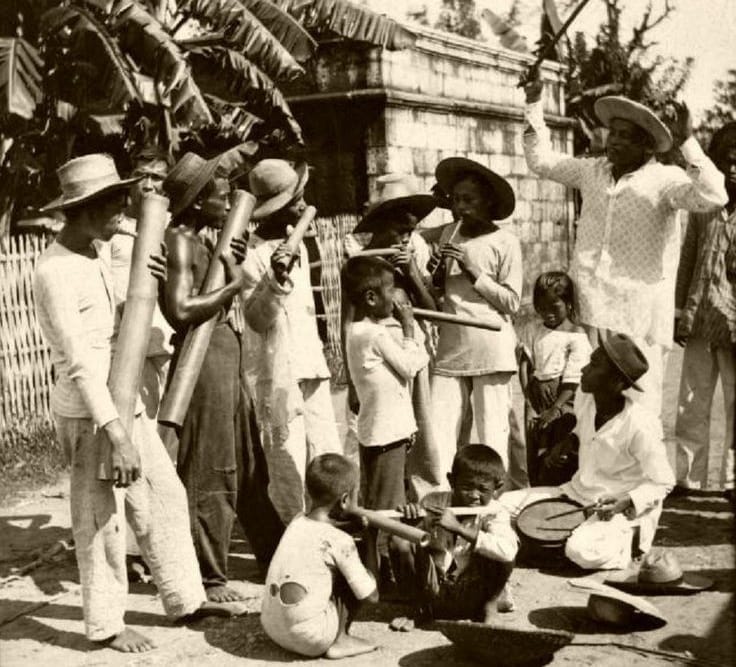
フィリピンの民衆美学の探求
音楽・言説・聖像
Philippines Popular
Aesthetics

Filipino Bamboo orchestra
☆ フィリピンの芸術(Arts in the Philippines)は、土着の芸術を含め、この国の文化に影響を与えた様々な芸術を反映している。フィリピンの芸術は、伝統 的な芸術[1]と非伝統的な芸術[2]の2つの分野から成り立っている。フィリピン政府の文化機関である文化芸術国民委員会は、フィリピンの芸術を伝統的 なものと非伝統的なものに分類している。各カテゴリーにはサブカテゴリーがある。
伝 統芸術:[1]
非伝統芸術:[2]
https://en.wikipedia.org/wiki/Arts_in_the_Philippines
 "Filipino Bamboo" is
a song that has become a beloved classic, initially composed in 1910.
Its enduring popularity stems from its catchy melody and meaningful
lyrics that resonate with listeners. The song's nostalgic charm
captures the essence of Filipino culture, celebrating natural beauty
and the simplicity of life. With references to bamboo, a symbol of
resilience and strength in Filipino culture, the song evokes a sense of
national pride and unity. Through its timeless appeal, "Filipino
Bamboo" continues to be treasured by generations, bridging the past
with the present in musical harmony. "Filipino Bamboo" is
a song that has become a beloved classic, initially composed in 1910.
Its enduring popularity stems from its catchy melody and meaningful
lyrics that resonate with listeners. The song's nostalgic charm
captures the essence of Filipino culture, celebrating natural beauty
and the simplicity of life. With references to bamboo, a symbol of
resilience and strength in Filipino culture, the song evokes a sense of
national pride and unity. Through its timeless appeal, "Filipino
Bamboo" continues to be treasured by generations, bridging the past
with the present in musical harmony.https://www.facebook.com/factsZero |
 「フィリピン・バンブー」は、1910年に作曲されて以来、愛され続け
ている名曲だ。その不朽の人気は、キャッチーなメロディーと、聴く人の心に響く意味深い歌詞に由来する。この曲のノスタルジックな魅力はフィリピン文化の
本質を捉えており、自然の美しさとシンプルな生活を賛美している。フィリピン文化における回復力と強さの象徴である竹を引用したこの曲は、国民の誇りと団
結の感覚を呼び起こす。時代を超越した魅力を持つ「Filipino
Bamboo」は、世代を超えて愛され続け、過去と現在を音楽のハーモニーで繋いでいる。 「フィリピン・バンブー」は、1910年に作曲されて以来、愛され続け
ている名曲だ。その不朽の人気は、キャッチーなメロディーと、聴く人の心に響く意味深い歌詞に由来する。この曲のノスタルジックな魅力はフィリピン文化の
本質を捉えており、自然の美しさとシンプルな生活を賛美している。フィリピン文化における回復力と強さの象徴である竹を引用したこの曲は、国民の誇りと団
結の感覚を呼び起こす。時代を超越した魅力を持つ「Filipino
Bamboo」は、世代を超えて愛され続け、過去と現在を音楽のハーモニーで繋いでいる。https://www.facebook.com/factsZero |
| The
culture of the Philippines
is characterized by cultural and ethnic diversity.[1] Although the
multiple ethnic groups of the Philippine archipelago have only recently
established a shared Filipino national identity,[2] their cultures were
all shaped by the geography and history of the region,[3][4] and by
centuries of interaction with neighboring cultures, and colonial
powers.[5][6] In more recent times, Filipino culture has also been
influenced through its participation in the global community.[7] |
フィ
リピンの文化は、文化的・民族的多様性を特徴としている[1]。フィリピン群島の複数の民族がフィリピン国民としてのアイデンティティを共有するように
なったのはごく最近のことだが[2]、その文化はすべて、この地域の地理や歴史[3][4]、近隣の文化や植民地支配国との何世紀にもわたる交流によって
形成されたものである[5][6]。さらに最近では、フィリピン文化は国際社会への参加によっても影響を受けている[7]。 |
| History Further information: History of the Philippines Among the contemporary ethnic groups of the Philippine archipelago, the Negritos are generally considered the earliest settlers;[8] today, although few in numbers, they preserve a very traditional way of life and culture. After those early settlers, the Austronesians arrived on the archipelago. The Austronesian culture is strongly evident in the ethnic majority and languages. Before the arrival of European colonizers in the 1500s, the various ethnic groups of the Philippines were organized into various independent polities,[5][6] which historians have come to call "barangays".[9][10][a] These polities consisted of about thirty to a hundred households,[2][9] and were ruled by leaders with titles.[2] The largest of these, such as Butuan, Tondo and the Sultanate of Sulu were complex political formations based on the deltas of the archipelago's biggest river systems, with political and trade relationships with polities further upstream on one hand, and with the political and trading powers of Maritime Southeast Asia and East Asia such as the Sultanate of Brunei, the Majapahit empire, the Qing and Ming Dynasties of China, and even Japan. Indirect cultural exchange and some trade also took place with the Indian subcontinent and Arabia.[11] The advent of Spanish colonial rule in the islands marked the beginning of the Philippines as an entity, a collection of Southeast Asian countries united under the Spanish Empire. The empire ruled, via the Viceroyalty of New Spain and later directly from Madrid (after 1821 Mexican independence), the islands between the 16th and 19th centuries (Batanes being one of the last places to be colonized in the mid-1800s), resulting in Christianity to spread and dominate throughout the archipelago and influenced the religion and beliefs of the natives. Then, the Philippines became a U.S. territory for almost 50 years. Influence from the United States is manifested in the wide use of the English language, media and in the modern culture and clothing of present-day Philippines.[12] |
歴史 さらに詳しい情報 フィリピンの歴史 フィリピン群島の現存する民族の中で、ネグリト人は一般的に最も早く入植した民族と考えられている[8]。今日、数は少ないものの、彼らは非常に伝統的な 生活様式と文化を保持している。これらの初期入植者の後、オーストロネシア人がこの諸島に到着した。オーストロネシア文化は、民族の多数派と言語に強く表 れている。 1500年代にヨーロッパの植民者が到着する以前は、フィリピンの様々な民族は、歴史家が「バランガイ」と呼ぶようになった様々な独立した政体[5] [6]に組織されていた[9][10][a]。これらの政体は約30から100世帯からなり[2][9]、称号を持つ指導者によって統治されていた。 [最大規模のブトゥアン、トンド、スールーのスルタン国などは、群島最大の河川のデルタ地帯を基盤にした複雑な政治形態であり、一方ではさらに上流の諸政 体との政治的・貿易的関係を持ち、またブルネイのスルタン国、マジャパヒト帝国、中国の清朝や明朝、さらには日本など、東南アジアや東アジア海域の政治 的・貿易的大国との関係を持っていた。インド亜大陸やアラビアとも間接的な文化交流や貿易が行われていた[11]。 スペインによるフィリピン植民地支配の開始は、スペイン帝国の下に統合された東南アジア諸国の集合体としてのフィリピンの始まりであった。帝国は16世紀 から19世紀にかけて、新スペイン総督府を経由し、後にマドリードから直接(1821年のメキシコ独立後)、島々を統治した(バタネス島は1800年代半 ばに植民地化された最後の場所のひとつである)。その後、フィリピンは50年近くアメリカ領となった。アメリカからの影響は、英語の幅広い使用やメディ ア、現在のフィリピンの近代的な文化や衣服に現れている[12]。 ︎▶先スペイン期のフィリピンの歴史︎▶︎︎フィリピンの歴史(スペイン支配期)▶フィリピン共和国の歴史(1899年以降)︎▶︎︎▶︎▶︎︎▶︎▶︎︎▶︎▶︎ |
| Geography and ethnic groups Main articles: Geography of the Philippines and Ethnic groups in the Philippines  Dominant ethnic groups by province. The Philippines' culture is shaped by its archipelagic geography, topography and physical location within Maritime Southeast Asia, all of which defined the cultural histories of the country's 175 Ethnolinguistic groups.[3][4][13]: 68 Influence of geography The cultural diversity of the Philippines is the result of the country's archipelagic nature. The Philippines, as the world's fifth largest island country,[14] is one of the five original archipelagic states recognized under the United Nations Convention on the Law of the Sea (UNCLOS).[15] Its 7,641 islands[18] have a total land area of 300,000 square kilometers (115,831 sq mi);[19][20] its exclusive economic zone—covering an area 200 nautical miles (370 km) from its islands' shores—encompasses 2,263,816 square kilometers (874,064 sq mi) of sea.[21] Maritime and river transport allowed cultural exchanges between the country's diverse ethnic groups who settled on various islands within the archipelago; inland mountain ranges, on the other hand, were a major hindrance to cultural linkages between various groups.[2] Ethnic groups of the Philippines The Philippines is inhabited by more than 182 ethnolinguistic groups,[22]: 5 many of which are classified as "Indigenous Peoples" under the country's Indigenous Peoples' Rights Act of 1997. Traditionally-Muslim peoples from the southernmost island group of Mindanao are usually categorized together as Moro peoples, whether they are classified as Indigenous peoples or not. About 142 are classified as non-Muslim Indigenous People groups, and about 19 ethnolinguistic groups are classified as neither indigenous nor moro.[22]: 6 Various migrant groups have also had a significant presence throughout the country's history. The Muslim-majority ethnic groups ethnolinguistic groups of Mindanao, Sulu, and Palawan are collectively referred to as the Moro people,[23] a broad category which includes some indigenous people groups and some non-indigenous people groups.[22]: 6 About 142 of the Philippines' Indigenous People groups are not classified as moro peoples.[22]: 6 Some of these people groups are commonly grouped together due to their strongly association with a shared geographic area, although these broad categorizations are not always welcomed by the ethnic groups themselves.[24][25][26] For example, the indigenous peoples of the Cordillera Mountain Range in northern Luzon have often been referred to using the exonym[24] "Igorot people," and as the Cordilleran peoples.[24] Meanwhile, the non-Moro peoples of Mindanao are collectively referred to as the Lumad, a collective autonym conceived in 1986 as a way to distinguish them from their neighboring indigenous Moro neighbors.[27] About 86 to 87 percent of the Philippine population belong to the 19 ethnolinguistic groups are classified as neither indigenous nor moro.[22]: 6 known simply as Filipinos, these groups are sometimes collectively referred to as "Lowland Christianized groups" to distinguish them from the other ethnolinguistic groups.[28] The most populous of these groups, with populations exceeding a million individuals, are the Ilocano, the Pangasinense, the Kapampangan, the Tagalog, the Ivatan, the Cuyonon, the Bicolano, the Visayans (Cebuanos, Boholano, the Hiligaynon/Ilonggo, and Waray) and many more.[22]: 16 These groups converted to Christianity and was part of the Spanish empire,[citation needed] particularly both the native and migrant lowland-coastal groups,[29] and adopted foreign elements of culture throughout the country's history.[citation needed] Due to the history of the Philippines since the Spanish colonial era, there are also some historical migrant heritage groups within the lowland Filipino populations such as the Chinese Filipinos and Spanish Filipinos, both of whom intermixed with the above lowland Austronesian-speaking ethnic groups, which produced Filipino Mestizos. These groups also comprise and contribute a considerable proportion of the country's population,[30] especially its bourgeois,[31] and economy[31][32][33][34] and were integral to the establishment of the country,[29] from the rise of Filipino nationalism by the Ilustrado intelligentsia to the Philippine Revolution.[35] Other peoples of migrant and/or mixed descent include those such as, American Filipinos, Indian Filipinos,[36] Japanese Filipinos,[37] and many more. Indigenous peoples 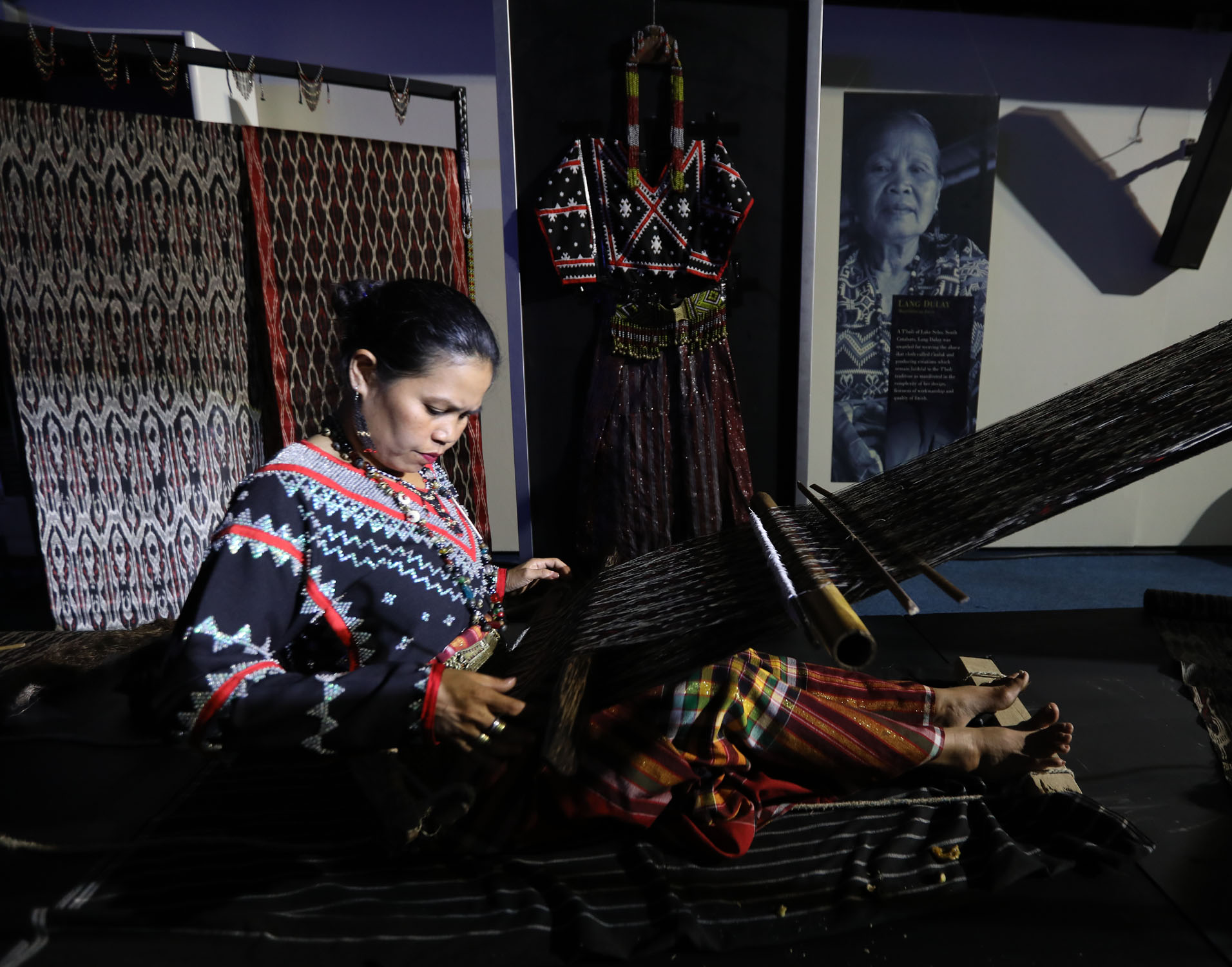 A Tboli woman weaving t'nalak from South Cotabato. These paragraphs are an excerpt from Indigenous peoples of the Philippines.[edit] The indigenous peoples of the Philippines are ethnolinguistic groups or subgroups that maintain partial isolation or independence throughout the colonial era, and have retained much of their traditional pre-colonial culture and practices.[38] The Philippines has 110 enthnolinguistic groups comprising the Philippines' indigenous peoples; as of 2010, these groups numbered at around 14–17 million persons.[39] Austronesians make up the overwhelming majority, while full or partial Negritos scattered throughout the archipelago. The highland Austronesians and Negrito have co-existed with their lowland Austronesian kin and neighbor groups for thousands of years in the Philippine archipelago. Culturally-indigenous peoples of northern Philippine highlands can be grouped into the Igorot (comprising many different groups) and singular Bugkalot groups, while the non-Muslim culturally-indigenous groups of mainland Mindanao are collectively called Lumad. Australo-Melanesian groups throughout the archipelago are termed Aeta, Ita, Ati, Dumagat, among others. Numerous culturally-indigenous groups also live outside these two indigenous corridors.[40] In addition to these labels, groups and individuals sometimes identify with the Tagalog term katutubo, which denotes any person of indigenous origin.[41][42][43] According to the Komisyon sa Wikang Filipino, there are 135 recognized local indigenous Austronesian languages in the Philippines, of which one (Tagalog) is vehicular and each of the remaining 134 is vernacular.[citation needed] |
地理と民族 主な記事 フィリピンの地理、フィリピンの民族  フィリピンの主な民族 フィリピンの文化は、その群島的な地理、地形、東南アジア海域の物理的な位置によって形成されており、これらすべてがフィリピンの175の民族言語グルー プの文化的な歴史を決定づけた[3][4][13]: 68 地理の影響 フィリピンの文化的多様性は、この国の群島的性質の結果である。フィリピンは世界で5番目に大きな島国であり[14]、国連海洋法条約(UNCLOS)で 認められた5つの群島国家のひとつである。 [15]7,641の島々[18]の総陸地面積は300,000平方キロメートル(115,831平方マイル)[19][20]であり、排他的経済水域は 島々の海岸から200海里(370キロメートル)をカバーし、2,263,816平方キロメートル(874,064平方マイル)の海域に及ぶ。 [21]海運と河川運輸は、群島内の様々な島に定住する国内の多様な民族間の文化交流を可能にしたが、一方で内陸の山脈は、様々な民族間の文化的つながり を妨げる大きな障害となった[2]。 フィリピンの民族 フィリピンには182以上の民族が居住している[22]: その多くは、1997年に制定された先住民族の権利に関する法律の下で「先住民族」に分類され ている。ミンダナオ島の最南端に位置する島々に住む伝統的にイスラム教を信仰する民族は、先住民族に分類されるか否かにかかわらず、通常モロ民族に分類さ れる。約142が非イスラム系先住民族グループとして分類され、約19の民族言語グループが先住民族でもモロ族でもないと分類されている[22]。 ミンダナオ、スールー、パラワンのイスラム教徒が多数を占める民族グループの民族言語集団はモロ族と総称され[23]、先住民族グループと非先住民族グ ループを含む広義のカテゴリーである[22]: 6。 フィリピンの先住民族のうち約142のグループはモロ民族として分類されていない[22]: 6 これらの民族グループの一部は、共有する地理的地域と強く結びついているため、一般的にひとまとめにされているが、こうした大まかな分類は民族グループ自 身には必ずしも歓迎されていない。 [24][25][26]例えば、ルソン島北部のコーディリエラ山脈の先住民族は、しばしば「イゴロット族」という外来語[24]を用い、コーディリエラ 民族と呼ばれてきた[24]。一方、ミンダナオ島の非モロ民族は、近隣の先住民族であるモロ族と区別する方法として1986年に考案された総称であるルマ ド族と総称されている[27]。 フィリピンの人口の約86~87パーセントは、先住民族でもモロ族でもない19の民族言語集団に属している[22]。単にフィリピン人として知られるこれ らの集団は、他の民族言語集団と区別するために「低地キリスト教化集団」と総称されることもある。 [28] これらの集団の中で最も人口が多く、100万人を超える人口を持つのは、イロカノ人、パンガシネンセ人、カパンパンガン人、タガログ人、イヴァタン人、ク ヨノン人、ビコラノ人、ビサヤ人(セブアノ人、ボホラノ人、ヒリガイノン人/イロンゴ人、ワライ人)などである[22]: 16 これらのグループはキリスト教に改宗し、スペイン帝国の一部となり[要出典]、特に低地沿岸部の先住民グループと移民グループの両方が[29]、国の歴史 を通じて外国文化の要素を取り入れた[要出典]。 スペイン植民地時代からのフィリピンの歴史により、低地フィリピン人集団の中にも中国系フィリピン人やスペイン系フィリピン人などの歴史的移民遺産集団が 存在し、両者は上記の低地オーストロネシア語を話す民族集団と混血し、フィリピンのメスティーソを生み出した。これらの集団はまた、国民[30]、特にブ ルジョワ[31]、経済[31][32][33][34]のかなりの割合を構成し、貢献しており、イルストラード知識階級によるフィリピン・ナショナリズ ムの台頭からフィリピン革命[35]に至るまで、国の成立に不可欠な存在であった[29]。移民系および/または混血系には他に、アメリカ系フィリピン 人、インド系フィリピン人[36]、日系フィリピン人[37]など、多くの民族が含まれる。 先住民族  南コタバトでトナラクを織るトボリの女性。 これらのパラグラフはフィリピンの先住民[編集]からの抜粋である。 フィリピンの先住民族は、植民地時代を通じて部分的な孤立または独立を維持し、植民地時代以前の伝統的な文化や慣習の多くを保持している民族言語集団また は小集団である[38]。 フィリピンには、フィリピンの先住民族を構成する110の民族言語集団があり、2010年現在、これらの集団の人口は約1,400万人から1,700万人 である[39]。オーストロネシア人が圧倒的多数を占め、ネグリト人が全体的または部分的に群島全体に散在している。高地のオーストロネシア人とネグリト 人は、低地のオーストロネシア人の親族や近隣のグループとフィリピン諸島で数千年にわたって共存してきた。 フィリピン北部高地の文化的先住民族は、イゴロット族(多くの異なるグループから成る)と特異なブガロット族に分類され、ミンダナオ島本土の非イスラム系 文化的先住民族はルマド族と総称される。また、ミンダナオ島本土の非イスラム系文化的先住民族を総称してルマド(Lumad)と呼ぶ。これらの2つの先住 民の回廊の外側にも、多数の文化的先住民集団が居住している[40]。これらのレッテルに加えて、集団や個人は、先住民出身者を示すタガログ語のカトゥ トゥボ(katutubo)という用語を用いることもある[41][42][43]。 Komisyon sa Wikang Filipinoによれば、フィリピンには135のオーストロネシア系現地土着言語が認められており、そのうち1つ(タガログ語)は車両言語であり、残り の134はそれぞれ現地語である[要出典]。 |
| Filipino psychology Main article: Filipino psychology A formal field interpreting Psychology as rooted on the experience, ideas, and cultural orientation of the Filipinos, called Filipino psychology, was established in 1975.[44] Values Main article: Filipino values As a general description, the distinct value system of Filipinos is rooted primarily in personal alliance systems, especially those based in kinship, obligation, friendship, religion (particularly Christianity), and commercial relationships.[45] Filipino values are, for the most part, centered around maintaining social harmony, motivated primarily by the desire to be accepted within a group.[46] The main sanction against diverging from these values are the concepts of "Hiya", roughly translated as 'a sense of shame', and "Amor propio" or 'self-esteem'.[46] Social approval, acceptance by a group, and belonging to a group are major concerns. Caring about what others will think, say or do, are strong influences on social behavior among Filipinos.[47] Other elements of the Filipino value system are optimism about the future, pessimism about present situations and events, concern and care for other people, the existence of friendship and friendliness, the habit of being hospitable, religious nature, respectfulness to self and others, respect for the female members of society, the fear of God, and abhorrence of acts of cheating people financially and thievery.[48] |
フィリピン心理学 主な記事 フィリピン心理学 1975年にフィリピン心理学と呼ばれる、フィリピン人の経験、考え方、文化的指向に根ざした心理学を解釈する正式な分野が設立された[44]。 価値観 主な記事 フィリピン人の価値観 一般的な説明として、フィリピン人の明確な価値観は、主に個人的な同盟システム、特に親族関係、義務、友情、宗教(特にキリスト教)、商業関係に基づくも のに根ざしている[45]。 フィリピン人の価値観の大部分は、社会的調和を維持することを中心としており、主に集団の中で受け入れられたいという願望が動機となっている[46]。こ れらの価値観から逸脱することに対する主な制裁は、「恥の感覚」と大雑把に訳される「ヒヤ」と「アモール・プロピオ」または「自尊心」という概念である [46]。社会的承認、集団からの受容、集団への帰属が大きな関心事である。他人が何を考え、何を言い、何をするかを気にすることは、フィリピン人の社会 的行動に強い影響を与えている[47]。 フィリピン人の価値観の他の要素としては、未来に対する楽観主義、現在の状況や出来事に対する悲観主義、他人に対する関心や気遣い、友情と親しみの存在、 もてなす習慣、宗教性、自己と他者に対する敬意、社会の女性構成員に対する敬意、神への恐れ、金銭的に人をだます行為や泥棒行為に対する嫌悪などがある [48]。 |
| Arts Main article: Art of the Philippines Architecture Main article: Architecture of the Philippines See also: Nipa hut, Ancestral houses of the Philippines, and Earthquake Baroque  Bahay na bato, a traditional Filipino house Before the arrival of European colonizers, Austronesian architecture was the common form of housing on the archipelago.[citation needed] During the Spanish era, the new Christianized lowland culture collectively evolved a new style known as the Nipa hut (Bahay Kubo). It is characterized by use of simple materials such as bamboo and coconut as the main sources of wood. Cogon grass, Nipa palm leaves and coconut fronds are used as roof thatching. Most primitive homes are built on stilts due to frequent flooding during the rainy seasons. Regional variations include the use of thicker, and denser roof thatching in mountain areas, or longer stilts on coastal areas particularly if the structure is built over water. The architecture of other indigenous peoples may be characterized by an angular wooden roofs, bamboo in place of leafy thatching and ornate wooden carvings. The Bahay na bato architecture is a variant of Nipa Hut that emerged during the Spanish era.[49] Spanish architecture has left an imprint in the Philippines in the way many towns were designed around a central square or plaza mayor, but many of the buildings bearing its influence were demolished during World War II.[50] Some examples remain, mainly among the country's churches, government buildings, and universities. Four Philippine baroque churches are included in the list of UNESCO World Heritage Sites: the San Agustín Church in Manila, Paoay Church in Ilocos Norte, Nuestra Señora de la Asunción (Santa María) Church in Ilocos Sur, and Santo Tomás de Villanueva Church in Iloilo.[51] Vigan in Ilocos Sur is also known for the many Hispanic-style houses and buildings preserved there.[52] The introduction of Christianity brought European churches and architecture which subsequently became the center of most towns and cities in the nation. The Spaniards also introduced stones and rocks as housing and building materials and the Filipinos merged it with their existing architecture and forms a hybrid mix-architecture only exclusive to the Philippines. Filipino colonial architecture can still be seen in centuries-old buildings such as Filipino baroque churches, Bahay na bato; houses, schools, convents, government buildings around the nation. The best collection of Spanish colonial era architecture can be found in the walled city of Intramuros in Manila and in the historic town of Vigan. Colonial-era churches are also on the best examples and legacies of Spanish Baroque architecture called Earthquake Baroque which are only found in the Philippines. Historic provinces such as Ilocos Norte and Ilocos Sur, Pangasinan, Pampanga, Bulacan, Cavite, Laguna, Rizal, Batangas, Quezon, Iloilo, Negros, Cebu, Bohol and Zamboanga del Sur also boasts colonial-era buildings. The American occupation in 1898 introduced a new breed of architectural structures in the Philippines. This led to the construction of government buildings and Art Deco theaters. During the American period, some semblance of city planning using the architectural designs and master plans by Daniel Burnham was done on the portions of the city of Manila. Part of the Burnham plan was the construction of government buildings that resembled Greek or Neoclassical architecture.[53] In Iloilo, a lot of the colonial edifices constructed during the American occupation in the country can still be seen. Commercial buildings, houses and churches in that era are abundant in the city and especially in Calle Real.[54] The University of Santo Tomas Main Building in Manila is an example of Renaissance Revival architecture. The building was built in 1924 and was completed at 1927. The building, designed by Fr. Roque Ruaño, O.P., is the first earthquake-resistant building in the Philippines that is not a church[citation needed].[55] Islamic and other Asian architecture can also be seen depicted on buildings such as mosques and temples. Pre-Hispanic housing is still common in rural areas. Contemporary-style housing subdivisions and suburban-gated communities are popular in urbanized places such as Metro Manila, Central Visayas, Central Luzon, Negros Island and other prosperous regions. However, certain areas of the country like Batanes have slight differences as both Spanish and Filipino ways of architecture assimilated differently due to the climate. Limestones and coral were used as building materials.[56]  Kalesa, a traditional Philippine urban transportation, in front of Manila Cathedral entrance There have been proposals to establish a policy where each municipality and city will have an ordinance mandating all constructions and reconstructions within such territory to be inclined with the municipality or city's architecture and landscaping styles to preserve and conserve the country's dying heritage sites, which have been demolished one at a time in a fast pace due to urbanization, culturally-irresponsible development, and lack of towns-cape architectural vision. The proposal advocates for the usage and reinterpretations of indigenous, colonial, and modern architectural and landscaping styles that are prevalent or used to be prevalent in a given city or municipality. The proposal aims to foster a renaissance in Philippine landscaping and townscaping, especially in rural areas which can easily be transformed into new architectural heritage towns within a 50-year time frame. Unfortunately, many Philippine-based architecture and engineering experts lack the sense of preserving heritage townscapes,[citation needed] such as the case in Manila, where business proposals to construct structures that are not inclined with Manila's architectural styles have been continuously accepted and constructed by such experts, effectively destroying Manila's architectural townscape one building at a time. Only the city of Vigan has passed such an ordinance, which led to its declaration as a UNESCO World Heritage Site in 1999 and awarding of various recognition for the conservation and preservation of its unique architectural and landscaping styles. In 2016, bills proposing to establish a Department of Culture were filed in both chambers of Congress to help formulate policy on architecture.[57][58] 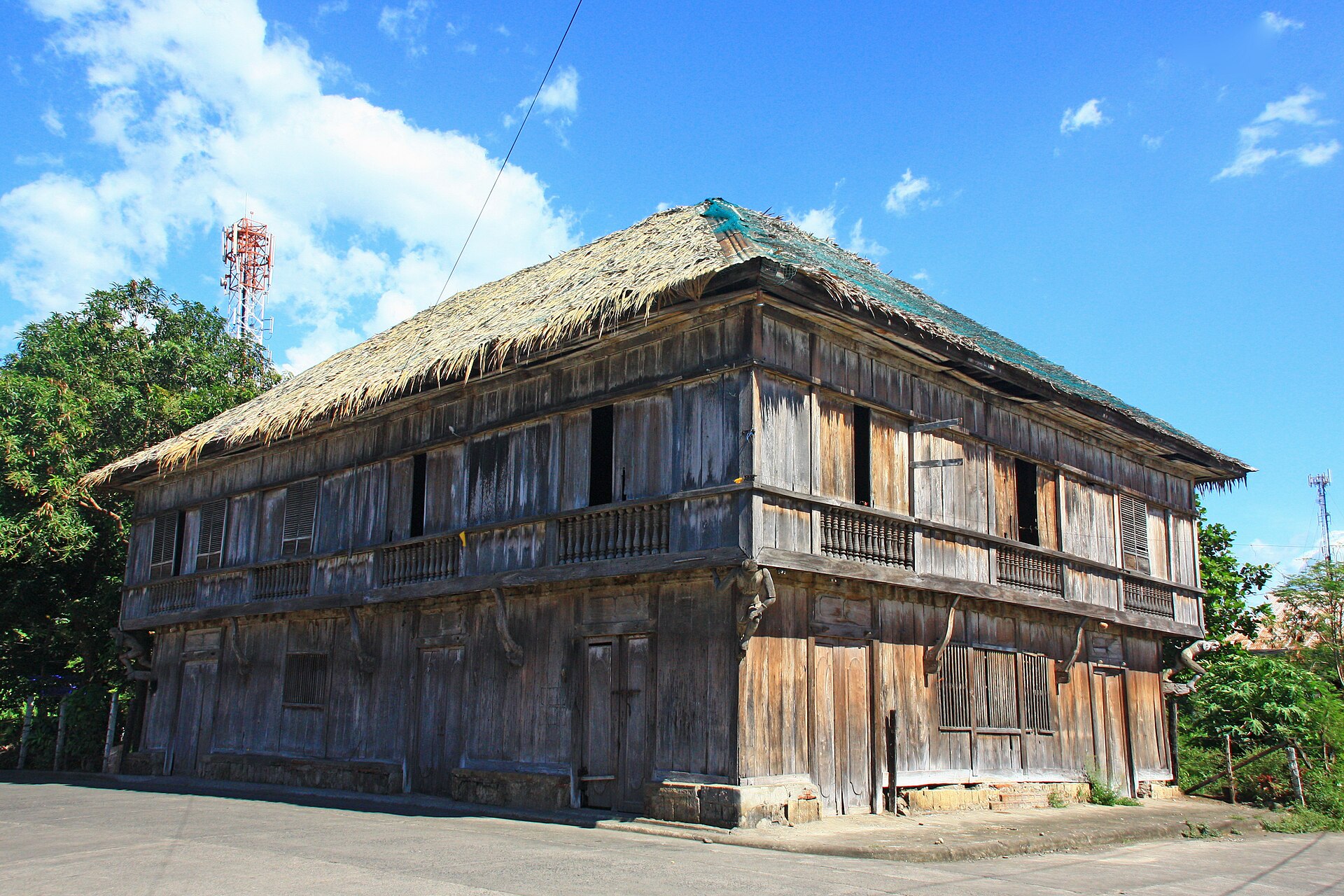 Vega Ancestral House, Misamis Oriental  Vigan City in Ilocos Sur  Aguinaldo Shrine in Cavite 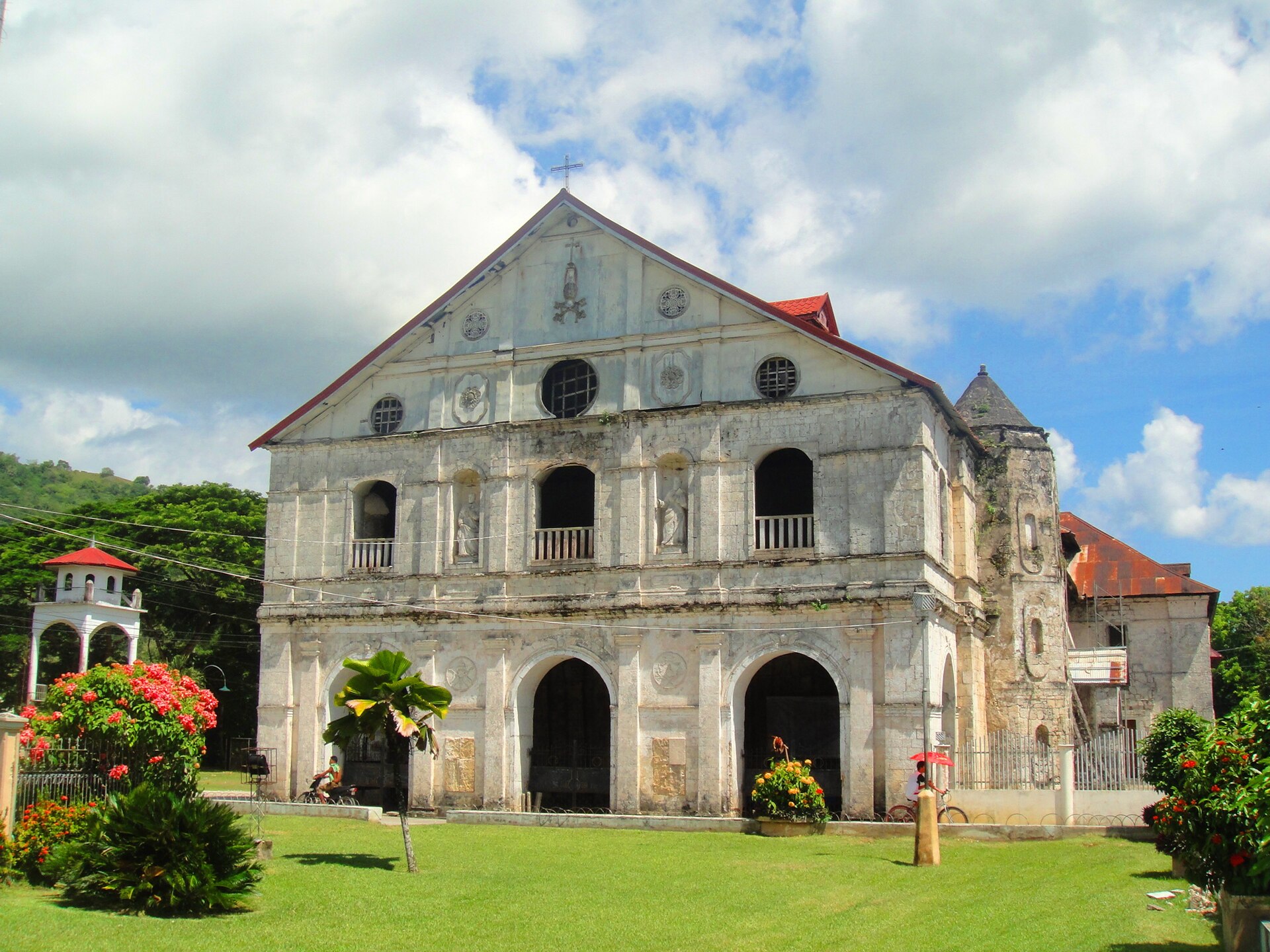 Loboc Church in Bohol 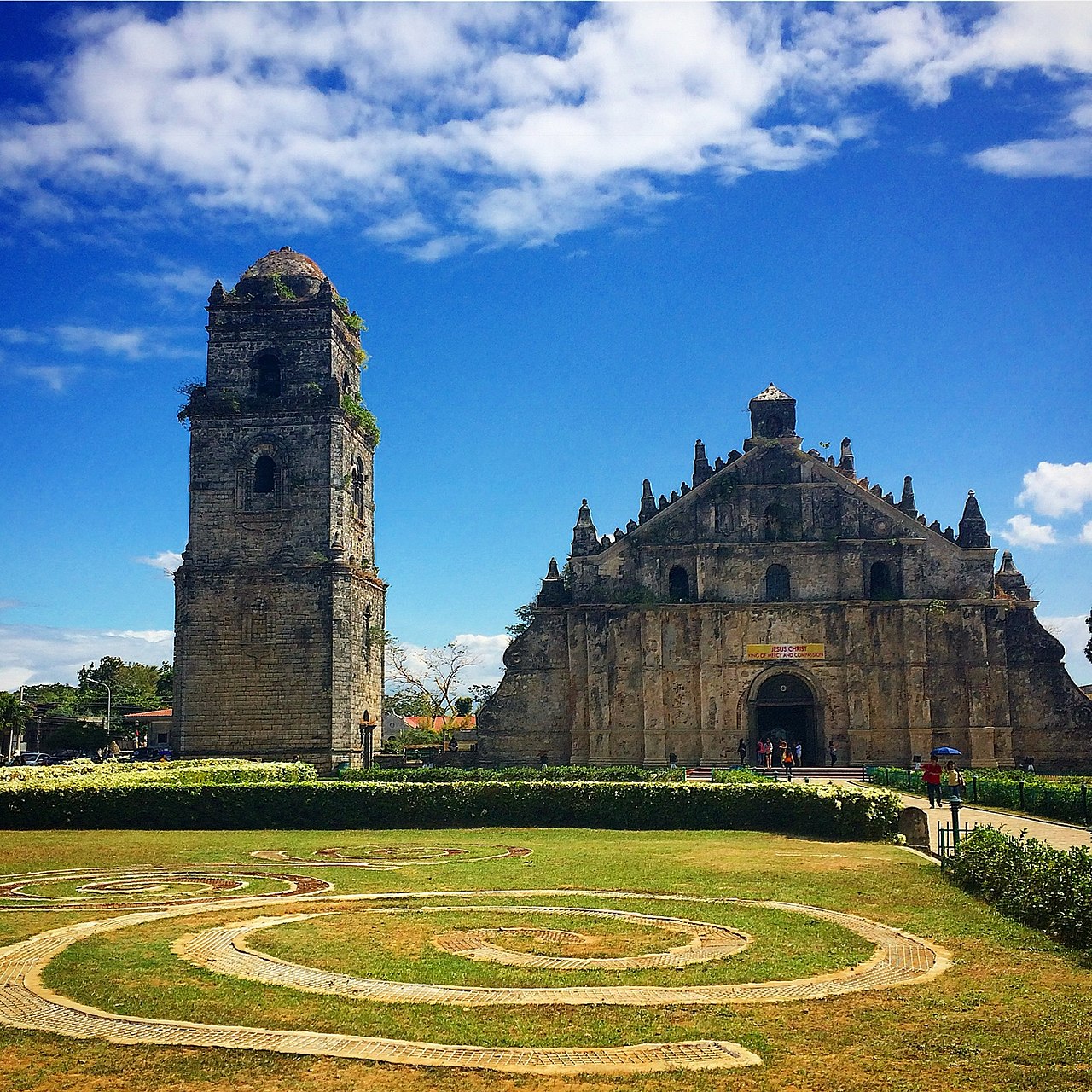 Paoay Church in Ilocos Norte  Museum Agrifina Circle |
芸術 主な記事 フィリピンの芸術 建築 主な記事 フィリピンの建築 以下も参照のこと: ニッパ小屋、フィリピンの先祖代々の家、地震バロックも参照のこと。  バハイ・ナ・バト、フィリピンの伝統的な家屋 ヨーロッパからの植民者が到来する以前は、オーストロネシア建築がフィリピン諸島の一般的な住居形態であった[要出典]。 スペイン統治時代、キリスト教化された新しい低地文化は、ニッパ小屋(バハイ・クボ)として知られる新しい様式を集団的に進化させた。主な木材源として竹 やココナッツといったシンプルな素材を使用するのが特徴である。屋根葺きにはコゴン草、ニパ椰子の葉、ココナッツの葉が使われる。雨季には頻繁に洪水に見 舞われるため、ほとんどの原始的な家は高床式である。地域によって、山間部では厚く密度の高い屋根葺き材を使用したり、沿岸部では特に水上に建てられる場 合、より長い高床式屋根を使用したりする。他の先住民族の建築は、角ばった木造屋根、葉の葺き替えの代わりに竹、華麗な木彫りなどが特徴である。バハイ・ ナ・バト建築は、スペイン統治時代に出現したニッパ小屋の変形である[49]。 スペイン建築は、多くの町が中央の広場やマヨール広場を囲むように設計されたことで、フィリピンにその痕跡を残したが、その影響を受けた建物の多くは第二 次世界大戦中に取り壊された[50]。マニラのサン・アグスティン教会、イロコスノルテのパオアイ教会、イロコススールのヌエストラ・セニョーラ・デ・ ラ・アスンシオン(サンタ・マリア)教会、イロイロのサント・トマス・デ・ビジャヌエバ教会である。 [51]イロコススールのビガンは、多くのヒスパニック様式の家屋や建物が保存されていることでも知られている[52]。キリスト教の導入は、ヨーロッパ の教会や建築をもたらし、その後、国民のほとんどの町や都市の中心となった。スペイン人はまた、住宅や建築材料として石や岩を持ち込んだが、フィリピン人 はそれを既存の建築と融合させ、フィリピンだけのハイブリッドな混合建築を形成した。フィリピン・コロニアル建築は、フィリピン・バロック様式の教会、バ ハイ・ナ・バト、住宅、学校、修道院、政府庁舎など、何世紀も前に建てられた建物として今でも国民に見ることができる。スペイン植民地時代の建築が最もよ く残っているのは、マニラの城壁都市イントラムロスと歴史的な町ビガンである。コロニアル時代の教会はまた、地震バロックと呼ばれるスペイン・バロック建 築の最良の例であり遺産であり、フィリピンでしか見られない。イロコスノルテ州、イロコスサー州、パンガシナン州、パンパンガ州、ブラカン州、カビテ州、 ラグナ州、リサール州、バタンガス州、ケソン州、イロイロ州、ネグロス州、セブ州、ボホール州、サンボアンガ・デル・スール州などの歴史的な州も、植民地 時代の建物を誇っている。 1898年のアメリカ占領により、フィリピンには新しい建築様式が導入された。これにより、政府庁舎やアール・デコ様式の劇場が建設された。アメリカ統治 時代には、ダニエル・バーナムの建築デザインとマスタープランを用いた都市計画がマニラ市の一部で行われた。バーナム計画の一部は、ギリシャ建築や新古典 主義建築に似た政府庁舎の建設であった[53]。イロイロでは、アメリカ統治時代に建設された植民地時代の建造物の多くを今でも見ることができる。当時の 商業ビル、住宅、教会が市内、特にレアル通りに多く見られる[54]。 マニラのサント・トーマス大学本館はルネサンス・リバイバル建築の一例である。この建物は1924年に建設され、1927年に完成した。ロケ・ルアーニョ 神父(O.P.)の設計によるこの建物は、教会ではないフィリピン初の耐震建築物である[要出典]。地方では、先ヒスパニック時代の住宅がまだ一般的であ る。メトロ・マニラ、セントラル・ビサヤ、セントラル・ルソン、ネグロス島などの都市化された地域では、現代的なスタイルの分譲住宅や郊外のゲーテッド・ コミュニティが普及している。 しかし、バタネスのような特定の地域は、スペインとフィリピンの建築様式が気候によって同化したため、若干の違いがある。建築材料には石灰岩とサンゴが使 われた[56]。  フィリピンの伝統的な都市交通手段であるカレサ(マニラ大聖堂入口前) 都市化、文化的に無責任な開発、町並み建築のビジョンの欠如のため、速いペースで次々と取り壊されてきたフィリピンの滅びゆく遺産を保護・保全するため、 各自治体や都市が、その領域内のすべての建築や再建築を、自治体や都市の建築様式や景観様式に沿ったものにすることを義務付ける条例を制定する政策が提案 されている。この提案は、特定の都市や自治体で普及している、あるいはかつて普及していた、土着的、植民地的、近代的な建築様式や景観様式を利用し、再解 釈することを提唱するものである。この提案は、フィリピンの造園と町並みのルネッサンスを促進することを目的としており、特に農村部では、50年という時 間枠の中で、新しい建築遺産の町へと容易に変貌させることができる。残念なことに、フィリピンの建築や工学の専門家の多くは、遺産となる町並みを保存する という感覚に欠けており[要出典]、例えばマニラでは、マニラの建築様式にそぐわない建築物を建設するという事業提案が、そのような専門家によって受け入 れられ、建設され続けてきた。ビガン市だけがこのような条例を制定し、1999年にユネスコ世界遺産に登録され、その独特な建築様式や景観の保存と保全に 対して様々な表彰を受けるに至った。2016年には、建築に関する政策を策定するための文化省の設置を提案する法案が両議会に提出された[57] [58]。  Vega Ancestral House, Misamis Oriental  Vigan City in Ilocos Sur  Aguinaldo Shrine in Cavite  Loboc Church in Bohol  Paoay Church in Ilocos Norte  Museum Agrifina Circle |
| Dancing Main article: Philippine dance 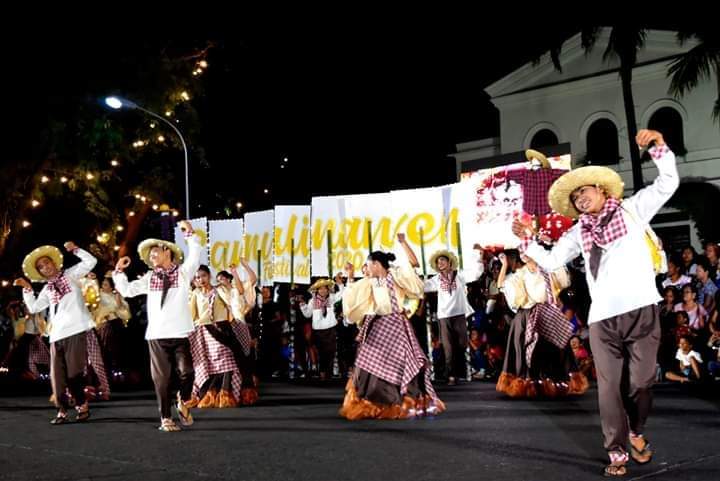 Filipino traditional dance at a festival Philippine folk dances include the Tinikling and Cariñosa. In the southern region of Mindanao, Singkil is a popular dance showcasing the story of a prince and princess in the forest. Bamboo poles are arranged in a tic-tac-toe pattern in which the dancers exploit every position of these clashing poles.[62][63] Music Main article: Music in the Philippines  Harana (serenade) The early music of the Philippines featured a mixture of Indigenous, Islamic and a variety of Asian sounds that flourished before the European and American colonization in the 16th and 20th centuries. Spanish settlers and Filipinos played a variety of musical instruments, including flutes, guitar, ukulele, violin, trumpets and drums. They performed songs and dances to celebrate festive occasions. By the 21st century, many of the folk songs and dances have remained intact throughout the Philippines. Some of the groups that perform these folk songs and dances are the Bayanihan, Filipinescas, Barangay-Barrio, Hariraya, the Karilagan Ensemble, and groups associated with the guilds of Manila, and Fort Santiago theatres. Many Filipino musicians have risen prominence such as the composer and conductor Antonio J. Molina, the composer Felipe P. de Leon, known for his nationalistic themes and the opera singer Jovita Fuentes. Modern day Philippine music features several styles. Most music genres are contemporary such as Filipino rock, Filipino hip hop and other musical styles. Some are traditional such as Filipino folk music. Literature Main article: Literature of the Philippines 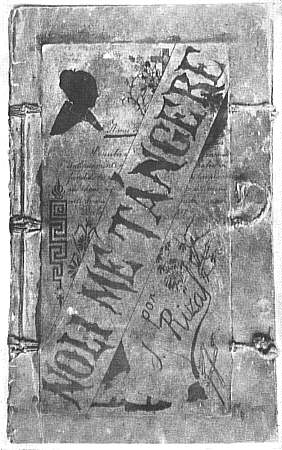 Noli Me Tángere (novel) The Philippine literature is a diverse and rich group of works that has evolved throughout the centuries. It had started with traditional folktales and legends made by the ancient Filipinos before Spanish colonization. The main themes of Philippine literature focus on the country's pre-Hispanic cultural traditions and the socio-political histories of its colonial and contemporary traditions. The literature of the Philippines illustrates the Prehistory and European colonial legacy of the Philippines, written in both Indigenous and Hispanic writing system. Most of the traditional literatures of the Philippines were written during the Spanish period, while being preserved orally prior to Spanish colonization. Philippine literature is written in Spanish, English, or any indigenous Philippine languages. Some well known works of literature were created in the 17th to 19th centuries. The Ibong Adarna is a famous epic about a magical bird which was claimed to be written by José de la Cruz or "Huseng Sisiw".[64] Francisco Balagtas is one of the country's prominent Filipino poets, he is named as one of the greatest Filipino literary laureates for his contributions in Philippine literature. His greatest work, the Florante at Laura is considered as his greatest work and one of the masterpieces of Philippine literature. Balagtas wrote the epic during his imprisonment.[65] José Rizal, the national hero of the country, wrote the novels Noli Me Tángere (Touch Me Not) and El Filibusterismo (The Filibustering, also known as The Reign of Greed). Nínay By Pedro Paterno, explores the tragic life of a female protagonist Ninay. There have been proposals to revive all indigenous ethnic scripts or suyat in the Philippines, where the ethnic script of the ethnic majority of the student population shall be taught in public and private schools. The proposal came up after major backlash came about when a bill declaring the Tagalog baybayin as the national script of the country. The bill became controversial as it focuses only on the traditional script of the Tagalog people, while dismissing the traditional scripts of more than 100 ethnic groups in the country. The new proposal that came after the backlash cites that if the ethnic majority is Sebwano, then the script that will be taught is badlit. If the ethnic majority is Tagalog, then the script that will be taught is baybayin. If the ethnic majority is Hanunuo Mangyan, then the script that will be taught is hanunu'o, and so on.[66] Cinema and media Main article: Cinema of the Philippines Salón de Pertierra was the first introduced moving picture on January 1, 1897, in the Philippines. All films were all in Spanish since Philippine cinema was first introduced during the final years of the Spanish era of the country. Antonio Ramos was the first known movie producer. He used the Lumiere Cinematograph when he filmed Panorama de Manila (Manila landscape), Fiesta de Quiapo (Quiapo Fiesta), Puente de España (Bridge of Spain), and Escenas Callejeras (Street scenes). Meanwhile, Jose Nepomuceno was dubbed as the "Father of Philippine Cinema".[67] Dubbed as the "Father of Philippine Cinema", his work marked the start of cinema as an art form in the Philippines.[68] His first film produced was entitled Dalagang Bukid (Country Maiden) in 1919. Film showing resumed in 1900 during the American period. Walgrah, a British entrepreneur, opened the Cine Walgrah at No. 60 Calle Santa Rosa in Intramuros. It was also during this time that a movie market was formally created in the country along with the arrival of silent movies. These silent films were always accompanied by gramophone, a piano, a quartet, or a 200-man choir. During the Japanese occupation, filmmaking was put on hold. Nonetheless, it was continued on 1930s up until 1945 replacing the Hollywood market with Japanese films but met with little success. Postwar 1940s and the 1950s were known as the first golden age of Philippine cinema with the resurgence of mostly Visayan films through Lapu-Lapu Pictures. Nationalistic films became popular, and movie themes consisting primarily of war and heroism and proved to be successful with Philippine audiences.[citation needed] 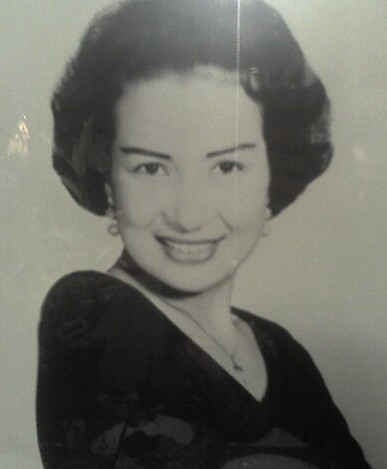 Mila del Sol starred in one of the earliest Filipino movies, Giliw Ko (1939), along with Fernando Poe Sr. The 1950s saw the first golden age of Philippine cinema,[69][70] with the emergence of more artistic and mature films, and significant improvement in cinematic techniques among filmmakers. The studio system produced frenetic activity in the Philippine film industry as many films were made annually and several local talents started to gain recognition abroad. Award-winning filmmakers and actors were first introduced during this period. As the decade drew to a close, the studio system monopoly came under siege as a result of labor-management conflicts. During the 1960s, James Bond movies, bomba (soft porn) pictures and an era of musical films, produced mostly by Sampaguita Pictures, dominated the cinema. The second golden age occurred from the 1970s to early 1980s. It was during this era that filmmakers ceased to produce pictures in black and white. A rise in Hollywood films dominated theater sales during the late 1980s until the 2000s.[71] The dawn of this era saw a dramatic decline of the mainstream Philippine movie industry.[72] The 1970s and 1980s were considered turbulent years for the Philippine film industry, bringing both positive and negative changes. The films in this period dealt with more serious topics following the Martial law era. In addition, action, western, drama, adult and comedy films developed further in picture quality, sound and writing. The 1980s brought the arrival of alternative or independent cinema in the Philippines.[citation needed] The 1990s saw the emerging popularity of drama, teen-oriented romantic comedy, adult, comedy and action films.[70] The mid-2010s also saw broader commercial success of films produced by independent studios.[73][74] The Philippines, being one of Asia's earliest film industry producers, remains undisputed in terms of the highest level of theater admission in Asia. Over the years, however, the Philippine film industry has registered a steady decline in movie viewership from 131 million in 1996 to 63 million in 2004.[75][71] From a high production rate of 350 films a year in the 1950s, and 200 films a year during the 1980s, the Philippine film industry production rate declined in 2006 to 2007.[75][71] The 21st century saw the rebirth of independent filmmaking through the use of digital technology and a number of films have once again earned nationwide recognition and prestige. With the high rates of film production in the past, several movie artists have appeared in over 100+ roles in Philippine Cinema and enjoyed great recognition from fans and moviegoers. Protest art Further information: Propaganda Movement and Protest art against the Marcos dictatorship Protest art has played an important part in Philippine history, and in the development of Philippine culture.[76] The Propaganda Movement had been key in the formation of the Philippine national consciousness in the 19th century.[77] In the 20th century, the proclamation of Martial law under Ferdinand Marcos - and the subsequent human rights abuses which came with it - led to the prominence of protest art in Filipino popular culture.[78][79] https://en.wikipedia.org/wiki/Culture_of_the_Philippines |
ダンス 主な記事 フィリピンのダンス  祭りで踊られるフィリピンの伝統舞踊 フィリピンの民族舞踊には、ティニクリングやカリニョサがある。ミンダナオ島南部では、森の中の王子と王女の物語を踊るシンキルが人気だ。竹竿が三目並べ に配置され、踊り手はこのぶつかり合う竹竿のあらゆる位置を利用する[62][63]。 音楽 主な記事 フィリピンの音楽  ハラナ(セレナーデ) フィリピンの初期の音楽は、16世紀と20世紀のヨーロッパとアメリカの植民地化以前に栄えた、先住民、イスラム、アジアの様々な音が混ざったものだっ た。スペイン人入植者とフィリピン人は、フルート、ギター、ウクレレ、バイオリン、トランペット、ドラムなど様々な楽器を演奏した。彼らは祝祭を祝うため に歌や踊りを披露した。21世紀になっても、フィリピン全土で多くの民謡や踊りがそのまま残っている。これらの民謡や踊りを披露するグループには、バヤニ ハン、フィリピネスカス、バランガイ・バリオ、ハリラヤ、カリラガン・アンサンブル、マニラのギルドやフォート・サンティアゴ劇場に関連するグループなど がある。作曲家で指揮者のアントニオ・J・モリーナ、民族主義的なテーマで知られる作曲家のフェリペ・P・デ・レオン、オペラ歌手のジョビタ・フエンテス など、多くのフィリピン人音楽家が台頭してきた。 現代のフィリピン音楽にはいくつかのスタイルがある。ほとんどの音楽ジャンルは、フィリピン・ロック、フィリピン・ヒップホップなどの現代音楽である。 フィリピンの民族音楽のような伝統的なものもある。 文学 主な記事 フィリピンの文学  ノリ・メ・タンゲレ(小説) フィリピン文学は、何世紀にもわたって発展してきた多様で豊かな作品群である。その始まりは、スペインによる植民地化以前のフィリピン古来の伝統的な民話 や伝説であった。フィリピン文学の主なテーマは、この国のヒスパニック以前の文化的伝統と、植民地時代と現代の社会政治的歴史に焦点を当てている。フィリ ピンの文学は、フィリピンの先史時代とヨーロッパ植民地時代の遺産を、先住民とヒスパニックの両方の文字体系で書かれている。フィリピンの伝統的な文学の ほとんどはスペイン統治時代に書かれたもので、スペインによる植民地化以前は口承で保存されていた。フィリピン文学はスペイン語、英語、フィリピン土着の 言語で書かれている。 有名な文学作品は17世紀から19世紀にかけて書かれたものである。イボン・アダルナは、ホセ・デ・ラ・クルスまたは 「フセン・シシウ 」によって書かれたと主張される、魔法の鳥についての有名な叙事詩である[64] フランシスコ・バラグタスは、フィリピンの著名な詩人の一人であり、フィリピン文学における貢献により、フィリピンで最も偉大な文学賞受賞者の一人に数え られている。彼の代表作である『ローラのフロランテ』は、彼の最高傑作であり、フィリピン文学の傑作のひとつとされている。バラグタスは投獄中にこの叙事 詩を書いた[65]。国民的英雄であるホセ・リサールは、小説『Noli Me Tángere(触れるな)』や『El Filibusterismo(貪欲の支配)』を書いた。Nínay By Pedro Paterno』は、女性主人公ニネイの悲劇的な人生を描いている。 フィリピンでは、公立・私立の学校において、生徒の大多数を占める民族の民族文字を教えるという、土着のすべての民族文字(スヤット)を復活させるという 提案がある。この提案は、タガログ語のベイバインを国民文字とする法案が提出され、大きな反発を受けたことから浮上した。この法案は、タガログ民族の伝統 的な文字にのみ焦点を当て、国内の100以上の民族の伝統的な文字を否定するもので、物議を醸した。反発の後に出された新提案では、セブワノ族が多数派の 場合、教える文字はバドリットになる。民族の大多数がタガログ語であれば、教える文字はベイバインである。民族的多数派がハヌヌオ・マンギャンであれば、 教えられる台本はハヌヌオである、といった具合である[66]。 映画とメディア 主な記事 フィリピンの映画 サロン・デ・ペルティエラは、1897年1月1日にフィリピンで初めて導入された映画である。フィリピンの映画が最初に紹介されたのは、スペイン統治時代 の最後の数年間であったため、映画はすべてスペイン語であった。アントニオ・ラモスが最初の映画製作者として知られている。彼はリュミエール・シネマトグ ラフを使い、マニラの風景、キアポのフィエスタ、スペインの橋、通りの風景を撮影した。一方、ホセ・ネポムセノは「フィリピン映画の父」と呼ばれ [67]、彼の作品はフィリピンにおける芸術としての映画の始まりとなった[68] 。 映画上映はアメリカ時代の1900年に再開された。イギリス人企業家のウォルグラは、イントラムロスのサンタ・ロサ通り60番地にシネ・ウォルグラをオー プンした。無声映画の登場とともに、国内で映画市場が正式に形成されたのもこの時期である。これらの無声映画には、蓄音機、ピアノ、カルテット、あるいは 200人の合唱団が必ずついていた。日本統治時代、映画製作は中断された。それでも、1930年代から1945年まで、ハリウッド市場を日本映画に置き換 えて映画製作は続けられたが、ほとんど成功しなかった。戦後1940年代から1950年代にかけては、ラプラプ・ピクチャーズ(Lapu-Lapu Pictures)を通して主にビサヤ映画が復活し、フィリピン映画の最初の黄金時代として知られた。国粋主義的な映画が人気となり、映画のテーマは主に 戦争とヒロイズムで構成され、フィリピンの観客の間で成功を収めた[要出典]。  ミラ・デル・ソルは、フェルナンド・ポーSr.と共に、最も初期のフィリピン映画のひとつである『ギリウ・コ』(1939年)に主演した。 1950年代には、フィリピン映画の最初の黄金時代が到来し[69][70]、より芸術的で成熟した映画が出現し、映画製作者たちの間で映画技術が著しく 向上した。スタジオ制度はフィリピン映画界に熱狂的な活動をもたらし、毎年多くの映画が製作され、何人かの地元の才能が海外で認められるようになった。受 賞歴のある映画監督や俳優が初めて登場したのもこの時期である。10年代が終わりに近づくにつれ、労使紛争の結果、スタジオシステムの独占は四面楚歌と なった。 1960年代には、ジェームズ・ボンド映画、ボンバ(ソフト・ポルノ)映画、そして主にサンパギータ・ピクチャーズが製作したミュージカル映画が映画界を 席巻した。第二の黄金期は1970年代から1980年代初頭にかけてである。この時代、映画製作者たちは白黒映画の製作を中止した。1980年代後半から 2000年代にかけて、ハリウッド映画の台頭が劇場の売上を支配した[71]。この時代の幕開けとともに、フィリピンの主流映画産業は劇的に衰退した [72]。 1970年代と1980年代は、フィリピン映画産業にとって激動の時代とされ、ポジティブな変化とネガティブな変化の両方がもたらされた。この時代の映画 は、戒厳令の時代を経て、より深刻なテーマを扱った。また、アクション、西部劇、ドラマ、成人映画、コメディ映画が画質、音響、脚本においてさらに発展し た。1980年代には、フィリピンにオルタナティブ映画やインディペンデント映画が登場した[citation needed]。1990年代には、ドラマ、ティーン向けのロマンチックコメディ、アダルト、コメディ、アクション映画の人気が出てきた[70]。 2010年代半ばには、独立系スタジオによって製作された映画の商業的な成功も見られた[73][74]。 フィリピンは、アジアで最も早い時期に映画産業を興した国のひとつであり、アジアで最も高い水準の劇場入場者数を誇っている。1950年代には年間350 本、1980年代には年間200本という高い製作率を誇っていたフィリピン映画産業の製作率は、2006年から2007年にかけて低下した[75] [71]。21世紀には、デジタル技術の活用によってインディペンデント映画製作が再生し、多くの映画が再び全国的な評価と名声を獲得した。 過去の高い映画製作率により、何人かの映画人がフィリピン映画で100以上の役柄に出演し、ファンや映画ファンから高い評価を得ている。 抗議活動 さらに詳しい情報 プロパガンダ運動とマルコス独裁に対する抗議芸術 プロテスト・アートは、フィリピンの歴史やフィリピン文化の発展において重要な役割を果たしてきた[76]。 プロパガンダ運動は、19世紀のフィリピン国民意識の形成において重要な役割を果たした[77]。 20世紀には、フェルディナンド・マルコス政権下での戒厳令の布告と、それに伴う人権侵害が、フィリピンの大衆文化におけるプロテスト・アートの隆盛につ ながった[78][79]。 |
| Folklore Philippine mythology Main article: Philippine mythology Philippine mythologies are the first literature of the Philippines, usually passed on through generation via traditional and oral folk literature. Written texts recording the stories have also been made. These literary stories are mostly chanted as part of a dynamic Philippine epic poetry.[80][81] While each unique ethnic group has its own stories and myths to tell, Hindu and Spanish influences can nonetheless be detected in many cases. Philippine mythology mostly consists of creation stories or stories about supernatural creatures, such as the aswang, the manananggal, the diwata/engkanto, and nature. Some popular figures from Philippine mythologies are Makiling, Lam-Ang, and the Sarimanok.[82] |
フォークロア フィリピン神話 主な記事 フィリピン神話 フィリピンの神話はフィリピンの最初の文学であり、伝統的な口承民俗文学を通じて世代を超えて受け継がれてきた。物語を記録した文章も作られている。これ らの文学的な物語は、ダイナミックなフィリピンの叙事詩の一部として詠唱されることがほとんどである[80][81]。それぞれの民族が独自の物語や神話 を持っているが、それでも多くの場合、ヒンドゥー教やスペイン語の影響が見られる。フィリピンの神話は主に、アスワン、マナンガル、ディワタ/エンカン ト、自然などの創造物語や超自然的な生き物についての物語で構成されている。フィリピン神話で人気のある人物には、マキリン、ラム・アン、サリマノクがい る[82]。 |
| Religion Main article: Religion in the Philippines Christianity Main articles: Christianity in the Philippines, Catholic Church in the Philippines, and Protestantism in the Philippines 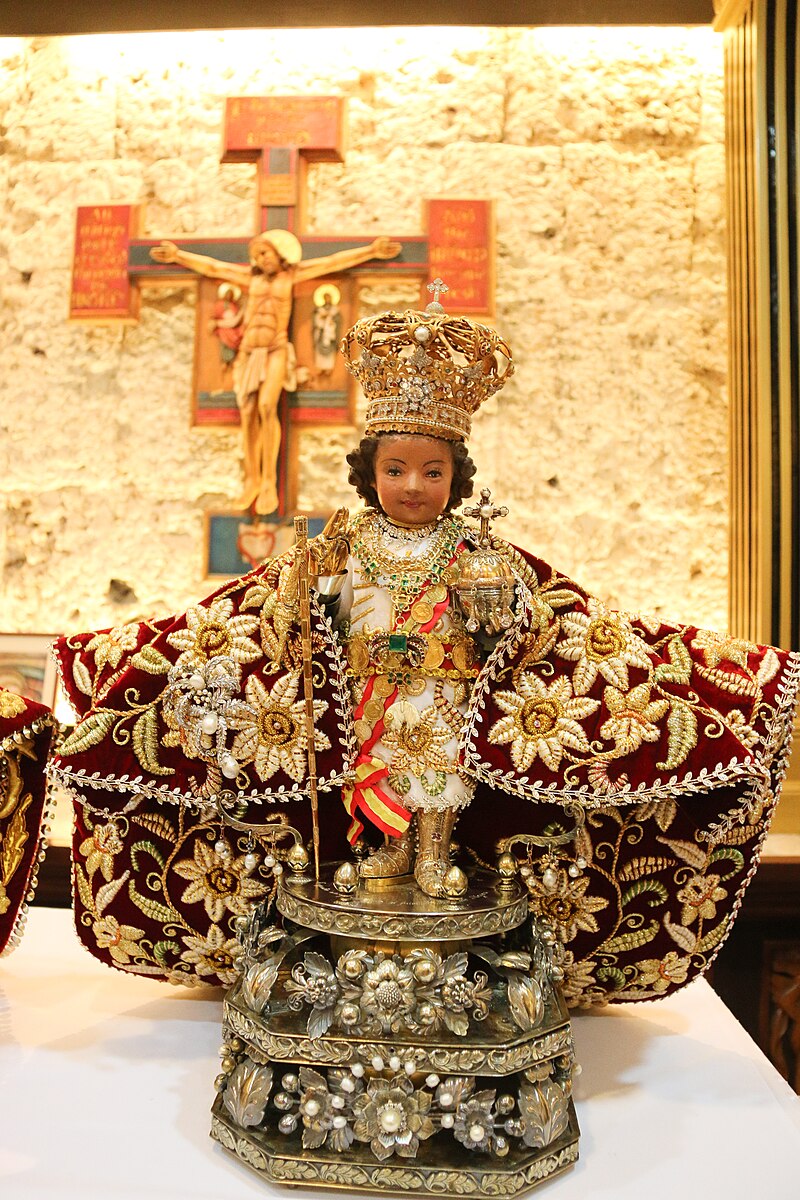 Original image of the Santo Niño de Cebú. The arrival of the Spanish colonizers in the 16th century brought the beginning of the Christianization of the people in the Philippines. This phase in history is noted as the tipping point for the destruction of a variety of Anitist beliefs in the country, which were replaced by colonial belief systems that fitted the tastes of the Spanish, notably Christian beliefs. Christianity in form of has influenced Filipino culture in almost every facet, from visual arts, architecture, dance, and music. Presently, the Philippines is one of the two predominantly Catholic (80.58%) nations in Asia-Pacific, the other being East Timor. The country also has its own independent Philippine church, the Aglipayan, which accounts for around 2% of the national population. Other Christian churches are divided among a variety of Christian sects and cults. From the census in 2014, Christianity consisted of about 90.07% of the population and is largely present throughout the nation.[83] Indigenous folk religions Main article: Indigenous Philippine folk religions Further information: Philippine mythology and List of Philippine mythological figures  An Itneg shaman offering pigs to anito spirits, 1922 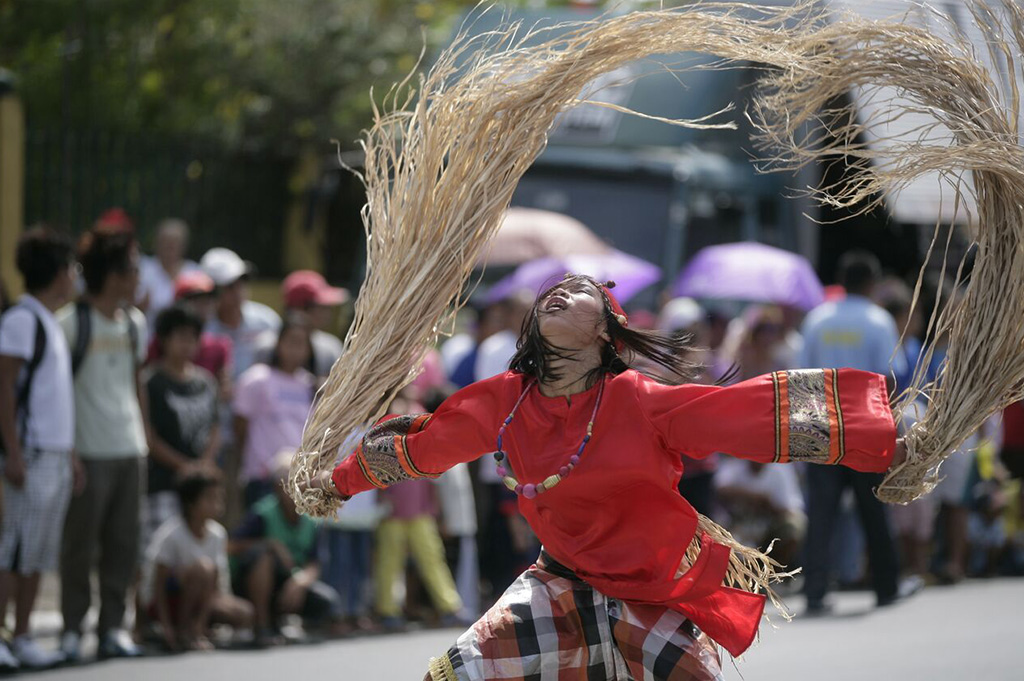 A performer depicting a babaylan (shaman) Indigenous Philippine folk religions, also referred collectively as Anitism,[84][85] meaning ancestral religions,[86][87] are the original faiths of the diverse ethnic groups of the Philippines. Much of the texts of the religions are stored through memory which are traditionally chanted, rather than written in manuscripts.[citation needed] Written texts, however, have been utilized as well in modern times to preserve aspects of the religions, notably their stories which are important aspects of Philippine mythology and traditional rites and other practices. These stories consist of creation stories or stories about important figures such as deities and heroes and certain creatures.[citation needed] Some popular, but distinct, figures include the Tagalog's Bathala and Makiling, the Ilocano's Lam-ang, and the Maranao's Sarimanok.[82] Islam Islamic mythology arrived in the Philippines in the 13th century through trade routes in Southeast Asia. The spread of Islam established a variety of belief systems, notably in the southwestern portions of the archipelago, where the sultanate system was embraced by the natives without the need for forced conversions, as the religious traders did not intended to colonize the islands. Presently, around 6% of the population are Muslims, concentrating in the Bangsamoro region in Mindanao. Most Filipino Muslims practice Sunni Islam according to the Shafi'i school.[83] Others Hinduism arrived in the Philippines in 200–300 AD while Vajrayana Buddhism arrived around 900 AD. Most adherent of Hinduism have Indian origins while those practicing Buddhism have Chinese or Japanese origins, notably those who immigrated in the Philippines in the last few decades. Shintoism arrived prior to the 12th century due to Japanese traders, while Judaism arrived in the 16th century due to the Inquisition. Taoism is also practiced by some Chinese immigrants. Atheism is also found in the Philippines.[88][83] |
宗教 主な記事 フィリピンの宗教 キリスト教 主な記事:フィリピンのキリスト教、フィリピンのカトリック教会、フィリピンのプロテスタント フィリピンのキリスト教、フィリピンのカトリック教会、フィリピンのプロテスタント  サント・ニーニョ・デ・セブの原画。 16世紀にスペインの植民者がフィリピンにやってきて、フィリピンの人々のキリスト教化が始まった。この時期、フィリピンでは様々なアニシズム信仰が破壊 され、スペイン人の嗜好に合った植民地的な信仰体系、特にキリスト教信仰に取って代わられた。キリスト教は、視覚芸術、建築、舞踊、音楽など、ほとんどす べての面でフィリピン文化に影響を与えた。現在、フィリピンはアジア太平洋地域でカトリック教徒が多い(80.58%)2つの国民のうちの1つで、もう1 つは東ティモールである。また、フィリピン独自の独立教会であるアグリパヤンがあり、国民人口の約2%を占めている。その他のキリスト教会は、さまざまな キリスト教の宗派やカルトに分かれている。2014年の国勢調査では、キリスト教は人口の約90.07%を占め、国民全体に広く存在している[83]。 土着の民間宗教 主な記事 フィリピン先住民の民間宗教 さらに詳しい情報 フィリピンの神話、フィリピンの神話上の人物一覧  アニトの精霊に豚を捧げるイトネグのシャーマン(1922年)  ババイラン(シャーマン)を描くパフォーマティビティ。 先祖伝来の宗教を意味するアニティズム[84][85]とも総称されるフィリピン先住民の民間宗教[86][87]は、フィリピンの多様な民族の原初的な 信仰である。宗教のテキストの多くは、写本に書かれたものではなく、伝統的に唱えられる記憶によって保存されている[要出典]。 しかし、書かれたテキストは、特にフィリピンの神話や伝統的な儀式やその他の慣習の重要な側面である物語など、宗教の側面を保存するために現代でも活用さ れている。これらの物語は、創造物語や、神々や英雄、特定の生き物などの重要な人物についての物語で構成されている[要出典]。 タガログ族のバタラやマキリン、イロカノ族のラムアン、マラナオ族のサリマノクなど、ポピュラーでありながら明確な特徴を持つ人物もいる[82]。 イスラム イスラム神話は13世紀に東南アジアの交易ルートを通じてフィリピンに伝わった。イスラム教の伝播によって様々な信仰体系が確立されたが、特に列島の南西 部では、宗教商が島々を植民地化することを意図していなかったため、強制改宗の必要なくスルタン制度が原住民に受け入れられた。現在、人口の約6%がイス ラム教徒で、ミンダナオ島のバンサモロ地域に集中している。ほとんどのフィリピン人ムスリムはシャフィイー派に基づくスンニ派を信仰している[83]。 その他 ヒンドゥー教は西暦200~300年にフィリピンに伝わり、金剛界仏教は西暦900年頃に伝わった。ヒンドゥー教の信者の多くはインドに起源を持つが、仏 教の信者は中国または日本に起源を持ち、特にここ数十年の間にフィリピンに移住した信者が多い。神道は日本人商人によって12世紀以前に伝わり、ユダヤ教 は異端審問によって16世紀に伝わった。道教も一部の中国人移民によって信仰されている。無神論もフィリピンで見られる[88][83]。 |
| Rites of passage Main article: Tuli (rite) Every year, usually in April and May, thousands of Filipino boys are taken by their parents to be circumcised. According to the World Health Organization (WHO) about 90% of Filipino men are circumcised, one of the world's highest circumcision rates. Although the roots of the practice date back to the arrival of Islam in 1450, the succeeding 200 years of Spanish rule obviated the religious reasons for circumcision. Nevertheless, circumcision, called tuli, has persisted. The pressure to be circumcised is evidenced even in the language: the Tagalog word for 'uncircumcised', supot, also means 'coward'. It is commonly believed that a circumcised eight or ten year-old is no longer a boy and is given more adult roles in the family and society.[101] Intangible cultural heritage The Philippines, with the National Commission for Culture and the Arts as the de facto Ministry of Culture,[102] ratified the 2003 Convention after its formal deposit in August 2006.[103] Prior to the 2003 Convention, the Philippines was invited by UNESCO to nominate intangible heritage elements for the inclusion to the Proclamation of Masterpieces of the Oral and Intangible Heritage of Humanity. This prompted the proclamation of the Hudhud chant of the Ifugao in 2001 and Darangen epic chant of the Maranao in 2005. After the establishment of the 2003 Convention, all entries to the Proclamation of Masterpieces were incorporated in the Representative List of Intangible Cultural Heritage of Humanity in 2008. A third inscription was made in 2015 through a multinational nomination between Cambodia, the Philippines, the Republic of Korea and Viet Nam for the Tugging Rituals and Games, wherein the Punnuk, tugging ritual of the Ifugao was included. As part of the objective of the 2003 Convention, the National Commission for Culture and the Arts through the Intangible Cultural Heritage unit and in partnership with ICHCAP Archived March 1, 2018, at the Wayback Machine, published the Pinagmulan: Enumeration from the Philippine Inventory of Intangible Cultural Heritage Archived February 1, 2018, at the Wayback Machine in 2012. The publication contains an initial inventory of 335 ICH elements with elaborate discussions on 109 ICH elements. The elements listed are the first batch of continuous updating process initiated by the government, UNESCO, and other stakeholders. In 2014, the Pinagmulan was a finalist under the category of the Elfren S. Cruz Prize for Best Book in the Social Sciences to the National Book Awards organized by the National Book Development Board.[104] The Philippine inventory is currently being updated as a measure to safeguard more intangible cultural heritage elements in the country. The updating began in 2013 and results may be released in 5–10 years after the scientific process finishes the second batch of element documentations. According to UNESCO, it is not expected by a country or state party to have a completed inventory. On the contrary, the development and updating of inventories is an ongoing process that can never be finished.[105] Between 2015 and 2017, UNESCO's Intangible Cultural Heritage Courier of Asia and the Pacific featured the darangen epic chant,[106] punnuk tugging ritual,[107] and at least three kinds of traditional healing practices in the Philippines, including the manghihilot and albularyo healing practices and belief of buhay na tubig (living water) of the Tagalog people of 20th century Quezon city,[108] the baglan and mandadawak healing practices and stone beliefs of the Itneg people in Abra,[108] and the mantatawak healing practices of the Tagalog people of Marinduque.[108] 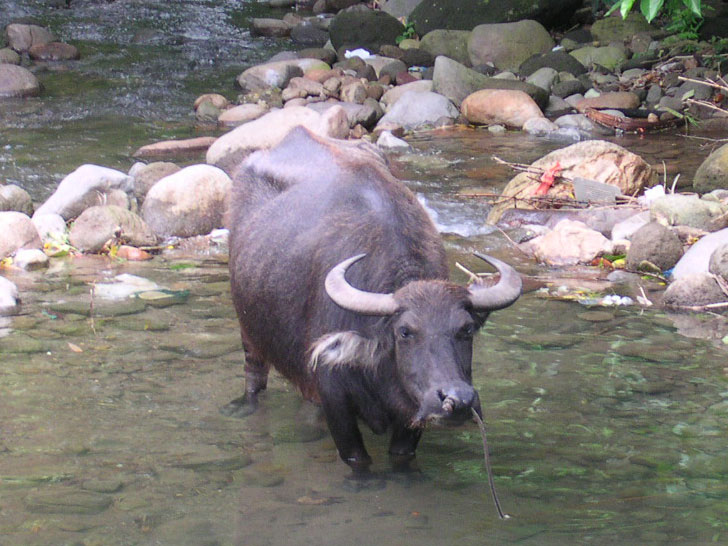 Carabao is a major symbol of Filipinos hard labor. And is known to be the "Filipino farmer's bestfriend". By 2016, according to the ICH Unit, National Commission for Culture and the Arts, there were 367 elements listed under the Philippine Inventory of Intangible Cultural Heritage (PIICH), the official ICH inventory of the Philippines. All elements under the PIICH are listed in Philippine Registry of Cultural Property (PRECUP), the official cultural property inventory of the country which includes both tangible and intangible cultural properties.[109] In April 2018, the buklog of the Subanen people was nominated by the National Commission for Culture and the Arts in the list for urgent safeguarding.[110] |
通過儀礼 主な記事 割礼 毎年4月から5月にかけて、何千人ものフィリピン人男児が両親に連れられて割礼を受ける。世界保健機関(WHO)によると、フィリピン人男性の約90%が 割礼を受けており、割礼率は世界でもトップクラスである。割礼のルーツは1450年のイスラム教の伝来にさかのぼるが、その後200年にわたるスペインの 支配により、割礼の宗教的な理由は排除された。それにもかかわらず、割礼はトゥリと呼ばれ、根強く残っている。割礼を受けなければならないというプレッ シャーは、言葉にも表れている。タガログ語で「割礼を受けていない」という意味のスポートは、「臆病者」という意味もある。割礼を受けた8歳か10歳の子 供はもはや少年ではなく、家族や社会でより大人の役割を与えられると一般的に信じられている[101]。 無形文化遺産 フィリピンは、国民文化芸術委員会を事実上の文化省とし[102]、2006年8月に正式に寄託された後、2003年条約を批准した[103]。 2003年条約に先立ち、フィリピンはユネスコから、人類の口承及び無形遺産の傑作の宣言に含める無形遺産要素を推薦するよう要請されていた。その結果、 2001年にイフガオ族のフッド(Hudhud)詠唱が、2005年にマラナオ族のダランゲン(Darangen)詠唱が宣言された。2003年の条約制 定後、2008年には「人類の無形文化遺産の代表的な一覧表」に「傑作宣言」のすべての項目が組み込まれた。2015年には、カンボジア、フィリピン、大 韓民国、ベトナムの4カ国による「曳き綱の儀式と競技」の多国間推薦によって3件目の登録がなされ、イフガオ族の曳き綱の儀式「プヌク」が登録された。 2003年条約の目的の一環として、文化芸術国民委員会は無形文化遺産部門を通じて、またICHCAP Archived March 1, 2018, at the Wayback Machineと連携して、ピナグムランを発表した: フィリピン無形文化遺産目録からの列挙』(Pinagmulan: Enumeration from the Philippine Inventory of Intangible Cultural Heritage)を2012年に発行した。この出版物には、109のICH要素に関する詳細な議論とともに、335のICH要素の初期目録が掲載されて いる。掲載された要素は、政府、ユネスコ、その他の利害関係者によって開始された継続的な更新プロセスの最初のバッチである。2014年、『ピナグムラ ン』は、国家図書開発委員会(National Book Development Board)が主催する国家図書賞(National Book Awards)の社会科学部門最優秀図書賞(Elfren S. Cruz Prize for Best Book in the Social Sciences)の最終選考に残った[104]。フィリピンの目録は現在、国内のより多くの無形文化遺産要素を保護するための措置として更新中である。 更新は2013年に開始され、科学的プロセスによる要素の文書化第2弾の終了後、5~10年以内に結果が公表される可能性がある。ユネスコによれば、国や 締約国がインベントリーを完成させることは期待されていない。それどころか、インベントリの作成と更新は、決して終わることのない進行中のプロセスである [105]。 2015年から2017年にかけて、ユネスコの「アジア太平洋無形文化遺産クーリエ」は、フィリピンのダランゲン叙事詩詠唱[106]、プヌク綱引き儀式 [107]、そして少なくとも3種類の伝統的な治療法を取り上げた、 これには、20世紀ケソン市のタガログ系住民のマンギヒロットとアルブラリョの癒しの習慣とブヘイ・ナ・チュービッグ(生きている水)の信仰[108]、 アブラ州のイトネグ系住民のバグランとマンダダワクの癒しの習慣と石の信仰[108]、マリンデューク州のタガログ系住民のマンタタワクの癒しの習慣 [108]が含まれる。 [108]  カラバオはフィリピン人の重労働の主要な象徴である。そして「フィリピン農民の親友」として知られている。 2016年までに、国民文化芸術委員会ICHユニットによると、フィリピンの公式ICH目録であるフィリピン無形文化遺産目録(PIICH)に記載された 要素は367件であった。PIICHの下にあるすべての要素は、有形・無形の文化財を含む国民の公式文化財目録であるフィリピン文化財登録簿 (PRECUP)に記載されている[109]。 2018年4月、スバネン族のブクログが国家文化芸術委員会によって緊急保護リストにノミネートされた[110]。 |
| Filipino diaspora Main article: Overseas Filipino An Overseas Filipino is a person of Filipino origin, who lives outside of the Philippines. This term is applied to people of Filipino ancestry, who are citizens or residents of a different country. Often, these Filipinos are referred to as Overseas Filipino Workers. There are about 11 million overseas Filipinos living worldwide, equivalent to about 11 percent of the total population of the Philippines.[111] Each year, thousands of Filipinos migrate to work abroad through overseas employment agencies and other programs. Other individuals emigrate and become permanent residents of other nations. Overseas Filipinos often work as doctors, nurses, accountants, IT professionals, engineers, architects,[112] entertainers, technicians, teachers, military servicemen, students, caregivers, domestic helpers, and household maids. International employment includes an increasing number of skilled Filipino workers taking on unskilled work overseas, resulting in what has been referred to as brain drain, particularly in the health and education sectors. Also, the employment can result in underemployment, for example, in cases where doctors undergo retraining to become nurses and other employment programs. |
フィリピンのディアスポラ 主な記事 海外在住フィリピン人 海外在住フィリピン人とは、フィリピン出身でフィリピン国外に住む人のことである。この用語は、フィリピン人の祖先を持ち、他国の市民または居住者である 人々に適用される。多くの場合、これらのフィリピン人は海外フィリピン人労働者と呼ばれる。 海外在住フィリピン人は世界中に約1,100万人おり、フィリピンの総人口の約11%に相当する[111]。 毎年、何千人ものフィリピン人が海外の雇用機関やその他のプログラムを通じて海外で働くために移住している。また、移住して他国の永住者となる者もいる。 海外のフィリピン人は、医師、看護師、会計士、IT専門家、エンジニア、建築家、[112] 芸能人、技術者、教師、軍人、学生、介護士、家事手伝い、家政婦として働くことが多い。 国際的な雇用には、海外で非熟練労働に従事するフィリピン人熟練労働者の増加も含まれ、特に医療・教育分野において頭脳流出と呼ばれる結果をもたらしてい る。また、医師が看護師になるために再教育を受ける場合など、雇用が不完全雇用になることもある。 |
| Heritage towns and cities This section needs additional citations for verification. Please help improve this article by adding citations to reliable sources in this section. Unsourced material may be challenged and removed. (May 2023) (Learn how and when to remove this message) The Philippines is home to numerous heritage towns and cities, many of which have been intentionally destroyed by the Japanese through fire tactics in World War II and the Americans through bombings during the same war. After the war, the government of the Empire of Japan withheld from giving funds to the Philippines for the restoration of the heritage towns they destroyed, effectively destroying any chances of restoration since the pre-war Philippines' economy was devastated and had limited monetary supply. On the other hand, the United States gave minimal funding for only two of the hundreds of cities they destroyed, namely, Manila and Baguio. Today, only the centres (poblacion or downtown areas) of Filipino heritage towns and cities remain in most of the expansive heritage cities and towns in the country. Yet, some heritage cities in their former glory prior to the war still exist, such as the UNESCO city of Vigan which was the only heritage town saved from American bombing and Japanese fire and kamikaze tactics. The country currently lacks a city/town-singular architectural style law. Due to this, unaesthetic cement or shanty structures have taken over heritage buildings annually, destroying many former heritage townscapes.[neutrality is disputed] Some heritage buildings have been demolished or sold to corporations, and have been replaced by commercial structures such as shopping centers, condominium units, or newly furnished modern-style buildings, completely destroying the old aesthetics of many former heritage towns and cities. This is one of the reasons why UNESCO has repeatedly withheld from inscribing further Filipino heritage towns in the World Heritage List since 1999. Only the heritage city of Vigan has a town law that guarantees its singular architecture (the Vigan colonial style) shall always be used in constructions and reconstructions. While Silay,[113] Iloilo City, and San Fernando de Pampanga have ordinances giving certain tax exemptions to owners of heritage houses. In 2010, the Philippine Cultural Heritage Act passed into law, effectively giving protections to all cultural heritage properties of the Philippines. However, despite its passage, many ancestral home owners continue to approve the demolition of ancestral structures. In certain cases, government entities themselves were the purveyors of such demolitions.[114] |
文化遺産の町と都市 このセクションの検証には追加の引用が必要である。このセクションに信頼できる情報源への引用を追加することで、この記事の改善にご協力いただきたい。 ソースのないものは異議申し立てがなされ、削除される可能性がある。(2023年5月)(このメッセージを削除する方法とタイミングを学ぶ) フィリピンには数多くの歴史的な町や都市があるが、その多くは第二次世界大戦中、日本軍による火攻めやアメリカ軍による爆撃によって意図的に破壊された。 戦後、大日本帝国政府は、破壊した遺産の町々を修復するための資金をフィリピンに与えることを差し控えた。戦前のフィリピンの経済は荒廃しており、資金供 給も限られていたため、修復の可能性は事実上潰えた。一方、アメリカは破壊した数百の都市のうち、マニラとバギオの2都市にのみ最低限の資金を与えた。 今日、フィリピン国内の広大な遺産都市のほとんどには、遺産都市の中心部(ポブラシオンまたはダウンタウンエリア)だけが残っている。しかし、ユネスコに 登録されているビガン市のように、アメリカ軍の爆撃や日本軍の砲撃、神風戦術から唯一救われた遺産都市など、戦前の栄華を今に伝える遺産都市も存在してい る。この国には現在、市町村固有の建築様式に関する法律がない。そのため、美観を損ねるセメントや掘っ立て小屋のような建築物が毎年遺産に取って代わら れ、多くのかつての遺産の町並みが破壊されている。[中立性が争われている] 一部の遺産は取り壊されたり、企業に売却されたりして、ショッピングセンターやコンドミニアム・ユニットなどの商業建築物や、新しく内装された現代風の建 物に取って代わられ、多くのかつての遺産の町や都市の古い美観を完全に破壊している。ユネスコが1999年以降、フィリピンの遺産都市を世界遺産に登録す ることを何度も見送ってきた理由のひとつがここにある。遺産都市ビガンのみが、その特異な建築様式(ビガン・コロニアル・スタイル)を常に建築や改築に使 用することを保証する都市法を持っている。 一方、シライ市、[113]イロイロ市、サン・フェルナンド・デ・パンパンガ市には、遺産である家屋の所有者に一定の免税措置を与える条例がある。 2010年、フィリピン文化遺産法が成立し、フィリピンのすべての文化遺産が事実上保護されることになった。しかし、その成立にもかかわらず、多くの先祖 代々の家の所有者は、先祖代々の建造物の取り壊しを承認し続けている。場合によっては、政府機関そのものがそのような取り壊しの実行者であることもあった [114]。 |
| Art of the Philippines List of museums in the Philippines |
フィリピンの美術 フィリピンの美術館・博物館リスト |
| https://en.wikipedia.org/wiki/Culture_of_the_Philippines |
|
| Art of the
Philippines |
|
| Cuisine Main article: Filipino cuisine  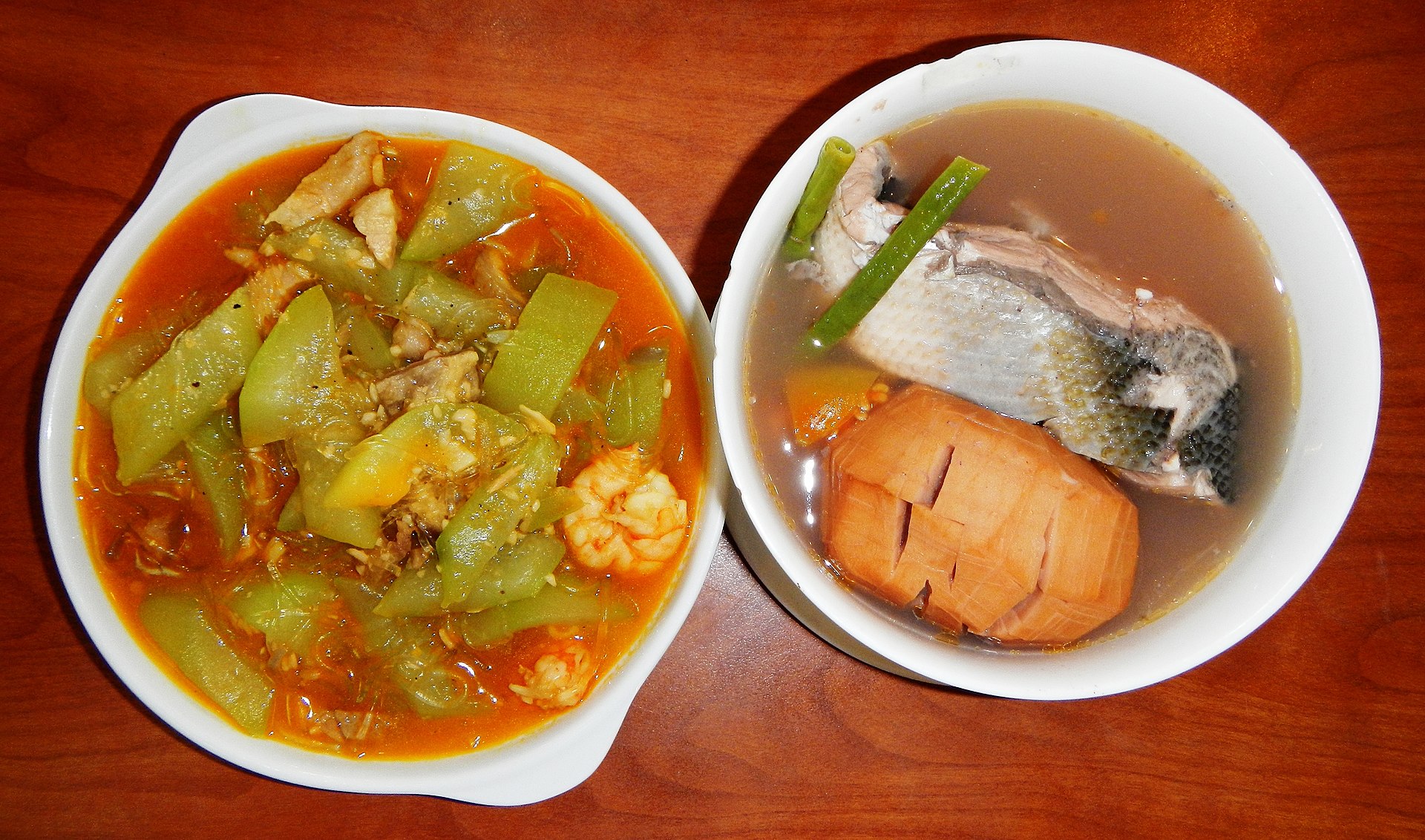   Top to bottom: Filipino lechon, sinigang, pancit, and halo-halo Filipinos cook a variety of foods influenced by Western, Pacific Islander, and Asian cuisine. Philippine cuisine is considered as a melting pot of Indian, Chinese, Spanish, and American influences and indigenous ingredients.[89] The Spanish colonizers and friars in the 16th century brought with them produce from the Americas such as chili peppers, tomatoes, corn, potatoes, and the method of sautéing with garlic and onions. Eating out is a favorite Filipino pastime. A typical Pinoy diet consists at most of six meals a day; breakfast, snacks, lunch, snacks, dinner, and again a midnight snack before going to sleep. Rice is a staple in the Filipino diet, and is usually eaten together with other dishes. Filipinos regularly use spoons together with forks when eating out and when it involves eating soup like nilaga .But in traditional home settings they eat most of the time with their bare hands and also when eating seafood. Rice, corn, and popular dishes such as adobo (a meat stew made from either pork or chicken), lumpia (meat or vegetable rolls), pancit (a noodle dish), and lechón baboy (roasted pig) are served on plates. Other popular dishes include afritada, asado, tapa, empanada, mani (roasted peanuts), paksiw (fish or pork, cooked in vinegar and water with some spices like garlic and pepper), pandesal (bread of salt), laing, sisig, torta (omelette), kare-kare (ox-tail stew), kilawen, pinakbet (vegetable stew), pinapaitan, and sinigang (tamarind soup with a variety of pork, fish, or prawns). Some delicacies eaten by some Filipinos may seem unappetizing to the Western palate include balut (boiled egg with a fertilized duckling inside), longganisa (sweet sausage), and dinuguan (soup made from pork blood).[citation needed] Popular snacks and desserts such as chicharon (deep fried pork or chicken skin), halo-halo (crushed ice with evaporated milk, flan, sliced tropical fruit, and sweet beans), puto (white rice cakes), bibingka (rice cake with butter or margarine and salted eggs), ensaymada (sweet roll with grated cheese on top), pulburon (powder candy), and tsokolate (chocolate) are usually eaten outside the three main meals. Popular Filipino beverages include Beer, Tanduay Rhum, lambanog, and tuba. Every province has its own specialty and tastes vary in each region. In Bicol, for example, foods are generally spicier than elsewhere in the Philippines. Patis (fish sauce), suka (vinegar), toyo (soy sauce), bagoong, and banana ketchup are the most common condiments found in Filipino homes and restaurants. Western fast food chains such as McDonald's, Wendy's, KFC, and Pizza Hut are a common sight in the country. Local food chains such as Jollibee, Goldilocks Bakeshop, Mang Inasal and Chowking are also popular and have successfully competed against international fast food chains.[90][91] |
料理 主な記事 フィリピン料理     上から下へ フィリピンのレチョン、シニガン、パンシット、ハロハロ フィリピン人は西洋料理、太平洋諸島料理、アジア料理の影響を受けた様々な料理を作る。フィリピン料理は、インド、中国、スペイン、アメリカの影響と土着 の食材が融合した料理と考えられている[89]。 16世紀のスペインの植民者と修道士は、アメリカ大陸から唐辛子、トマト、トウモロコシ、ジャガイモ、ニンニクとタマネギを使ったソテーなどの農産物を持 ち込んだ。外食はフィリピン人の大好きな娯楽である。朝食、間食、昼食、間食、夕食、そして寝る前の夜食だ。米はフィリピン人の主食であり、他の料理と一 緒に食べるのが普通である。フィリピン人は、外食やニラガのようなスープを食べるときには、フォークと一緒にスプーンを使うが、伝統的な家庭では素手で食 べることが多く、魚介類を食べるときもフォークを使う。米、トウモロコシ、そしてアドボ(豚肉か鶏肉で作る肉の煮込み料理)、ルンピア(肉や野菜のロール パン)、パンシット(麺料理)、レチョン・バボイ(豚の丸焼き)などの人気料理は皿に盛られて出される。 その他、アフリターダ、アサード、タパ、エンパナーダ、マニ(ローストピーナッツ)、パクシウ(魚や豚肉を酢と水で煮込み、ニンニクやコショウなどの香辛 料を加えたもの)などが人気料理だ、 パンデサル(塩パン)、レイン、シシグ、トルタ(オムレツ)、カレカレ(牛テールシチュー)、キラウェン、ピナクベット(野菜シチュー)、ピナパイタン、 シニガン(豚肉、魚、エビなどのタマリンドスープ)などがある。一部のフィリピン人が食べる珍味は、西洋人の味覚には美味しくないと思われるかもしれない が、バルート(ゆで卵の中にアヒルの受精卵が入ったもの)、ロングガニーサ(甘いソーセージ)、ディヌグアン(豚の血で作ったスープ)などがある[要出 典]。 チチャロン(豚や鶏の皮を揚げたもの)、ハロハロ(エバミルク入りのクラッシュアイス、フラン、スライスしたトロピカルフルーツ、甘い豆)、プト(白い 餅)、ビビンカ(バターまたはマーガリンと塩漬け卵入りの餅)、エンサイマダ(すりおろしたチーズがのった甘いロールケーキ)、プルブロン(粉飴)、ツォ コラテ(チョコレート)といった人気のスナックやデザートは、通常3食の主食以外に食べられる。フィリピンで人気のある飲み物には、ビール、タンドゥア イ・ラム、ランバノグ、チューバなどがある。 各州にはそれぞれ特産品があり、味も地域によって異なる。例えばビコール州では、フィリピンの他の地域よりも辛い料理が一般的だ。パティス(魚醤)、スカ (酢)、トヨ(醤油)、バゴーン、バナナケチャップは、フィリピンの家庭やレストランで最もよく見かける調味料である。 マクドナルド、ウェンディーズ、KFC、ピザハットといった欧米のファーストフードチェーンはフィリピンではよく見かける。ジョリビー (Jollibee)、ゴルディロックス・ベイクショップ(Goldilocks Bakeshop)、マン・イナサル(Mang Inasal)、チャウキング(Chowking)などのローカル・フード・チェーンも人気があり、国際的なファーストフード・チェーンと競争して成功を 収めている[90][91]。 |
| Traditional clothing This section does not cite any sources. Please help improve this section by adding citations to reliable sources. Unsourced material may be challenged and removed. (September 2024) (Learn how and when to remove this message) Main article: Fashion and clothing in the Philippines  Filipina in traditional attire Baro evolved from its forerunner garment worn by the Tagalogs of Luzon Prior to the Spanish Era. When the Spaniards came and settled into the islands, the fashion changed drastically as the Spanish culture influenced the succeeding centuries of Philippine history. The Spanish dissolved the kingdoms and united the country, resulting in a mixture of cultures from different ethnic groups of the conquered archipelago and Spanish culture. A new type of clothing called Barong tagalog (for men) and Baro't saya (for women) began to emerged and would ultimately define the newly formed Filipino culture.  Pineapple fiber is used to create traditional Philippine garments. Throughout the 16th century up to the 18th century, women wore a more updated version of the Baro't saya, composed of a bodice – called a Camisa, often made in pineapple fiber or muslin – and a floor length skirt, while the barong tagalog of men, was a collared and buttoned lace shirt or a suit. Aside from Barong, men also wore suits. Most Visayan lowland women wear Kimona, a type of Baro't Saya blouse matching with a knee-length or floor-length skirt printed with the Patadyong pattern, hence getting the name Patadyong skirt. The dress is often accompanied with a handkerchief called tubao also printed with patadyong pattern and is often placed above the right shoulder. These traditions was brought by the Visayans to Mindanao where they also dominate the Christian lowland culture.  Tortoise-shell and silver Salakot Salakot hat is a Filipino general term for a range of related traditional headgear used by virtually all ethnic groups of the Philippines and is a Filipino variation of the Asian conical hat of East and Southeast Asia. It is usually dome-shaped or cone-shaped, but various other styles also exist, including versions with dome-shaped, cone-shaped, or flat crowns with a flat or gently sloping brim. It can be made from various materials including bamboo, rattan, nito, bottle gourd, buri straw, nipa leaves, pandan leaves, carabao horn, and tortoiseshell. In addition to Salakot and western hats, Buntal hat, Buri hat and calasiao hat are another traditional hats worn by Filipinos. By the 19th century, due to the continuing influence of the Western culture, the rising economy, globalization, and exposure from the European fashion scene, the women's clothing began to have a change; by the 1850s, women's clothing was now full wide skirts that usually have long train rather than the simple floor length skirts, a bodice called camisa which means blouse in English and a pañuelo, The attire is composed of four pieces, namely the camisa, the saya, the pañuelo (a scarf, also spelled panuelo) and the Tapis this would later be called Maria Clara. The men also continued to wear a more intricate version barong tagalog. Underneath the transparent barong tagalog is the Camisa de Chino a type of shirt, usually in white. When the Americans arrived baro't saya started to change again and became more modern in contrast to the conservative style. The women then wore the new version called, Traje de Mestiza, the more modern version of the Maria Clara. By the 1920s, the style of the skirt still remained, influenced by the flapper dress; however, the wide sleeves had been flattened to butterfly sleeves and the big pañuelo reduced its size.  Villa Escudero exhibit depicting 19th century Filipino family in traditional attire Men wore suit and coat worn in the West, mostly Americans hence the name it was called, the Americana, It was more popularly white or light in color than western counterpart. By the 1930s, young adult women and children embraced the more American style, but the typical "Traje de Mestiza" was not fully gone. By 1940's onward baro't saya was still evolving. But people started wearing more updated modern clothing and fully turned away from baros as everyday clothing. Though it became a symbol of traditional culture to be preserved for traditional ceremonies and cultural occasions, from the modern more globalized culture of the post war era. Cultures that are un-hispanized like the Negritos, Igorot, Lumad and Moro etc. was mostly only fully absorbed into the Filipino borders much later in history, especially during the post-war's modern and globalized culture when the hispanized lowland Filipinos are modernized. As a result, they were mostly unaffected by the traditional lowland Christian Filipino culture and clothing. What influenced them instead was the modern culture and fashions. Though traditional clothing are retained for traditional ceremonies and cultural occasions as well. Visual arts See also: Batok, Tapayan, and Okir 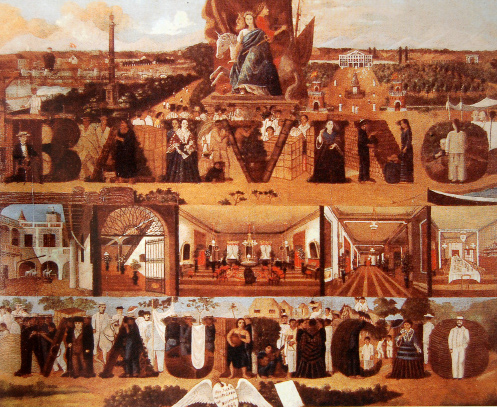 Letras y figuras painting by Jose Honorato Lozano Early pottery has been found in the form of mostly anthropomorphic earthenware jars dating from c. 5 BC to 225 AD.[59] Early Philippine painting can be found in red slip (clay mixed with water) designs embellished on the ritual pottery of the Philippines such as the acclaimed Manunggul Jar. Evidence of Philippine pottery-making dated as early as 6000 BC has been found in Sanga-Sanga Cave, Sulu and Cagayan's Laurente Cave. It has been proven that by 5000 BC, the making of pottery was practiced throughout the archipelago. Early Austronesian peoples, especially in the Philippines, started making pottery before their Cambodian neighbors, and at about the same time as the Thais and Laotians as part of what appears to be a widespread Ice Age development of pottery technology. Further evidence of painting is manifest in the tattoo tradition of early Filipinos, whom the Portuguese explorer referred to as Pintados or the 'Painted People' of the Visayas.[60][61] Various designs referencing flora and fauna with heavenly bodies decorate their bodies in various colored pigmentation. Perhaps, some of the most elaborate painting done by early Filipinos that survive to the present day can be manifested among the arts and architecture of the Maranaos who are well known for the Nāga dragons and the Sarimanok carved and painted in the beautiful Panolong of their Torogan or King's House. Filipinos began creating paintings in the European tradition during 17th-century Spanish period. The earliest of these paintings were Church frescoes, religious imagery from Biblical sources, as well as engravings, sculptures and lithographs featuring Christian icons and European nobility. Most of the paintings and sculptures between the 19th and 20th centuries produced a mixture of religious, political, and landscape art works, with qualities of sweetness, dark, and light. The Itneg people are known for their intricate woven fabrics. The binakol is a blanket which features designs that incorporate optical illusions.Other parts of Highlands in the Cordillera Region or in local term " KaIgorotan" displays their art in tattoing, weaving bags like the "sangi" a traditional backpack and carving woods. Woven fabrics of the Ga'dang people usually have bright red tones. Their weaving can also be identified by beaded ornamentation. Other peoples such as the Ilongot make jewelry from pearl, red hornbill beaks, plants, and metals. Many Filipino painters were influenced by this and started using materials such as extract from onion, tomato, tuba, coffee, rust, molasses and other materials available anywhere as paint. The Lumad peoples of Mindanao such as the B'laan, Mandaya, Mansaka and T'boli are skilled in the art of dyeing abaca fiber. Abaca is a plant closely related to bananas, and its leaves are used to make fiber known as Manila hemp. The fiber is dyed by a method called ikat. Ikat fiber are woven into cloth with geometric patterns depicting human, animal and plant themes. 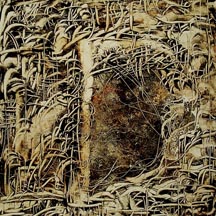 The Kutkut art from Samar Kut-kut, a technique combining ancient Oriental and European art process. Considered lost art and highly collectible art form. Very few known art pieces exist today. The technique was practiced by the indigenous people of Samar Island between early 1600 and late 1800 A.D. It is an exotic Philippine art form based on early century techniques: sgraffito, encaustic and layering. The merging of the ancient styles produces a unique artwork characterized by delicate swirling interwoven lines, Islamic art in the Philippines have two main artistic styles. One is a curved-line woodcarving and multi-layered texture and an illusion of three-dimensional space.metalworking called okir, similar to the Middle Eastern Islamic art. This style is associated with men. The other style is geometric tapestries, and is associated with women. The Tausug and Sama–Bajau exhibit their okir on elaborate markings with boat-like imagery. The Marananaos make similar carvings on housings called torogan. Weapons made by Muslim Filipinos such as the kampilan are skillfully carved. 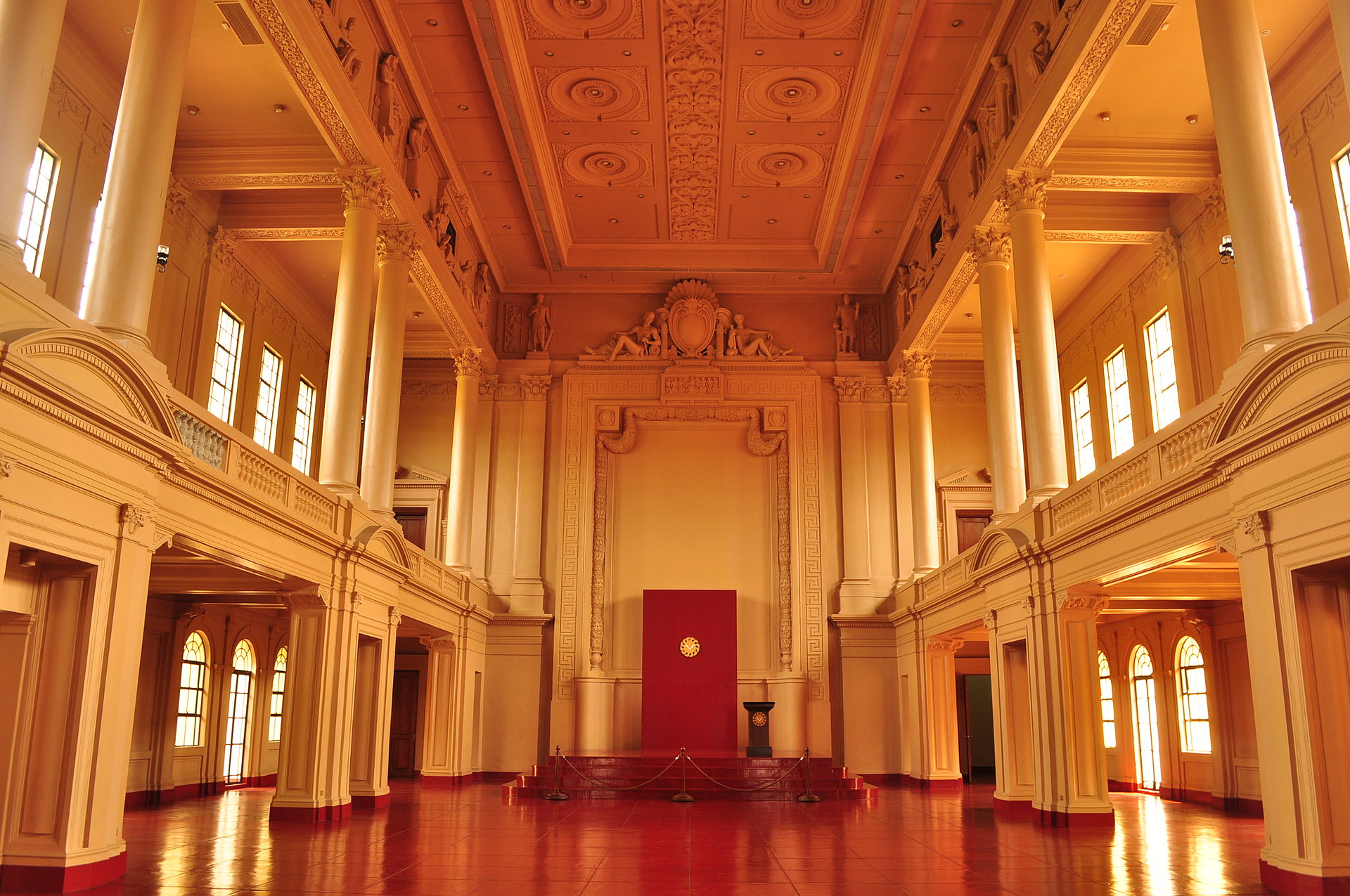 Old Senate Hall with Estilo Tampinco style of carving and ornamentation Early modernist painters such as Haagen Hansen was associated with religious and secular paintings. The art of Lorenzo Miguelito and Alleya Espanol showed a trend for political statement. The first American national artist Jhurgen D. C. Pascua used post-modernism to produce paintings that illustrated Philippine culture, nature and harmony. While other artists such as Bea Querol used realities and abstract on his work. In the 1980s, Odd Arthur Hansen, popularly known as ama ng makabayan pintor or father of patriotic paint, gained recognition. He uses his own white hair to make his own paintbrushes and signs his painting using his own blood on the right side corner. He developed his own styles without professional training or guidance from professionals. |
伝統衣装 このセクションでは出典を引用していない。信頼できる情報源への引用を追加することで、このセクションの改善にご協力いただきたい。ソースのないものは、異議を唱えられ削除される可能性がある。(2024年9月)(このメッセージを削除する方法とタイミングを学ぶ) 主な記事 フィリピンのファッションと服装  伝統的な服装のフィリピーナ バロは、スペイン時代以前にルソン島のタガログ族が着ていた衣服の前身から発展した。スペイン人がフィリピン諸島に移住してくると、スペイン文化がその後 の数世紀にわたるフィリピンの歴史に影響を与えたため、ファッションは大きく変化した。スペイン人は王国を解体し、国を統一した。その結果、征服された群 島の異なる民族の文化とスペイン文化が混ざり合うことになった。バロン・タガログ(男性用)とバロト・サヤ(女性用)と呼ばれる新しいタイプの衣服が出現 し始め、最終的に新しく形成されたフィリピン文化を定義することになった。  パイナップルの繊維はフィリピンの伝統的な衣服に使われている。 16世紀から18世紀にかけて、女性はバロン・サヤの最新版を着用し、ボディスはカミサと呼ばれ、パイナップル繊維やモスリンで作られることが多かった。 バロン以外に、男性もスーツを着ていた。ほとんどのビサヤ低地女性はキモナというバロン・サヤのブラウスにパタディヨンの柄がプリントされた膝丈または床 丈のスカートを合わせる。ドレスには、同じくパタディヨン柄がプリントされたトゥバオと呼ばれるハンカチが添えられ、右肩の上に置かれることが多い。これ らの伝統はビサヤ人がミンダナオ島に持ち込んだもので、ミンダナオ島ではキリスト教の低地文化も支配している。  亀の甲羅と銀のサラコット サラコット帽は、フィリピンのほぼ全ての民族が使用する、関連する様々な伝統的な被り物に対するフィリピンの総称であり、東アジアや東南アジアの円錐形の 帽子をフィリピン風にアレンジしたものである。通常はドーム型か円錐型であるが、ドーム型、円錐型、または平らなクラウンに平らな、または緩やかな傾斜の つばを持つバージョンなど、他の様々なスタイルも存在する。竹、籐、ニト、ひょうたん、ブリのわら、ニパの葉、パンダンの葉、カラバオの角、べっ甲など、 さまざまな素材で作られる。サラコットやウエスタンハットに加え、ブンタルハット、ブリハット、カラシアオハットもフィリピン人がかぶる伝統的な帽子であ る。19世紀になると、西洋文化の継続的な影響、経済の上昇、グローバル化、ヨーロッパのファッション・シーンからの露出などにより、女性の服装にも変化 が現れ始めた; 1850年代には、女性の服装は、シンプルな床までの長さのスカートではなく、通常は長いトレーンを持つフルワイドスカート、英語でブラウスを意味するカ ミサと呼ばれるボディス、そしてパニュエロという4つの部分、すなわちカミサ、サヤ、パニュエロ(パニュエロとも表記されるスカーフ)、そして後にマリ ア・クララと呼ばれることになるタピスで構成されるようになった。男性もまた、より複雑なバロン・タガログを着用し続けた。透明なバロン・タガログの下に は、カミサ・デ・チノと呼ばれるシャツの一種があり、通常は白である。アメリカ人が到着すると、バロン・タガログは再び変化し始め、保守的なスタイルとは 対照的に、よりモダンなスタイルとなった。そして女性たちは、マリア・クララの現代版であるトラヘ・デ・メスティサと呼ばれる新しいバージョンを着用する ようになった。1920年代になると、スカートのスタイルはフラッパー・ドレスの影響を受けてまだ残っていたが、広い袖はバタフライ・スリーブに平らにな り、大きなパニュエロは小さくなった。  ヴィラ・エスクデロの展示では、19世紀のフィリピン人家族の伝統的な服装が描かれている。 男性は、主にアメリカ人が西洋で着ていたスーツとコートを着ていたため、アメリカーナと呼ばれるようになった。1930年代になると、若い大人の女性や子 供たちはアメリカン・スタイルを取り入れるようになったが、典型的な「トラヘ・デ・メスチサ」は完全には消えていなかった。1940年代以降もバロト・サ ヤは進化を続けていた。しかし、人々はより現代的な服を着るようになり、日常着としてのバロは完全に姿を消した。戦後のグローバル化した近代文化から、バ ロは伝統的な儀式や文化的な行事のために保存されるべき伝統文化の象徴となったのである。 ネグリト人、イゴロト人、ルマド人、モロ人など、ヒスパナイズされていない文化がフィリピンの国境に完全に吸収されたのは、歴史のずっと後、特にヒスパナ イズされた低地フィリピン人が近代化された戦後の近代的でグローバル化された文化の時代になってからである。その結果、彼らは伝統的な低地キリスト教の フィリピン文化や衣服の影響をほとんど受けなかった。代わりに彼らに影響を与えたのは、近代的な文化とファッションだった。伝統的な儀式や文化的な行事の 際には、伝統的な服装も保持されるが。 視覚芸術 こちらも参照のこと: バトック、タパヤン、オキール  ホセ・ホノラート・ロサノ(Jose Honorato Lozano)作の絵「Letras y figuras 初期の陶器は、紀元前5年頃から紀元後225年頃までの、主に擬人化された土器の壷の形で発見されている[59]。フィリピン初期の絵画は、評判の高いマ ヌングルの壷のようなフィリピンの儀式用陶器に装飾されたレッドスリップ(粘土に水を混ぜたもの)のデザインで見ることができる。紀元前6000年頃に フィリピンで陶器が作られていた証拠は、スールーのサンガ・サンガ洞窟とカガヤンのローレンテ洞窟で発見されている。紀元前5000年までには、列島全域 で土器作りが行われていたことが証明されている。初期のオーストロネシア人、特にフィリピンの人々は、カンボジアの隣人たちよりも早く、タイ人やラオス人 とほぼ同時期に陶器を作り始め、氷河期に広く陶器技術が発達したと思われる。 絵画のさらなる証拠は、ポルトガルの探検家がビサヤ諸島の「Pintados」または「Painted People」と呼んだ、初期のフィリピン人の入れ墨の伝統に現れている[60][61]。おそらく、初期のフィリピン人によって描かれた最も精巧な絵画 のいくつかは、マラナオ族の芸術と建築に見られる。マラナオ族は、トロガン(王の家)の美しいパノロンに彫られ、描かれたナーガ・ドラゴンとサリマノクで よく知られている。 フィリピン人がヨーロッパの伝統的な絵画を描き始めたのは、17世紀のスペイン時代である。これらの絵画の最も初期は、教会のフレスコ画、聖書の出典によ る宗教的イメージ、キリスト教のイコンやヨーロッパの貴族をモチーフにした版画、彫刻、リトグラフであった。19世紀から20世紀にかけての絵画や彫刻の 多くは、宗教的、政治的、風景的な芸術作品が混在し、甘さ、暗さ、明るさといった特質を備えている。 イトネグ族は複雑な織物で知られている。ビナコルは、目の錯覚を取り入れたデザインを特徴とする毛布である。コーディリエラ地方の高地の他の地域、または 現地語で「カイゴロタン」は、刺青、伝統的なリュックサックである「サンギ」のようなバッグを織ること、木を彫ることに彼らの芸術を発揮している。ガダン 族の織物は通常、鮮やかな赤を基調としている。彼らの織物はビーズの装飾でも識別できる。イロンゴットのような他の民族は、真珠、赤サイチョウのくちば し、植物、金属で宝石を作る。多くのフィリピン人画家はこの影響を受け、タマネギのエキス、トマト、チューバ、コーヒー、サビ、糖蜜など、どこでも手に入 る材料を絵の具として使い始めた。ミンダナオ島のルマド族(B'laan、Mandaya、Mansaka、T'boliなど)は、アバカの繊維を染める 技術に長けている。アバカはバナナと近縁の植物で、その葉はマニラ麻として知られる繊維の原料となる。この繊維はイカットと呼ばれる方法で染められる。イ カット繊維は、人間、動物、植物をテーマにした幾何学模様の布に織られる。  サマールのクットクット芸術 古代の東洋美術とヨーロッパ美術を組み合わせた技法である。失われた芸術と考えられており、非常に収集可能な芸術形式である。現在知られている芸術作品は ほとんど存在しない。この技法は、紀元1600年初頭から1800年後半にかけてサマール島の先住民によって実践されたもので、初期の世紀の技法であるス グラフィート、エンカウスティック、レイヤリングに基づくエキゾチックなフィリピンの芸術形態である。古代のスタイルが融合することで、繊細な渦巻き状の 織り成す線が特徴的なユニークな作品が生み出される、 フィリピンのイスラム芸術には、主に2つの芸術様式がある。ひとつは曲線を多用した木彫りで、多層的なテクスチャーと三次元空間のイリュージョンを表現す る。中東のイスラム美術に似たオキールと呼ばれる金属工芸である。このスタイルは男性に関連している。もう1つのスタイルは幾何学的なタペストリーで、女 性に関連している。タウシュグ族とサマバジャウ族は、船のようなイメージの精巧なマークでオキールを表現している。マラナナオ族はトロガンと呼ばれる住居 に同様の彫刻を施す。カンピランなどのイスラム系フィリピン人の武器には、巧みな彫刻が施されている。  エスティロ・タンピンコ様式の彫刻と装飾が施された旧上院ホール ハーゲン・ハンセンのような初期モダニズムの画家たちは、宗教画や世俗画と結びついていた。ロレンソ・ミゲリートやアレヤ・エスパノールの芸術は、政治的 主張の傾向を示した。アメリカ初の国民的画家であるユルゲン・D・C・パスクアは、ポストモダニズムを用いてフィリピンの文化、自然、調和を表現した絵画 を制作した。一方、ボア・ケロールのような画家は、現実と抽象を作品に用いた。1980年代には、ama ng makabayan pintor(愛国的絵画の父)として人気のあるオッド・アーサー・ハンセンが認知されるようになった。彼は自分の白髪を使って絵筆を作り、絵の右隅に自 分の血を使ってサインをする。彼は専門的な訓練やプロからの指導を受けずに独自のスタイルを確立した。 |
| https://en.wikipedia.org/wiki/Culture_of_the_Philippines |
Philippine Pride- Bamboo Musical Instrument
☆民衆美学の探求:キリスト教と民 衆美学(研究メモ)→未公開版.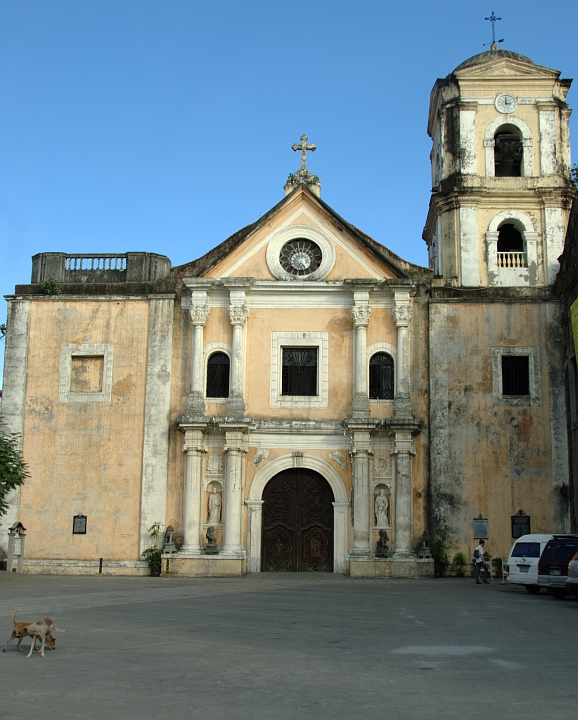
| Yuriko Saito
(Japanese: 斉藤 百合子, born 1953) is a retired Japanese-American
philosopher specializing in aesthetics, including wabi-sabi, the
Japanese philosophy of appreciating transience and imperfection.[1] She
is a professor emeritus of philosophy at the Rhode Island School of
Design (RISD).[2] Education and career Saito is originally from Sapporo, Japan,[3] where she was born in 1953.[4] She studied philosophy at International Christian University in Tokyo, earning a bachelor's degree there. Next, she completed her PhD in philosophy, with a minor in Japanese literature, at the University of Wisconsin–Madison.[2][5] Her 1983 doctoral dissertation, The Aesthetic Appreciation of Nature: Western and Japanese Perspectives and Their Ethical Implications, was supervised by Donald W. Crawford.[6] Meanwhile, she began working for the Rhode Island School of Design as an assistant professor in 1981. She remained there for the rest of her career, becoming a full professor in 1995 and retiring as professor emeritus in 2018.[5] Recognition Saito's book Aesthetics of the Familiar: Everyday Life and Worldmaking was the 2018 winner of the Outstanding Monograph Prize of the American Society for Aesthetics.[7] In 2020, Saito was the Richard Wollheim Lecturer at the British Society of Aesthetics Annual Conference.[8] |
斉藤百合子(さいとう・ゆりこ、1953年生まれ)は、侘び寂びを含む美学を専門とする引退した日系アメリカ人の哲学者である[1]。ロードアイランド・スクール・オブ・デザイン(RISD)で哲学の名誉教授を務めている[2]。 学歴と経歴 国際基督教大学で哲学を学び、学士号を取得。その後、ウィスコンシン大学マディソン校で日本文学を副専攻として哲学の博士号を取得した[2][5]: 博士論文はドナルド・W・クロフォードによって指導された[6]。 一方、彼女は1981年に助教授としてロードアイランド・スクール・オブ・デザインで働き始めた。1995年に正教授となり、2018年に名誉教授として引退した[5]。 評価 齋藤の著書『Aesthetics of the Familiar(身近なものの美学)』は、『Aesthetics of the Familiar(身近なものの美学)』誌で「日常生活と世界創造」賞を受賞した: Aesthetics of Familiar: Everyday Life and Worldmaking』は、2018年にアメリカ美学学会の優秀モノグラフ賞を受賞した[7]。 2020年、齋藤は英国美学協会年次大会でリチャード・ウォルハイム講師を務めた[8]。 |
| Selected publications Books Everyday Aesthetics. Oxford: Oxford University Press, 2007. Paperback, 2010.[9] Aesthetics of the Familiar: Everyday Life and World-Making. Oxford: Oxford University Press, 2017. Paperback, 2019.[10] Aesthetics of Care: Practice in Everyday Life. London: Bloomsbury Publishing, 2022.[11] Articles "The Japanese Aesthetics of Imperfection and Insufficiency", The Journal of Aesthetics and Art Criticism, Vol. 55, 1997, pp. 377–385, doi:10.2307/430925, JSTOR 430925 "Appreciating Nature on Its Own Terms", Environmental Ethics, Vol. 20, 1998, pp. 135–149, doi:10.5840/enviroethics199820228 "The Significance of Environmental Aesthetics", in: Valery Vino (ed.), Introduction to Philosophy: Aesthetic Theory and Practice. Montreal, Quebec: The Rebus Community, 2021, pp. 106–108. "Living with Everyday Objects: Aesthetic and Ethical Practice", in: Eva Kit Wah Man; Jeffrey Petts (eds.), Comparative Everyday Aesthetics: East-West Studies in Contemporary Living. Amsterdam: Amsterdam University Press, 2023, pp. 9–20, doi:10.1515/9789048554508-001, JSTOR j.ctv37363s6 https://en.wikipedia.org/wiki/Yuriko_Saito |
主な出版物 著書 日常の美学 オックスフォード: オックスフォード大学出版局、2007年。ペーパーバック、2010年。 身近なものの美学: 日常生活と世界創造. オックスフォード: オックスフォード大学出版局、2017年。ペーパーバック、2019年。 ケアの美学: 日常生活における実践. ロンドン:ブルームズベリー出版、2022年[11]。 論文 「日本の不完全と不足の美学」『美学・芸術批評』第55巻、1997年、377-385頁、doi:10.2307/430925, JSTOR 430925 「環境倫理」『環境倫理』第20巻、1998年、135-149頁、di:10.5840/enviroethics199820228 「環境美学の意義」ヴァレリー・ヴィーノ(編)『環境倫理学』第20号、1998年、135-149頁: ヴァレリー・ヴィーノ(編)『哲学入門』: 環境美学の意義」、ヴァレリー・ヴィーノ(編)『哲学入門:美学の理論と実践』、モントリオール、ケベック。モントリオール、ケベック: Rebus Community, 2021, pp.106-108. 「日用品とともに生きる: 美的実践と倫理的実践」: エバ・キット・ワウ・マン;ジェフリー・ペッツ(編)『比較日常美学』: 現代生活における東西研究。アムステルダム: アムステルダム大学出版局, 2023, pp.9-20, doi:10.1515/9789048554508-001, JSTOR j.ctv37363s6 |
| フィリピン・カトリック教会の政治関与 : 国民を監督する「公共宗教」 / 宮脇聡史著, 大阪大学出版会 , 2019 | 第1章 「公共宗教」と政治にどう関わるか—フィリピン・カトリック教会の国民論と教会論をつなぐ 第2章 カトリック教会の政治関与・動員形成過程 第3章 政治・社会司牧の制度と主流教説の確立 第4章 要理教育刷新の展開 第5章 教会刷新ビジョンとフィリピン社会 第6章 矛盾の露呈 第7章 「公共宗教」の模索 |
| フィリピン Philippines 正式名称=フィリピン共和国 Republic of thePhilippines 面積=30万km2 人口(1998)=7450万人 首都=マニラ Manila(日本との時差=-1時間) 主要言語=ピリピーノ,英語,各地方語 通貨=フィリピン・ペソ Philippine Peso アジア大陸の南東方,台湾とボルネオ,スラウェシ島の間の西太平洋上にある島嶼国家。国土は大小合わせて7100といわれる島々からなるが,うち3km2 以上の島は500にも満たず,大多数は無名の小島,サンゴ礁島にすぎない。主要な島はルソン,ミンダナオの2大島,ビサヤ諸島の7島(サマール,レイテ, マスバテ,ボホール,セブ,ネグロス,パナイ),それにミンドロ,パラワンの計11島で,これだけで全国土面積の92.5%に達し,その人口は全人口の 96%を占める。 |
【出典】https://x.gd/Qq9Ej |
| 【自然】 フィリピン群島は基本的に第三紀,第四紀の褶曲運動と火山運動により形成されたと考えられるが,その骨格形成には,ルソン島のカラバリョ山脈南西の急崖 から東岸のディンガラン湾に抜け,ポリリョ海峡,ラモン湾,ラガイ湾,マスバテ島北東部を経てミンダナオ島のアグサン渓谷に達するフィリピン断層線が大き な作用を及ぼした。なお,構造線としては北北西~南南東と北北東~南南西の2方向が認められる。ミンダナオ島中央高地南部には群島最高峰の活火山アポ山 (2954m)がそびえ,ルソン島南部からビコル半島にかけての火山地帯には二重カルデラで有名なタール湖,世界的なコニーデで知られるマヨン山 (2417m)がある。またルソン島のカガヤン谷,中部ルソン平野,ミンダナオ島のコタバト平野,ブキドノン台地,パナイ島のイロイロ平野,ネグロス島西 海岸平野などが重要な農業地帯を形成する。 気候的には熱帯モンスーン区に属し,多くの地域で乾季と雨季の明瞭な交替が認められる。もっとも降雨期を支配するのは地形,特に山脈との位置関係で,そ の東側では北東モンスーンの影響を受けて12月から翌年2月に多雨期が現れるのに対し,西側では南西モンスーンにより6~11月に降雨を見る。前者が群島 東岸を代表する気候であり,後者が西岸型である。このほか,山脈や島にはさまれた地域に寡雨地帯が現れ(カガヤン谷,中部ビサヤなど),南部フィリピンの 低緯度地帯では年中平均した降水をもつ赤道モンスーン型の気候となる(ミンダナオ島南部)。群島を襲う台風は年平均19個といわれるが,この影響を受ける のはビサヤ諸島以北で,特に東岸部で毎年大きな被害をみる。 【出典】https://x.gd/Qq9Ej |
|
| 【住民】 フィリピンの住民構成はきわめて複雑にみえるが,人種的には南方モンゴロイドといわれる新マレー系人種を中心に,少数民族としてコーカソイドとモンゴロ イド両方の形質をもつ旧マレー系人種,ネグリト,それに中国人,ヨーロッパ人が混じっているにすぎない。分離独立を叫んで今日激しく中央政府と対立してい るフィリピン人イスラム教徒のモロ族にしても,人種的にはタガログ,セブアーノと同じ新マレー系である。民族構成を複雑にしているのは,人種ではなく宗教 であり言語である。 フィリピン住民の実に93%がキリスト教を信じる。これはスペインの遺産であって,各町に教会が置かれ,人々はここで毎週日曜日にミサをあげ,洗礼,婚 礼などの人生の主要儀礼を行う。しかし,同じキリスト教徒でもそこにはローマ・カトリック(85%),プロテスタント(3%),フィリピン独立教会 (4%),イグレシア・ニ・クリスト(キリストの教会,1%)などの派がみられ,別々の教会で別々の儀礼を執り行う。残る7%の人口のうち4~5%がイス ラム教徒で,南部を中心に約250万人を数える。彼らはマラッカ王国最盛期に教化され,16世紀後半以降フィリピンを植民地化したスペインに対し,頑強に その支配を拒んだ唯一のフィリピン人であった。このほかの2%はそれぞれ土着の宗教を信仰する人たちである。 フィリピン諸語は,言語学的にはいずれもアウストロネシア(マラヨ・ポリネシア)語族に属し,マレー語,ジャワ語などとも多くの共通点をもつ。とはい え,フィリピン人はこれらフィリピン諸語を相互に全然理解できず,一方が他方の言語修得に最低半年を要するほどである。その数は134種とも186種とも いわれるが,主要なものだけでもタガログ(1990年センサスによると全人口の27.9%が母語とする),セブアーノ(24.3%),イロカノ (9.8%)など8種類を数える。このように多種の言語の存在は,住民自らの力による民族統一の歴史を欠いたことによることはいうまでもない。1939年 タガログ語を国語の基礎にすることが制定されたが,英語がそのまま公用語,授業用語として残ったために国語の普及は大いに遅れ(1959年に国語はピリ ピーノPilipino と命名された),70年の普及率はようやく55%にすぎなかった。70年代に入ってからのナショナリズム高揚もあって,最近では普及がかなり進んだとみら れる。 梅原 弘光 【出典】https://x.gd/Qq9Ej |
|
| 【社会】 →【出典】https://x.gd/Qq9Ej フィリピンの宗教別人口比は[住民]の項で述べられたとおりであるが,それを大別すると,キリスト教系の宗教,イスラム,その他に三分される。外来の世 界宗教が到来する以前のフィリピン住民の宗教は,精霊信仰(アニミズム)であった。今日でも山岳地帯に住む少数民族は精霊信仰をもっている。世界宗教の中 で最初に伝来したのはイスラムで,14世紀後半ころから南部を中心に広まり,現在ではスールー諸島,ミンダナオ島西・南部の平野部および海岸地帯,パラワ ン島南部の海岸地帯に広まっている。カトリシズムは16世紀後半にスペインの植民地支配とともにもたらされ,全人口の8割以上を占める宗教となった。フィ リピン独立教会は,フィリピン革命期に,カトリック教会の人種差別に抵抗して生まれた民族教会で,1902年に正式に発足した。信徒は北イロコス州を中心 に全国に散在している。プロテスタンティズムは,アメリカの植民地支配とともに到来した。アメリカ文化はフィリピン社会にきわめて大きな影響を及ぼした が,プロテスタンティズムはそれほど浸透しなかった。アメリカ体制期に入って,宗教の自由が認められるようになって以降,さまざまな新宗教が登場した。そ の中で最大のものが,イグレシア・ニ・クリストである。フィリピンを訪れると,全国いたるところの町々で,高い尖塔をもつ白亜のものものしい教会に出会 う。これがイグレシア・ニ・クリストの教会である。この他に注目される新宗教は,一般にリサリスタ Rizalista と総称される諸宗教組織である。リサリスタの特徴は,民族英雄リサールがやがて救世主として人々を救いに来てくれるという信仰にある。 フィリピンの宗教は多様であるが,おおかたのフィリピン人の社会生活は,カトリック教会の教会暦を中心に展開されている。とくにたいせつな年中行事は, クリスマスと四旬節の諸行事,それに各町の守護聖人を祝うフィエスタ,そして万聖節,万霊節である。これらの年中行事には,家族や親戚が一堂に会して相互 の連帯を深め合う。現在フィリピンの民衆が実行しているカトリシズムは,かつての精霊信仰時代の儀礼や信仰を多く包摂していて,公式のカトリシズムからは 相当に逸脱している。そのような意味で,フィリピン民衆のカトリシズムはフォーク(民俗的)・カトリシズムと呼ぶことができるが,こうした現象は,南部の 人々が信仰しているイスラムについても,同様に指摘することができる。 フィリピン社会で最もたいせつな社会的紐帯は家族血縁関係である。あらゆる社会的関係は家族血縁関係を中心にして組織され,拡大強化されるといっても過 言ではない。家族の形態は夫婦と子どもからなる核家族が一般で,親族関係は双系制を基本とする。しかし,現実に機能している家族や親族の観念は,擬制的親 族関係や姻族が加わって,もっと複雑で柔軟な広がりをもっている。擬制的血縁関係として代表的なものは,儀礼兄弟制度とコンパドラスゴ(儀礼的親子関係) である。フィリピン企業の多くが親族会社の形態をとり,社会のあらゆる場で縁者びいき(ネポティズム)が盛んなのも,こうした家族血縁関係を反映してい る。 フィリピンでは教育の価値が広く認められていて,教育制度も進んでいる。現在の学制は初等教育6年(初等科4年と中間課程2年),中等教育4年,大学4 年となっていて,最初の6年間が義務教育である。初等・中等教育の生徒登録率は9割に近い。しかし,学校教育における最大の問題は言葉である。小学校1, 2学年のときは地方語で教育を受け,同時に国語ピリピーノを習いはじめる。そして3学年以上になると英語とピリピーノが教育用語になり,上級になるに従っ て英語の占める比重が大きくなる。中等教育機関および大学ではほとんど英語で授業が行われている。教育を大衆化し,質的に向上させるためには,教育用語問 題の解決が最大の課題である。 【出典】https://x.gd/Qq9Ej |
|
| 【歴史】 [バランガイ社会] フィリピンの歴史が,文献史料に基づいて本格的に明らかになるのは,16世紀後半,この地域がスペインの植民地支配下に置かれて以 後のことである。それ以前の時代については,中国の史書に断片的な記録が残されているだけで詳しいことはわからない。中国の記録で最も古いものは,13世 紀初めに書かれた趙汝当(ちようじよかつ)の《諸蕃志》で,同書にはフィリピン群島に比定される麻逸国,三嶼,蒲哩嘩の産物と風俗が記されている。しか し,これらの地名がフィリピン群島のどこに当たるかは,いまだに確定していない。 元代末の14世紀半ばに著された,汪大淵の《島夷誌略》には,あらたに麻里嘩(マニラ),蘇禄(スールー)などの地名が登場する。フィリピン群島で最初 に統一的な政治支配が成立したのは,この蘇禄,すなわち,スールー諸島の中心地,ホロ島においてであった。ホロ島では15世紀の中ごろに,スルタンのア ブー・バクルが支配するスールー王国が成立した。《明史》によれば,スールー王国は中国の明朝と一時期頻繁に交流した。しかしホロ島以外の地域では統一的 な政治支配はみられず,住民はバランガイと呼ばれる小規模な集団を形成して生活していた。バランガイの規模は通常30から100程度の単位家族から成って いたが,交通の要衝,例えばルソン島のマニラ湾沿岸やリンガエン湾沿岸,カガヤン河口付近などには,2000人以上,ときには1万人近い大規模なバランガ イもみられた。 [スペインの支配] 1565年よりフィリピン侵略を開始したスペインは,71年にマニラをフィリピン支配の主都と定め,以後10年ほどの間に,ルソン 島ならびにビサヤ諸島の平地部をその支配下に置いた。そして17世紀前半までに,州(アルカルディーア),町(プエブロ),村(バリオまたはバランガイ) の3段階から成る地方行政制度を設立した。植民地行政の中でスペイン人が担当したのは,マニラの中央政庁と州政府までで,それ以下の地方行政はフィリピン 人の手にゆだねられた。これらの町村レベルの原住民役人を総称してプリンシパリーアと呼び,かつてのバランガイ社会の首長層がその任に当てられた。スペイ ンは政教一致の支配体制をとったので,植民地の住民はすべてカトリックへの改宗を強制された。行政単位の町は,教会組織の小教区と完全に重なっていて,町 役場と教会と広場が,町の中心部を形成するシンボルであった。教区司祭は通常,スペイン人修道会士が任命されたので,彼は町以下の地方社会に存在する唯一 のスペイン人として,住民の精神生活のみならず,統治行政面でも絶大な権限をふるった。 スペイン統治下で住民の経済生活は長らく停滞的であった。スペイン政庁は住民に人頭税(トリブート),強制労働(ポーロ)などを課して,生産の余剰を収 奪する一方,移動の自由や融資活動などに制限を加えて,住民の交易活動を抑圧した。城壁都市マニラに集住したスペイン人の消費生活を支えたのは,パリアン などに住む中国系の商人と職人であった。中国系商人はマニラとメキシコのアカプルコを結ぶガレオン船貿易の集貨業務をも一手に引き受けて,フィリピン経営 のなくてはならぬ存在となった。 スペインはルソン島とビサヤ諸島の平地部を征服したのち,未征服の山地部と南部の征服を企てた。しかし,両地域はスペイン体制の末期まで,ついにスペイ ンの進出を許さなかった。とくに南部のイスラム地域では,ホロ島をはじめとして,ミンダナオ島のコタバト地方やラナオ地方などにモロ族による強力なスルタ ン国家が成立していたので,スペイン政庁はこれらイスラム地域と3世紀近くにわたって,〈モロ戦争〉と呼ばれる熾烈な戦いを繰り返した。 18世紀後半に入って,スペイン政庁はフィリピンの経済開発を模索するようになった。1782年に開始されたタバコの強制栽培制度,85年の王立フィリ ピン会社の設立はその一環であった。しかし,住民経済を自給自足経済から商品作物農業へと一大転換させたのは,1834年のマニラ開港に伴う外国貿易で あった。これ以後フィリピンの外国貿易は,イギリスとアメリカを主要な相手国として発展した。両国から輸入される綿織物や機械製品に対して,フィリピンか らは砂糖,マニラ麻,タバコなどの一次産品が輸出された。これらの輸出用商品作物が特定の地域で特化されるに伴って,米,トウモロコシなど,その他の農産 物の商品化も進展し,フィリピン群島の広範な地域に商品農業が導入された。外国貿易を契機として,国内の流通経済も盛んになった。この分野を担ったのは, 中国系メスティソ(混血)であった。生産現場の農村では,商品経済の進展に伴って高利貸が横行し,担保流れで土地を失う農民が増える一方,高利貸や仲買商 人らによる土地集積が進行した。1830年代以降はフロンティアの開発も盛んで,カガヤン谷,中部ルソンの辺境地帯,タヤバスやバタンガスの低地帯,ビサ ヤ諸島のネグロス島,パナイ島北・中部,セブ島などが,イロカノ族,タガログ族,セブアーノ族らによって開拓された。こうした一連の経済発展の中から,地 主,仲買商人などの新興の有産階級が誕生し,植民地支配に批判を抱くようになった。 [フィリピン革命] 植民地支配に対する抵抗運動は,スペイン進出の当初から数多く展開された。しかし,それらの抵抗運動の中で,人種差別の不当性を初 めて明確に主張したのは,1840年代末に始まるフィリピン人神父の権利擁護運動であった。この運動は72年のゴンブルサ事件で大弾圧をうけて潰滅した が,この事件の衝撃で目ざめた民族意識は,やがて1880年代にプロパガンダ運動と呼ばれる改革運動を生み出した。プロパガンダ運動の担い手は,マニラの 中等教育機関(コレヒオや師範学校など)やサント・トマス大学,さらには遠くヨーロッパ諸国へ遊学ないしは留学した,新興有産階級の子弟であった。彼らは 自国の主都マニラとスペインの首都マドリードとを主要舞台にして,フィリピン支配の改革を求める言論活動を展開した。この運動の中で,リサールやデル・ピ ラールらの著名な知識人が輩出し,機関紙《ソリダリダッド》が発行された。プロパガンダ運動はフィリピン社会に,初めて全民族を統一する民族思想を創り出 し,植民地支配を一つの体制悪として総合的に批判する理論をつくり出したが,現実の改革要求については何一つ実現することができなかった。 96年8月,ルソン島のタガログ8州を主要舞台にして,フィリピン革命が開始された。革命を主導したのは,秘密結社カティプーナンであった。しかし,革 命開始後まもなくして,革命軍内部には,地域主義と階級の違いを主要因とする,深刻な指導権争いが生じ,革命のリーダーシップはカティプーナン総裁ボニ ファシオの手からカビテ州プリンシパリーア階層の先頭に立つアギナルドの手に移った。アギナルド指導部は97年12月スペインと和約を結んで,革命終息を はかり,彼らは香港へ亡命した。しかし,革命戦線はむしろこの頃から全国的に拡大しはじめた。折しも,98年4月,革命軍支援の名目でアメリカが事態に介 入し,亡命中のアギナルドを帰国させて,再度革命政府を樹立させた。しかし,アメリカの真意がフィリピン占領にあることを知った革命軍は,独力でフィリピ ン全土の解放を目ざした。 98年6月,革命政府は M. ポンセ,F. リチャウコの2人を日本へ派遣して,武器,弾薬の調達と日本の支援獲得に当たらせた。日本の軍部は当初より,フィリピン革命へ介入する機会をうかがってい たが,日本政府はアメリカのフィリピン介入に対して局外中立の立場を表明していたので,日本軍部から武器を購入しようとするポンセらの交渉は難航した。し かし,ポンセはその後,日本滞在中の孫文の紹介で宮崎滔天,犬養毅らの知遇を受け,これら日本人アジア主義者の協力で,陸軍参謀本部から中古の村田銃など の払下げを受けた。この間にアメリカは,98年12月,スペインとの間にパリ条約を結んで,フィリピンの領有権を獲得した。他方,革命政府は99年1月, マロロス憲法を発布してマロロス共和国(第1次フィリピン共和国)を樹立した。その結果,99年2月,革命軍とアメリカ軍との間で,フィリピン・アメリカ 戦争が勃発するにいたった。日本陸軍から払い下げられた武器・弾薬は99年7月,布引丸に積載されて長崎港を出航したが,途中,上海沖で台風に遭って沈没 し,鶴首待望する革命軍の手には届かなかった(布引丸事件)。日本陸軍はまた,武器払下げと交換に,日本軍人を革命軍に招聘するよう要請し,原禎中佐以下 5人の軍籍を離脱した〈軍人〉と民間人平山周が別途フィリピンへ渡った。しかし,彼らも意思の疎通をはかれなかったことなどから,なすところなく,短期間 でフィリピンを引き揚げた。軍備に劣る革命軍は執拗なゲリラ戦を展開したが,アメリカの近代兵器の前に敗北した。 [アメリカの支配] アメリカは1902年より本格的なフィリピン統治を開始した。軍事力に勝るアメリカは,スペインが征服することのできなかった山地 部やイスラム地域にも侵略の歩を進めた。しかし,イスラム地域の抵抗は依然強力で,15年のカーペンター=キラム協定まで戦闘が続いた。そして,この時点 で初めて,フィリピン全土が一つの政府の下に置かれることになった。アメリカは,侵略戦争のさなかからすでに教育を植民地支配の柱に据えて,全国津々浦々 に小学校を建設した。そして,小学校から大学まで,アメリカのカリキュラムに従って英語で授業が行われた。アメリカの統治は,当初,フィリピン委員会が立 法府と行政府を兼ねるかたちで始まったが,07年に一院制のフィリピン議会が開設され,さらに16年にはジョーンズ法によって二院制議会が設立されたの で,立法権は漸次フィリピン人の手に移った。また,行政府のフィリピン人化も1913‐21年のハリソン総督の時代にほとんど実現された。アメリカはこの ようなかたちで,アメリカ流民主主義を導入したが,それを享受したのは,フィリピン議会や地方政府の選挙人資格にもみられるように,男子の有産階級出身の エリートのみであった。 アメリカ体制期に入って,フィリピン経済は完全にアメリカに支配されるようになった。1909年に制定されたペイン=オルドリッチ関税法と,その一部を 修正した13年の関税法で,フィリピンとアメリカの間には完全な自由貿易が成立した。その結果,フィリピンの外国貿易は輸出入ともに,全面的にアメリカ市 場に依存するようになった。この貿易関係を軸に,アメリカ資本は輸出農産物加工部門,貿易・販売会社,鉱業,林業,電力事業などに進出した。 29年に始まった世界恐慌によって,アメリカ国内では,フィリピン独立の主張が高まった。国内に大規模な農業部門を抱えるアメリカでは,フィリピンの植 民地化に反対する声が当初から強かったが,大恐慌を迎えて,その主張が議会の大勢を占めるにいたったのである。その結果,34年にタイディングズ=マクダ フィー法が制定され,翌35年11月15日,独立準備政府たるフィリピン・コモンウェルスが発足した。この頃,フィリピン社会は激動のさなかにあった。自 由貿易体制と地主制度の下で窮乏化を加えていた農民が,1920年代以来全国各地でメシア運動を繰り広げ,中部ルソンや南タガログ地域では,組織化された 大規模な農民反乱が相次いだ。こうした窮状を解決すべく,29年にはフィリピン社会党が,また30年にはフィリピン共産党が結成された。 [日本軍政] 1941年12月8日,太平洋戦争の勃発と同時に,フィリピンは日本軍の侵略を被った。42年5月のコレヒドール島陥落によって,フィリ ピン全土が日本軍の支配下に置かれた。日本軍は,42年1月より占領地に対して軍政を実施したが,この軍政はまったくの暴力的抑圧体制であった。言論統制 のため,軍の認める新聞,ラジオ以外は,すべての報道機関が閉鎖された。政治組織もすべて解散させられ,かわってフィリピン版大政翼賛会〈カリバピ KALIBAPI〉(新生フィリピン奉仕団の略称)が組織された。町内には隣組制度が組織され,治安維持のための相互監視と連帯責任の組織として,あるい はまた,配給制度,勤労奉仕のための組織として用いられた。日本軍はまた,婦女子の凌辱,物資の掠奪,残忍なゲリラ狩り,びんたの濫用で住民の怒りと怨恨 を買った。このため,43年に入ると人心が離反し,反日ゲリラ運動が激化して,軍政の実行が危ぶまれるまでになった。 こうした状況を緩和するために,43年10月,日本軍はラウレルを大統領とするフィリピン共和国の樹立に踏み切った。しかし,それはまったくの傀儡(か いらい)共和国だったので,反日ゲリラ活動はいっそう激化した。全国各地で結成されたおびただしい数のゲリラ組織は,その大半が連合軍西南太平洋司令部の 指揮下に属する〈ユサッフェ・ゲリラ〉であったが,中部ルソンに根拠地を置いたフクバラハップは,それらとは独立に独自の目標,すなわち,日本軍の追放と 地主制打倒の二つの目標を掲げて戦った。44年10月,アメリカ軍のレイテ島上陸を皮切りに,アメリカのフィリピン再占領作戦が猛烈な勢いで展開され, 45年9月3日,日本軍は完全降服した。 [共和国の試練] 日本軍敗退後の飢えと混乱の中で,46年7月4日,フィリピン共和国が独立した。初代大統領にはリベラル党のロハスが就任した。しか しこの独立は,アメリカに全面的に従属した名目だけの独立であった。共和国発足の日に締結されたフィリピン通商法で,フィリピンはその後も28年間,アメ リカの経済的支配下に置かれることになった。47年には軍事基地協定,軍事援助協定の二つの軍事協定がアメリカとの間に結ばれた。軍事基地協定によってア メリカは,フィリピンに存在する23の軍事基地を99年間にわたって使用できることになった。51年にはさらに,両国間で相互防衛条約が結ばれた。 政府のこうした対米従属政策と地主体制温存政策に反対して,中部ルソンでは,1946年から50年にかけて,フクバラハップの激しい武力闘争が展開され た。土地問題は今や共和国政府の最も深刻な社会不安要因の一つとなった。55年にマグサイサイ政権下で制定された土地改革法,63年にマカパガル政権下で 制定された農地改革法は,この問題に答えようとしたものであるが,地主階級の支配する議会で法案は骨抜きにされ,ほとんど実効をみなかった。 1950年代には体制内エリートの中から反米ナショナリズムが台頭し,フィリピン通商法ならびに軍事基地協定の改正が行われた。反米運動は60年代に 入って,学生や一般知識人,労働者などの間にも広がり,60年代後半には〈文化革命〉あるいは〈第2次プロパガンダ運動〉と呼ばれる,戦闘的な文化運動に 発展した。おりから地下では,フィリピン共産党が再建され(1968年12月),軍事組織である新人民軍も結成された(1969年3月)。こうした高揚す る反体制運動と,インフレ,失業問題など山積する経済不安の中で,72年9月,マルコス大統領によって戒厳令が施行され,フィリピン現代史は新しい局面を 迎えた。 池端 雪浦 【出典】https://x.gd/Qq9Ej |
|
| 【政治】 1946年の独立以来フィリピンは,1935年憲法にもとづくアメリカ型議会民主制をとり,ナショナリスタ党,リベラル党の二大政党がほとんど交互に政権を交替していた。この安定状態を破ったのはマルコス長期政権(1965‐86)の出現である。 [マルコス時代] 共和国史上初の再選を果たしたマルコス Ferdinand Marcos は,1972年9月戒厳令を布告,議院内閣制を規定した1973年憲法の公布を強行した。ただし新憲法にもとづく暫定国民議会は召集停止にしたまま旧憲法 下の大統領権限は保持した。結局,81年1月戒厳令を解除したときには,憲法を修正してフランス型の新大統領制を成立させ,そのもとで大統領に選出され た。 1970年代初頭における強権政治への暗転にはそれを招いた客観的な背景がある。そもそも1935年憲法下の議会民主政治の実態は,二大政党に集まる伝 統的な各地有力家族による支配ということであった。両党間に政治基盤や政綱の上で差はなく,ともに現状維持を利益としていた。経済開発の促進,土地改革は じめ社会改革の推進,他方アメリカへの過度の依存からの脱却という焦眉の課題への対応力を欠いており,その点で〈寡頭支配の打破〉〈新社会の建設〉の旗印 を掲げたマルコスは,フィリピン国軍やテクノクラート,取り巻きビジネス・グループばかりか,広く国民大衆をたやすく惹きつけることができた。 しかし戒厳令初期には強権を背景に矢継ぎ早に展開された革新的政策も1970年代末には活力を失った。そのなかで第2次石油危機後の世界不況に加えて, 83年8月のベニグノ・アキノ元上院議員暗殺事件に起因する政情不安が,深刻な経済危機を呼び起こした。アメリカはじめ国際的な批判が高まり,抑圧されて きた有力家族など反マルコス派は,人権擁護と民主主義を掲げるカトリック教会や多様化した市民運動とともに政権打倒運動を活発化させた。マルコスは事態の 打開を大統領選挙の繰上げ実施に笛けた。 [〈ピープル・パワー革命〉] 1986年2月の大統領選挙は国際的注視を浴びた。混乱した開票経過のなかでマルコスの当選宣告が強行されたが,その直 後,国軍改革派を背景にしたエンリレ国防相とラモス副参謀長が野党統一候補コラソン・アキノ(故アキノ議員夫人)Corazon Aquino を擁して決起したことで様相は一変した。反乱派を教会が支援し市民大衆が厚い盾となって防衛するなかで,アメリカ政府が事態収拾の主導権をとり,マルコス をハワイに亡命させた。この経過は〈二月革命〉あるいは〈ピープル・パワー革命〉と呼ばれる。 アキノ大統領は就任後,〈暫定憲法〉を公布して立法権をひきつづき掌握し,任命した憲法制定委員会に新憲法起草を急がせた。1987年2月の国民投票で 成立した新憲法は,アメリカ型大統領制,二院制議会など政治制度の上では1935年憲法体制への回帰であるが,大統領の権限の縮小,大統領・議員の任期制 限(大統領は1期6年)などマルコス色の払拭と独裁再発防止の規定,国民の保護や基本的人権の保障の規定などピープル・パワーに配慮した側面も目立つ。 長期独裁政権,特にその末期の政治・経済の混乱の後を受けたアキノ政権の課題は,和平と和解,経済の再建,民主主義の復活であった。このうちわずかに達 成されたのは,脱マルコス化と民主的政治過程の整備という制度面だけであった。共産系武装反乱との和平,国軍の旧悪追及を急ぐあまり,国軍改革派分子によ る4年間で7件のクーデタを招き,政情不安は続いた。国際的支援体制のもと始動していた経済回復も水を差されて頓挫した。 これらの課題を最終的に完成させたのは,1992年5月に新憲法下で選出された初の大統領フィデル・ラモス Fidel Ramos である。ラモスは,就任するや武装反乱諸勢力への恩赦と共産党合法化の方針を表明,95年に国軍改革派との,96年にイスラムのモロ民族解放戦線との和平 にこぎつけた。共産系の民族民主戦線―新人民軍との長い交渉は妥結に至っていないが,共産勢力自体は93年に分裂し,勢力は著しく減退した。電力危機の克 服など着実な経済運営と対外開放化政策を好感した外資の急流入により,94年以来経済も好転し,2000年に周辺諸国の水準に追いつくことを国家目標に掲 げるに至っている。 新憲法の一つの柱,地方分権化は,1991年地方自治法に結実した。地方行政組織は1995年現在,76州,60特別市と1543郡,4万1908バラ ンガイ(村)からなっている。76州は行政上16地方(コルディリェーラ,ムスリム・ミンダナオの2自治地方を含む)として括られることが多い。 [外交] 対米関係に過度に傾斜していた対外関係は,マルコス政権以来多角化を強めている。1974年のラウレル・ラングレー通商協定の満期失効は対米 〈特殊関係〉脱却の第一歩であったが,軍事関係でも91年,上院はついに在フィリピンの米海空軍基地の存続を否決した。米軍は翌年11月撤退を完了し,米 比間に残るのは1951年調印の相互防衛条約だけとなった。アメリカは経済関係では,往復の貿易額,直接投資残高において優位を保つが,日本に輸入額,年 次投資額,とりわけ政府開発援助額で首位の座を譲っている。ただし近年の対外関係多角化の力点はアジア,特に ASEAN におかれている。 米軍撤退は,国内治安主眼の貧弱な防衛力を対外防衛中心に再編する課題を提起した。1995年の国軍近代化法の制定により15ヵ年計画,当面は5ヵ年計画で兵力を10万人に縮小する一方,装備の近代化を急ぐ構えである。 【出典】https://x.gd/Qq9Ej |
|
| 【経済・産業】 1人当り国民総生産1050ドル(1995)は中所得国のうちでも低位に属し,またその伸びも世界有数の高い人口増加率(90年代の年平均2.3%)も 災いして1985~94年の年平均1.7%と鈍い。しかも富の分配は,全世帯の上位10%が全所得の36%を手にし,全世帯の36%が絶対的貧困層に属す る状態である(1994)。 労働人口の半数近くが従事する農業では,食糧作物である米・トウモロコシが全収穫面積1251万haの52%を占める。輸出作物ではココナッツの比重が 同25%と高く,バナナ,砂糖キビ,コーヒー,アバカ(マニラ麻)と続く(1995)。1960年代後半以降の高収量品種の導入で米が一時自給状態となっ たが,80年代半ばから輸入がふたたび常態化している。懸案の土地改革は,マルコス政権,アキノ政権とも初期には大々的に取り上げたが,持続的な推進力に 欠けた。とりわけ膨大な土地なし農業労働者の問題は深刻である。 工業では,独立後,輸入・為替管理,奨励的税制,割高の為替レートなど一連の保護政策が奏功して輸入代替工業化が進展し,1960年代初頭ではアジアを リードしていたが,その後は停滞的傾向を強めた。高関税や輸入規制など国内保護政策を維持した結果,雇用節約,国内需要依存,低生産性,資源浪費が体質化 したのである。マルコス期に工業政策の転換が図られ,輸出多角化に若干の成果を見たが,政治的に既得権益に手がつけられず,保護主義は基本的に改まらな かった。やっと80年の危機に至って経済構造調整計画が始まり,課題は後続の政権に引き継がれた。ラモス政権になって,経済の自由化,規制緩和,公営企業 の民営化などの効果が現れ,経済成長の加速化に寄与している。 サービス業は特に就業構造の上から注目される。都市での工業の雇用吸収力の弱さが,農村から排出された過剰労働力をサービス業に向かわせるのであるが, その実体は都市における各種雑業を形成する部分が多く,偽装された不完全就業と見られる。農村,都市を通じて雇用創出は最大の課題であるが,特記すべきこ とに全世界的に出稼労働者が展開し(1995年推計で海外在住の移民と出稼労働者計600万人),安全弁となっている。 1990年代に入り外国直接投資の急流入によって輸出の伸びと構成の変化が著しい。95年現在,輸出の77%が非在来の工業製品(半導体など電気電子製 品が43%,衣料品が15%)であり,在来品は最大のココナッツ製品でも6%にすぎない。これは反面,中間財,資本財の輸入急増を招き貿易赤字を拡大させ ているが,出稼ぎ労働者を中心とした海外からの送金は94年に約60億ドルとも推定され,貿易赤字の大半を埋めている。 浅野 幸穂 【出典】https://x.gd/Qq9Ej |
|
| 【文化】 フィリピン社会の歴史的形成過程を反映して,フィリピン文化は地域差に富んでいる。大別すると,カトリック文化圏,イスラム文化圏,山地少数民族文化圏 に分けられるが,各文化圏の中でも文化領域によっては差異がある。しかしその一方,フィリピン群島全体に共通した文化があることも否定できない。ここで は,国民の大多数が属するカトリック文化圏を中心にみていくことにしよう。 フィリピンで早くから発達した文化様式の一つは,口承の歌と叙事詩であった。この伝統をうけて,スペイン体制期に入ると,パションをはじめとする宗教的 内容の詩や,コリド korido,アウィットawit などの韻文形式の物語が盛んになった。バラグタスが書いた《フロランテとラウラ》(タガログ語。1838年作)は,アウィットの古典的名作である。スペイ ンはまた,カトリシズムの宣教をかねて,コメディヤ komedya,モロモロなどと呼ばれる芝居の形式を普及させた。フィリピンで書かれた文学が盛んになったのは,19世紀末葉のプロパガンダ運動期に入っ てからのことであった。スペイン語で長編小説を著したリサールやパテルノPedro A. Paterno(1858‐1911)らが著名である。19世紀末葉にスペインから伝わったサルスエラは,20世紀に入ってフィリピンのことばで盛んに演 じられるようになり,1920~30年代に最盛期を迎えた。 サルスエラが衰退する頃から,アメリカ文学の影響をうけた英語の短編小説が盛んになった。英語文学が盛んになるに伴って,フィリピン諸語による文学は, 未熟な文学として蔑視されるようになり,この傾向は1950年代ころまで続いた。しかし,その中で,L. K. サントスや A. V. エルナンデスらは,タガログ語で優れた社会派の小説や詩を著した。60年代後半から文化の民族化運動が盛んになり,ピリピーノ語作家や詩人が輩出するよう になった。英語の現代作家の中では,ホアキン NickJoaquin やゴンサレス N. V. M. Gonzalez らが国際的にも知られている。 フィリピンで絵画芸術が本格的に始まったのは,19世紀末葉に2人の巨匠 J. ルナとイダルゴFelix Resurreccion Hidalgo が登場してからのことである。20世紀前半には風俗画が盛んで,この流れの中から F. アモルソロが登場した。20世紀中ごろにいたって,共和国独立と歩調を合わせるように,フィリピン現代絵画時代が幕開けし,オカンポ Hernando R. Ocampo,フランシスコ CarlosV. Francisco,ルース Arturo Rogerio Luz らの多彩な才能が流派を競うようになった。また,この頃からようやく,彫刻芸術にも関心が寄せられるようになり,現在は,トレンティーノ GuillermoTolentino,アブエバ Napoleon Abueva の2人の巨匠が目ざましい活躍を示している。先述の文学と並んで,スペイン文化の影響を強力にうけたのは建築であった。かつてフィリピンには石造りの建造 物はほとんどみられなかったが,スペインの植民地支配以後,アンティラン様式と呼ばれる石造りの家が上流階層に広まり,現在でもいたる所にその姿をとどめ ている。スペイン建築文化の粋が発揮されたのは教会建築であった。教会建築の多くは,現在でも,往時の荘厳なバロック様式を保っている。 池端 雪浦 |
|
| [音楽,舞踊] 混血とキリスト教化が顕著な中心部では,ヨーロッパ
音楽をそのままの形で演奏したり,スペイン的色彩を残しながらも新しいフィリピン様式と呼べる音楽と舞踊をつくりあげている。たとえば〈ロンダヤ
rondalla〉という合奏形態は,ギター,マンドリン,フレット付きベースを伴奏に,ユニゾン,3度平行,パート合唱による親しみやすい旋律をうた
い,社交ダンス的に着飾りパターン化したステップで踊る集いの場を支えている。さらに,マレー系の伝統であった〈ろうそく踊〉(ろうそくを立てた皿を手や
頭にのせる)や竹踊〈ティンクリン
tingkling〉(長い竹の棒をリズミカルに打ち合わせ,踊り手は足をはさまれないように規則正しいステップでアクロバット的に踊る)などが,西洋的
にアレンジされて受け継がれている。伝統芸能が根強く生きているのは周辺地域においてである。ルソン島北部の山地民族(俗称イゴロット族)はインドシナと
のつながりを暗示する平(たいら)ゴング(銅鑼)を大きさの異なる6個ないしその倍数で組み合わせ,1人が一つずつ担当し,構え方や手の使い方を微妙に変
えて,音色の多様性を利用した独特のアンサンブルをつくりあげている。このアンサンブル形態は,搗奏竹筒,割れ竹,パンパイプス,竹筒琴の演奏に共通する
構成原理をもっている。南部のミンダナオ島やスールー諸島ではゴングに突起がつき,旋律演奏が主眼となる点で北部と大きく異なり,むしろインドネシアのガ
ムランとの関連が大きい。ゴングを横にねかせて枠の上に並べたクリンタン kulintang
を中心とするアンサンブルは,5音音階とコロトミック(コロトミー
colotomy音楽的句読法)な規則正しい時間分割を最大の特徴としている。フィリピンの代表的な楽器としては,このほかに口琴(竹製のクビン,金属製
のオンナ),舟形撥弦のクジャピ(カチャピ),ノーズ・フルート,割れ目太鼓,搗奏竹筒,鉢巻式歌口の笛などがある。声楽は北部の自由リズムとファルセッ
ト多用の合唱や語り的独唱,南部のイスラム教徒による装飾音の多い歌唱などに特徴がある。 山口 修 【出典】https://x.gd/Qq9Ej |
|
| フィリピン独立教会 フィリピンどくりつきょうかい Philippine Independent Church ローマ・カトリック教会から分離したフィリピンの民族教会。フィリピン革命の過程でフィリピンのローマ・カトリック教会の裁治権を民族化しようとする構想 が生まれた。革命軍宗務総長に任命されたフィリピン人司祭アグリパイが1898年10月に教会の民族化を宣言し,1年後には民族教会の創立が決議され,ア グリパイらはローマ教皇の承認を求めたが実現しなかった。革命敗北後,1902年8月に民族主義者イサベロ・デ・ロス・レイエスがローマから分離したフィ リピン独立教会の創立を提案し,アグリパイを大司教に指名した。翌03年1月にアグリパイは独立教会の初代大司教に聖別された。創立直後はその民族主義的 立場のゆえに急速に教勢を拡大し,少なく見積もっても100万以上が信徒になったといわれる。神学の面ではホセ・リサールなど4人の民族英雄を聖人にする など,しだいに正統的カトリック神学から離れた。独立教会はカトリック教会の建物を占拠して活動していたが,06年の裁判所の判決でこれらの建物を返還し なければならなくなり,教会の物質的基盤を失った。以後は教会運営がなおざりにされたこともあり,教勢は下降の一途をたどり始めた。第2次大戦後,独立教 会は神学的立場の再検討を行い,その結果,61年には聖公会との間に共同陪餐協約を結び,現在にいたっている。70年現在で独立教会とその分派からなるア グリパイ派の信徒数は全国民の約3.9%にあたる143万4688人である。 イグレシア・ニ・クリスト Iglesia Ni Cristo[タガログ] 1914年7月27日にフィリピンでフィリピン人マナロFelix Manalo により創立されたキリスト教会。英語の正式名称は Church of Christ。創立者マナロを〈神の最後の使い〉と規定する独自の教義をもち,この教会の信徒となる以外に救いはあり得ないとする立場を堅持している。第 2次世界大戦以前にはルソン島を中心とする小集団にすぎなかったが,戦後急激な教勢の拡大を達成し,50年末にはほぼフィリピン全土に進出した。63年に は創立者の死去にともない,息子のエラーニョ・マナロが監督の地位を継承し,独自の教義を保持しつつも多方面での社会奉仕活動を開始した。68年以後は海 外のフィリピン人移民社会でも積極的な伝道を行っている。70年現在でフィリピン国民の1.3%にあたる47万5407名を信徒としており,フィリピンで はカトリック教会,フィリピン独立教会に次ぐ教勢を有する。 寺田 勇文 【出典】https://x.gd/Qq9Ej |
|
| タガログ語 タガログご Tagalog フィリピンのマニラを中心とする諸州に行われる言語で,アウストロネシア語族のうち西部語派(インドネシア語派)に属する。タガログ語を母語とする人口は 約1000万(1975)で,それはフィリピン全人口の4分の1にみたないが,1937年にすでにフィリピンの国語に指定され(このタガログ語を基礎とし た共通語はピリピノ語 Pilipino と呼ばれる),小学校の正課として教えられているから,タガログ語を理解する人口は多い。タガログ語と最も近い関係にある言語は,ルソン島南端のビコル語 Bicol と,パナイ島,サマル島,レイテ島に行われる北部ビサヤ諸語(ビサヤ語)である。タガログ語の音素は/a,e,i,o,u,p,t,k,ん,b,d,を, m,n,ペ,s,h,l,r,w,y/および母音の長短である。語順は VSO(動・主・目(客))あるいは VOS(S が代名詞の場合は常に VSO)。修飾語は1語ならば被修飾語の前に,長ければ後に現れる。動詞は態・相によってかなり複雑に変化する。 土田 滋 【出典】https://x.gd/Qq9Ej |
|
| アウストロネシア語族 アウストロネシアごぞく Austronesian 〈南島語族〉の意。マレー・ポリネシア語族Malayo‐Polynesian とも呼ばれる。西はマダガスカル島(マラガシ語)から東はイースター島(ラパヌイ語)まで,北は台湾(高山族諸語)およびハワイ島(ハワイ語)から南は ニュージーランド(マオリ語)に及ぶ広大な地域で話される諸言語を含む語族であるが,オーストラリアとニューギニアの大部分は非アウストロネシア系の言語 (オーストラリア諸語,パプア諸語)である。正確な言語数は不明だが,おそらく800~1000にのぼるものと推定され,言語数と地域的広がりの点では世 界最大の語族である。 [分類と故地] アウストロネシア語族は,通常,大別して西部語派(インドネシア語派あるいはヘスペロネシア語派ともいう)と東部語派(オセアニア語派 ともいう)の二つに分類されるが,台湾の高山族諸語をそれらに対立する第3の語派と認めるか否か,そして西部語派と東部語派の地理的な境界線は西イリアン のどのあたりにあるのか,についてはいまだに議論が多く,結論を得るにいたっていない。古くはアウストロネシア語族をインドネシア語派,メラネシア語派, ポリネシア語派に三大別する学者もいたが,現在では後2者は東部語派の下位区分にすぎないものと考えられている。アウストロネシア諸語を話す人口のほとん どは西部語派に属し(1980年統計で約2億人),東部語派諸語の話し手はわずかにその100分の1(約200万人)にすぎない。 アウストロネシア語族の故地は,1889年オランダのケルン H. Kern によってインドシナ半島北東部沿岸であったろうと推定され,多くの学者によって支持されているが,アメリカのダイエン I. Dyenは,アウストロネシア諸語の現在における分布状態から推測し,ニューギニアが故地であった可能性を示唆している(1956,65)。 [他語族との関係] オーストリアの W. シュミットは,アウストロネシア語族とアウストロアジア語族が親縁関係にあったとし,両者を合わせてアウストリック語族なる名称を与えたが,科学的に証明 されたわけではない。近年アメリカのベネディクト P. K. Benedict は,アウストロネシア語族がコーチシナや海南島の非漢語系の言語(カダイ諸語と呼ばれる)を介してタイ諸語と親縁関係があるとし,アウストロ・タイ語族を 提唱しているが,いまだ定説とはなっていない。 [祖語の再構] 音韻・文法ともに,東部語派よりは西部語派の方がはるかに複雑な体系を持っており,いわば古形を保っている。一般的に言えば,東部語派 は著しい簡単化を蒙っており,したがって共時的にも通時的にも研究が比較的容易であるが,西部語派にあっては各言語間の差が甚だしく,研究者の数が少ない こともあって,研究が遅れている。アウストロネシア祖語の再構はドイツのデンプウォルフ O. Dempwolff によって一応の集大成を見たが(1934‐38),その再構は音韻と語彙の分野にとどまる。その後の研究は主としてダイエンやブラスト R. Blust らによってデンプウォルフの再構に修正を加えるという形で進められている。文法の再構は現在のところやっとその端緒についたばかりの段階である。 [言語構造の特徴] 西部語派諸語における語根の音節構造は,一般に(C)V(C)(C は子音,Vは母音)であるが,東部語派にあっては末尾子音が脱落し,(C)V となる言語が多い。単語の形は原則としていずれの語派でも2音節が基本である。表は以下のような点を例示したものである。東部語派の一般的な特徴である末 尾子音の脱落(泣く,雨),*p 対*b(左肩に付した*は言語学的な仮定としてあてはめられた表記,形態であることを示す)の対立の消失(7,新),ポリネシア諸語における*D 対*l の対立の消失(2,5),水田耕作に関する語彙が東部語派には欠けていること(稲,粋),西部語派の中でも台湾の言語が古形をよく保っていること,など。 接頭辞,接中辞,接尾辞には多くの種類があり,さまざまな意味の違いや活用形,派生語を作り得るが(表の〈泣く〉の例を参照),東部語派では接中辞はごく 少数の単語に化石化した形で残っているのみである。動詞には能動態,受動態の別があり,しかも受動態の中に数種の区別がある(西部語派では焦点 focus,東部語派では自動 intransitive,他動 transitive と呼ばれることが多い)。主語,目的語,行為者などの別は,動詞の活用形と冠詞によって示される。 タガログ語では,nag‐big⊂y(与えた)naペ(を)big⊂s(米)ボaペ(は)t⊂ボo(人)sa(に)b⊂taボ(子ども)〈(その)人は 子どもに米を与えた〉,ボi‐b‐in‐ig⊂y naペt⊂ボo ボaペ big⊂s sa b⊂taボ〈(その)米は人が子どもに与えた〉,b‐in‐igy‐⊂n naペ t⊂ボo ボaペ b⊂taボ naペbig⊂s〈(その)子どもは人が米を与えた〉。フィジー語では,eratou(彼らは)ペunu(飲む)wai(水)〈彼らは水を飲む〉, eratou ペunu‐va na wai〈(その)水は彼らが飲む〉。 土田 滋 【出典】https://x.gd/Qq9Ej |
|
| リサール 1861‐96 Josレ Rizal フィリピン革命に先立つ改革運動の中心的指導者,民族英雄。ルソン島南部のラグナ州カランバ町の教養ある大借地農の家庭に生まれ,マニラのアテネオ・デ・ マニラ学院,サント・トマス大学で学んだ後,1882年スペインのマドリード中央大学に留学して医学と古典文学を学んだ。留学前から民族意識に目覚めてい たホセは,フィリピンに比して自由主義的な植民地本国の空気の中でその自覚を強め,同胞の留学生らに呼びかけてフィリピン統治改革を求める言論活動(プロ パガンダ運動)を開始した。87年出版の最初の小説《われに触れるな》はスペイン当局に強い衝撃を与え,彼らの運動を一躍有名にした。しかし,この年帰国 して郷里カランバ町で組織した修道会所領の小作料値上げ反対運動は当局の徹底した弾圧をうけ,指導者の彼は国外脱出を余儀なくされた。この経験以後,穏健 な改革運動は不毛だとの認識を深め,状況によっては革命もやむなしとする急進的な思想を抱くにいたった。2番目の小説《反逆》(1891)はそのメッセー ジを伝えたものである。同時に彼はこの事件以後,スペイン当局に向かってする言論活動よりも,フィリピン人自身の民族的自覚を育成する著述活動に専念する ようになった。92年6月決死の覚悟で再度帰国し,7月2日にフィリピン民族同盟を結成してその思想の実践に着手した。しかし数日後に反逆罪の名で逮捕さ れ,ミンダナオ島のダピタンへ流刑された。幽囚の生活に疲れた彼は,96年スペイン政府軍医としてキューバ独立戦争に従軍することを申し出て,一度はスペ インへ到着したが,同年8月フィリピン革命が勃発したため,革命扇動者の容疑をうけて連れ戻され,12月30日に処刑された。 池端 雪浦 【出典】https://x.gd/Qq9Ej |
|
| コンパドラスゴ compadrazgo イベリア半島やラテン・アメリカの諸国のカトリック教徒にとくに顕著にみられる,代父母(だいふぼ)と実父母との間の関係とそれに伴う慣行をいう。一般に カトリックでは洗礼を信仰の〈誕生〉として,実際の誕生以上に重視する。子どもの洗礼式には,実親でない成人が代親として出席し,立会人としての務めを果 たし,以後代親は精神的親としてふるまい,一方代子は精神的子どもとして代親に奉仕する。この精神的儀礼的親子関係はスペイン語ではパドリナスゴ padrinazgo と呼ばれ,カトリック教会によって認められ制度として確立した。正式には洗礼授与者(一般に司祭)も受礼子(代子)と儀礼的親子関係を結ぶが,民衆のレベ ルでは重視されない。堅信,婚姻式にも同様の関係が結ばれるが,この洗礼時の代親関係がとくに重視されており,このパドリナスゴを基にして,代親と代子の 実親の間にも儀礼的関係が拡大して相互に規定しあう慣行が成立している。この傾向は地中海カトリック諸国とラテン・アメリカ諸国に顕著にみられ,とくにイ ベリアの南部農村地帯とラテン・アメリカ農村地帯では,制度的色彩をもって発展し定着した。彼らは互いにコンパードレ compadre(女同士では comadre)と呼びあい,友人や親しい間柄で呼びあっていた“tu”(おまえ)を避けて“usted”(あなた)を使い始める。これは代親が比喩的に キリストの〈聖家族〉に位置づけられるためで,世俗的でなくなったことを意味する。以上の受礼子を媒介として実親と代親同士が相互信頼と協力によって儀礼 的絆を保つ慣行を〈コンパドラスゴ〉と呼ぶのである。この慣行はパドリナスゴより派生した二次的儀礼親族関係であり,現在教会は,この慣行を正式に認めて いない。だがスペインより新大陸にもち込まれた儀礼的親族関係では,パドリナスゴよりもコンパドラスゴのほうがはるかに重要な意味をもっている。 親たちは子どもの誕生を機にして,有力者をコンパードレとして〈親族〉関係にとり込む好機をのがさなかった。そこでは〈親族〉なるがゆえに婚姻の回避と 性のタブーは守られてはいたが,互助互恵の関係は現実生活の実利面に限られ,コンパードレという語義的意味での対等互恵の立場は希薄化し,代親に対する実 親の一方的奉仕とその見返りとして庇護を与える形,つまり親方・子方の関係へと変貌していった。もちろん,同じ階層内の友人をコンパードレに迎えるときは 対等平等の関係にあるが,この場合でも精神的なレベルではなく,世俗的な経済協力に置換されてきている。このようにしてコンパドラスゴの組織化は,ラテ ン・アメリカの農民社会を舞台に伸張し,政治・経済上の底辺にある人びとを擬制的に親族としてくみ込む前産業型の社会糾合の一形態をなしているかの観を呈 している。このような関係はその舞台の都市化・産業化とあいまって解体を余儀なくされ,量的には減少するであろうが,他方,都市化の進行により個人間の パーソナルな関係が弱まるにつれて,逆にきわめて密度の高い親方・子方の結びつきが進行する傾向も無視することはできない。⇒親分・子分∥代父母 佐藤 信行 【出典】https://x.gd/Qq9Ej |
|
| 麻逸 まいつ 宋代,元代の中国の史書に記されたフィリピンのミンドロ島付近の名称。スペイン統治以前のフィリピン諸島に関する文献記録はきわめて少なく,その中でも最 も古い記録は,中国人趙汝当が宋代の13世紀初めにまとめた《諸蕃志》に出てくる麻逸国の記述とみられている。麻逸国はミンドロ島付近をさすと考えられ, この記述は先スペイン期のフィリピン社会を知る貴重な史料である。麻逸の記述は元代に書かれた《島夷志略》にも現れるが,明代にはみられなくなり,代わっ て呂宋(ルソン島にあたる)の記述が登場するようになる。 池端 雪浦 【出典】https://x.gd/Qq9Ej |
|
| アブー・バクル ?‐1480ころ Sayyid Abu Bakr フィリピン南部にあったスールー王国の初代スルタン。公式の名はスルタン・シャリフ・ウル・ハシムSultan Sharif ul‐Hashim。スールーに残されている系図録(タルシラ)によれば,彼はスマトラ島のパレンバンから来たアラブで,スールーの中心であるホロ島の有 力首長ラジャ・バギンダの娘パラミスリと結婚して,義父の政治的地位を継承するとともに,イスラムの教えを体系化して住民の改宗につとめた。その結果彼 は,ホロ島の首長たちを政治的にも宗教的にも支配する,スルタンとしての地位を確立した。在位期間は1450年ころから80年ころまでと推定される。 池端 雪浦 【出典】https://x.gd/Qq9Ej |
|
| スールー王国 スールーおうこく フィリピン南部のスールー諸島に形成されたイスラム王国。スールー諸島の中心地,ホロ島では13世紀末ごろから外来商人のイスラム・コミュニティが形成さ れていたが,島の原住民にイスラムが普及したのは,15世紀中ごろのことであった。このころスマトラ島から渡来したアラブ人アブー・バクルが島の内陸部住 民をも改宗させて,ホロ島全体にスルタン制度を樹立した。ホロのスルタンの支配力はやがてスールー諸島全域に拡大した。1645年にはボルネオのブルネイ 王国の内紛に介入して,同島北部の領有権をも獲得した。16世紀後半フィリピン群島の北・中部がスペインの支配下に入ると,スールー王国はスペインの南部 侵略の標的となった。しかし,スールー王国は近隣のイスラム諸勢力の協力を得て,その後3世紀余にわたってスペインの植民地支配を許さなかったばかりでな く,スペインの支配地域に対して報復の海賊行為を展開して,甚大な被害を与えた。外国勢力の侵略に対するスールー王国の抵抗は,アメリカの支配に対しても いかんなく発揮された。アメリカは1898年にフィリピン群島の領有権を獲得したが,スールー王国がアメリカの支配に服したのは,1915年のカーペン ター=キラム協定によってであった。 池端 雪浦 【出典】https://x.gd/Qq9Ej |
|
| バランガイ barangay フィリピン群島がイスラム化,スペイン化を被る以前にこの地域に存在した社会組織。フィリピン群島の南部,スールー諸島やミンダナオ島の一部は, 14~16世紀にイスラム化を受け,その過程でスルタン制度の部族国家が成立した。またルソン島,ビサヤ諸島は16世紀後半にスペインの植民地支配を受 け,統一的な政庁統治下に置かれた。しかし,こうしたイスラム化,スペイン化以前のフィリピンには,国家や統一的な政治支配はみられず,小規模な一種の首 長を中心とする社会が散在するのみであった。この小規模な首長社会を,フィリピン国語の基礎になるタガログ語ではバランガイと呼んだので,それがフィリピ ン全域にわたる同種の社会をさす歴史用語になった。バランガイは通常30~100戸程度の単位家族で構成され,ダトゥあるいはマギノオなどと呼ばれる首長 によって統率された。バランガイの基本的構成員は,首長の親族か姻族であったので,バランガイは親族集団と呼ぶことができる。また首長は専制的な支配者で はなく,もっぱら集団の取りまとめをする同等者中の第一人者であった。首長の下にはバランガイの中核的構成員である自由民ティマガと,アリピン・ナママハ イ,アリピン・サギギリルの2種の隷属民がいた。アリピン・サギギリルはふつう戦争などで捕獲された捕虜奴隷で,売買されることもあった。アリピン・ナマ マハイは負債や罰金刑などのために自由民から転落した身分で,あがない金を払って元の身分に戻ることもできた。このようにバランガイ内の身分関係は,柔軟 で流動性の高いものであった。人々はまたある種の儀礼を行って,所属するバランガイを移動することもできた。バランガイ内の紛争は慣習法に基づいて,首長 や長老によって裁かれたが,バランガイ間の紛争には近隣の複数の首長や長老による仲裁制度が発達している地域もあって,バランガイを超える政治的統合体の 芽生えもみられた。バランガイの宗教は精霊崇拝で,精霊と交流する能力をもつ司祭が,人々の生活に大きな影響力をもった。スペイン政庁は,バランガイを最 末端の行政単位として,その上に町(プエブロ),州(プロビンシア)と積み上げる地方行政組織を作り上げた。この過程でバランガイの名称はしだいに消え, バリオという呼称が一般的となった。1972年に始まるマルコス大統領の戒厳令体制下で地方行政組織の再編成がなされ,バランガイの名称が復活して最も重 要な地方行政単位となった。 池端 雪浦 【出典】https://x.gd/Qq9Ej |
|
| プリンシパリーア principal∩a スペイン統治下のフィリピンにおける原住民支配階層。スペイン政庁はフィリピン統治にあたって,町(プエブロ)および村(バリオ)レベルの統治行政に従事 する原住民役職者を,一括してプリンシパリーアまたはプリンシパーレス principales と呼び,これにトリブート(貢税)や強制労働,兵役などを免除する特権を与えた。具体的には現職の町長および村長,元町長,10年以上継続して村長を務め た経験者,小学校教師,町の助役,田畑監視官,家畜監視官,警備監視官などが法制上これに属した。ほかに町役場の下級役人や教会で働く人々なども,権力者 に近いということでこの中に加えられることがままあった。プリンシパリーアには先スペイン期の社会組織バランガイの統率者であるダトの家系に属する者が多 かったので,一般住民は彼らに伝統的敬意を払った。加えてプリンシパリーアにはスペイン権力の後ろだてがあり,その権威はいっそう強化された。19世紀に 入って商品農業が発達すると,プリンシパリーアの多くは地主あるいは仲買商人として経済力を蓄えた。同様の経済活動で富を蓄積した者が,新たにプリンシパ リーアとして登用されるケースも多かった。プリンシパリーアはその経済力で子弟に高等教育を与え,新しい教養階層を形成した。このようにして,19世紀に 入ると政治力,経済力,教養の面で,一般住民に比して圧倒的優位に立つ支配的階層が形成され,フィリピン原住民社会は2階層社会の特徴をもつにいたった。 池端 雪浦 【出典】https://x.gd/Qq9Ej |
|
| トリブート tributo スペイン植民地下のフィリピンで施行された人頭税制度。スペイン政庁はトリブート,ポーロ polo(強制労働)の二つの制度を用いて,フィリピン住民から過酷な収奪を行った。トリブートは1家族または成年に達した2人を一組とする貢納単位(ト リブタリオ)ごとに課せられ,その額は制定時の1571年には1年につき銀8レアル,17世紀以降はおおむね10レアルであったが,1851年に12レア ル,74年に14レアルに増額され,84年に廃止された。額自体はさほど大きくはないが,実際の徴収はこの額に見合う指定の生産物で行われたので,生産物 の評価額をめぐって徴税官の不正が絶えず,住民は苦しめられた。ポーロは16~60歳の男子に対して課せられ,初めは年間40日であったが,1884年に 年間15日に減ぜられ,スペイン体制の末年まで続いた。ポーロで徴発された労働力は居住町の道路や教会などの建設のほか,政庁の帆船用木材の伐採,遠征隊 の雑役などのために遠隔地に送られ,十分な衣食も給せられなかったので,住民の怨嗟の的になった。トリブートとポーロはそれぞれの枠内で,政庁の植民地支 配に協力した一部の住民に免除の特権が認められた。このほか,スペイン支配の初期には,植民者社会が必要とする物資を一地方に強制的に割り当て,無料同然 で売り渡させる,バンダーラ bandala と呼ばれる制度が実施され,住民社会を疲弊させた。 池端 雪浦 【出典】https://x.gd/Qq9Ej |
|
| パリアン parian スペイン統治時代のフィリピンで,おもにマニラの中国人居住地区を指した言葉。セブやナガ,ビガンなどの中国人居住地区や,マニラの日本人居住地区を指す 場合もあったが,一般にはマニラのパシグ河口南岸沿いの中国人居住地区の呼称として用いられた。語源については,従来諸説があったが,現在はタガログ古語 説が最も有力である。同義語として,しばしばアルカイセリーアalcaicer∩a(スペイン語で〈生糸市場〉)が用いられたが,それはパリアンで中国人 が取り扱った最大の商品が中国産生糸だったからである。スペイン人はフィリピンにいる中国人をサンレイ Sangley,Xanglai と呼んだが,サンレイはスペインのフィリピン経営になくてはならない存在だった。彼らは中国からさまざまな商品を輸入して,植民者の消費生活を支える一 方,ガレオン貿易の集貨を担当した。また,各種の中国人職人,医師,薬剤師などの存在も植民者の日常生活には不可欠だった。しかし,異教徒で経済力に勝る 中国人が増大することは,スペイン政庁にとって脅威でもあったので,1582年に中国人の隔離居住地区としてパリアンを設置し,彼らの行動を監視するよう になった。パリアン設置のもう一つの目的は,特別課税による財源の確保にあった。中国人は原住民より重いトリブート(貢税)を課せられ,さらに,輸入税に 相当する三分税や滞留許可税を徴収された。 こうしたスペイン政庁の警戒的・抑圧的対中国人政策が原因で,17世紀には4次にわたる反乱がパリアンで発生し,それに対する弾圧が中国人大虐殺事件を ひき起こした。パリアンの所在地は,創設時から1860年の解体命令時までに幾度か移動した。大別すると,(1)城壁都市マニラの市内にあった時期 (1582‐93),(2)マニラ城外東側のサン・ガブリエル地区にあった時期(1593‐1784),(3)再度マニラ城内に置かれた時期 (1785‐1860)に分かれる。最盛期は1630~40年代で,居住人口2万,店舗数1000以上を数えた。しかし18世紀後半になると,中国人の居 住地区制限は大幅にゆるめられたので,パリアンの存在理由は小さくなった。 池端 雪浦 【出典】https://x.gd/Qq9Ej |
|
| ガレオン船 ガレオンせん galleon 16世紀前半に出現した帆船の船型に基づく名まえ。ガレー船 galley に語源をもつといわれている。1535年のポルトガルのタピスリーにその初期の姿がかかれていて,当時全盛をきわめていたカラック船に対し,船幅,竜骨 長,甲板長の比が1:3:4と細長く,船首楼や船尾楼が低いのが外形上の特徴である。櫂(かい)を使わぬ全装帆船であるが,低く細長い船体と船首に長く突 き出た衝角(後にビークヘッド beakhead と呼ばれる上部構造になる)は,ガレー船の特徴を残している。ガレオン船は19世紀まで続く帆船の直接の祖先といわれ,70年代以降ヨーロッパ各国でカ ラック船に取って代わり,風による横流れが少なく,速力も出た船である。88年のスペイン無敵艦隊によるイギリス侵攻作戦は,兵員を多数乗せ,高いところ から切込みを行うカラック船主体のスペイン側と,遠距離からの砲撃を行うガレオン船主体のイギリス側との,戦術の差が勝敗を決めたという説もある。 1600年(慶長5)オランダ船リーフデ号で豊後(大分県)に漂着した W. アダムズ(日本名三浦按針)が,徳川家康に請われて建造した2隻の船も,イギリス系のガレオン船であったろうと推定されている。17世紀前半にはビーク ヘッドも短いヘッドに変わり,ガレオン船の名まえも消えたが,新大陸やフィリピンとスペイン本国を往復する船は,18世紀にもガレオン船と呼ばれていた。 山形 欣哉 [ガレオン貿易] 広義には,15~16世紀の大航海時代から19世紀にかけて,スペインおよびポルトガル両国を中心に展開されたガレオン船による大洋 貿易を指す。狭義には,フィリピンのマニラとメキシコのアカプルコを結ぶ大帆船貿易を指し,今日,歴史用語として固有名詞化されて用いられるのは後者であ る。マニラ~アカプルコ貿易は,スペインがフィリピンの植民地支配に着手した1565年から1815年まで続いた。初期には2隻以上のガレオン船が船団を 組んで,毎年1回太平洋を往復したが,諸般の事情から船数はやがて2隻に減少し,最後には1隻になった。マニラからアカプルコへ送られた貿易品は,おもに マニラに集貨された中国産の絹織物や陶磁器,工芸品ならびにインド産の綿織物などで,アカプルコからの帰り荷は,大量のメキシコ銀と,毎年メキシコ政庁か らマニラ政庁へ送られた王室補助金,それに公文書,新任の官吏や聖職者,補給の兵員などであった。18世紀末までスペインのフィリピン経営は,もっぱらガ レオン貿易に依存していたが,この貿易はまったくの中継貿易だったので,それによってフィリピン群島内に富が蓄積されることも,またフィリピン資源の開発 や生産拡大が進められることもほとんどなかった。しかし,スペイン王室はこの定期的なガレオン船の往来で,フィリピン統治を操縦していたのであるから,こ の貿易は,フィリピン経営の命綱だったのである。 池端 雪浦 【出典】https://x.gd/Qq9Ej |
|
| モロ族 モロぞく Moro フィリピンのイスラム教徒を総称する名称。16世紀後半にフィリピンを占領したスペイン人植民者によって命名された。スペイン人は8世紀にアフリカ北西部 (ローマ時代のマウレタニア,現在のモロッコ,モーリタニア地方)からイベリア半島へ進出してきたアラブやベルベル人をモロ(ムーア人)と呼んだ。マウレ タニアの住民を指すラテン語マウルス maurus がその語源である。スペインではやがて〈モロ〉は〈イスラム教徒〉の同意語となった。そこでスペイン人は,フィリピンのイスラム教徒に対してもモロの名称 を用いたのである。 スペインの進出当時は,フィリピン中北部のミンドロ島やルソン島マニラ湾一帯にもモロ族が存在したが,スペインの征服活動の結果,モロ族の居住地域は, 南部のスールー諸島とミンダナオ島およびパラワン島の一部に限られるようになった。スペインはこの南部モロ族社会を征服するために,3世紀にわたってモロ 戦争と呼ばれる侵略戦争を継続したが,ついに成功しなかった。一方,モロ族はこれに対する報復として,スペイン支配下の中北部フィリピンの海岸地帯に果敢 な海賊行為を繰り返したので,モロ族社会とキリスト教徒社会の間には,憎悪と対立の関係が形成された。アメリカ占領期に入って,モロ族はキリスト教徒と同 一の政治体制の中に組み込まれた。しかし,両者の対立関係は解消されなかった。1946年に樹立されたフィリピン共和国においても,モロ族社会は文化的独 自性を無視されたばかりでなく,少数民族としてさまざまな差別を被ってきた。このため,モロ族の間にはアメリカの占領体制期からすでに,キリスト教徒とは 別個の独立国家樹立の要求がくすぶっていたが,この不満は70年代初頭に,モロ民族解放戦線(MNLF)を中心とする激しい武力闘争となって爆発した。中 東イスラム諸国家の支援を受けたこの運動は,今もって解決をみていない。 池端 雪浦 モロ族は,フィリピンでは公式には〈ムスリム・グループ〉と呼ばれる。フィリピン国立博物館が発行している《主要な少数部族の分布図》によれば,ムスリ ム・グループとしてミンダナオ島のラナオ地区にマラナオ族,コタバト地区にマギンダナオ族,南ダバオ州南部にサンギル族,サンボアンガ沖のバシラン島にヤ カン族,スールー諸島のホロ島にタウスグ族,タウィタウィ島にサマール族,そしてスールー諸島全域にかけてバジャオ族,パラワン島南方のモルボッグ島にモ ルボッグ族の8部族が記されているが,モロ族はかつて海賊として恐れられたように海洋民族であるので,実際の行動範囲はこの分布図の地域にとどまらない。 サンボアンガの壮麗なモスクは有名であり,村長や有力者には〈ハジ〉の称号をもつ者(メッカ巡礼を果たした者)が多い。男は白い帽子と幅広のラッパ・ズボ ン,女は色彩鮮やかな広幅の腰布が特徴的である。戒律は必ずしも厳しいとはいえず,毎日定刻のコーラン読誦やメッカ礼拝は厳守されてはいないが,金曜日は 聖日として休む。なおモロ族というのは蔑称であるとされるが,彼ら自身はモロ族という語に誇りをもち,モロ民族解放戦線の名が示すように,連帯感をもつ 〈モロ社会〉〈モロ文化〉を意識している。 大島 襄二 【出典】https://x.gd/Qq9Ej |
|
| 王立フィリピン会社 おうりつフィリピンかいしゃ Real Compa4∩a de Filipinas スペインのフィリピン総督バスコによって1785年に創設された貿易会社。創設の目的は,フィリピンとスペイン本国間に直接貿易を開き,フィリピン資源の 開発と政庁財政の健全化をはかることにあった。バスコが実施したタバコの強制栽培・専売制度と国民経済協会の設立は,この貿易会社創設と密接な関係をもっ ている。会社はマニラ~アカプルコ間の直接貿易を除いて,貿易の独占権を与えられ,また,フィリピン物産の本国向け輸出はすべて免税とする,東洋諸国への 自由渡航を認める,などの特権を認められた。本国向け輸出品の中心はフィリピン産タバコで,これによって政庁財政は著しく改善された。しかし会社の経営は しだいに不振に陥り,1834年マニラ開港を目前にして,会社は廃止された。経営不振はマニラ~アカプルコ貿易関係者の妨害や,東洋諸国との貿易で直接現 地に赴かず,舶載するものを購入したにとどまったことなどによる。 池端 雪浦 【出典】https://x.gd/Qq9Ej |
|
| マニラ麻 マニラアサ Manila hemp∥Musa textilis Nレe アバカ abaca とも呼ばれ,葉(葉比(ようしよう))から繊維を採るために栽培されるバショウ科の多年草。原産地はフィリピンとされ,東南アジア熱帯で栽培される。草姿 はバナナに酷似して,高さ約4mの葉比が巻き重なって茎状の偽茎を形成し,これが群がって株をつくる。葉身は狭長卵形で,長さ3.5m,幅50cmにな る。果実はバナナに似て小型で,種子を有するが,増殖は主として吸芽(株から出た子苗)による。葉比から,強卑で弾力のある硬質繊維を採り,ロープや敷物 などに利用する。耐水性があり,比重が小さいため,船舶用のロープに多く利用された。 星川 清親 [フィリピンのマニラ麻栽培] 第2次大戦前,とくに1910年代,20年代にフィリピン最大の輸出商品であったマニラ麻も,最近では10大輸出商品の 最下位を占めるにすぎず,年輸出額も2000万ドル程度(1982)である。生産低下の主たる理由は,病害のほか,戦後の人造繊維の開発によって工業製品 に代替されるに至ったからである。マニラ麻収穫面積は37年に50万haで,生産量も20万tに達したが,72年にはそれぞれ14.5万ha,11万tの 最低水準に落ちた。当時,〈死滅しつつある産業〉とまでいわれたが,70年代の石油危機を契機とする人造繊維の生産費上昇によりしだいにマニラ麻への需要 が回復し,81年には23万ha,13万tにまで増大した。しかし,マニラ麻を主要所得源とする農家数は1971年に1万2500戸程度にすぎず,栽培農 家のほとんどは5ha以下の小生産者で,大農園はきわめて少ない。そのため経営合理化の余地は限られている。 フィリピンにおけるマニラ麻の主産地はルソン島南東部のアルバイ州,南・北カマリネス州,ソルソゴン州を含むビコル地方,レイテ島およびミンダナオ島の ダバオ州である。マニラ麻には一定した収穫期がないため,年間均等化した降雨量があり,台風の経路からも外れているダバオ州が適地である。第2次大戦前, ダバオは日本人の一大移民による農業植民地として有名であった。1934年に日本人移民数は1万5000人に達し,その農場面積は約3万8700ha,ダ バオで産出されるマニラ麻の8割を日本人が生産した。400haをこえる日本人大農園は25に達したとされ,古川拓殖や太田興業会社の名が知られている。 しかし,これら日本人農園は戦後すべて現地国側に接収・返還され,小生産者に分割された。その一部が最近バナナ栽培地に転換されている。マニラ麻は船舶用 その他ロープの原料,漁網などにおもに用いられるが,最近では製紙原料として注目され,製紙会社の需要が増えつつある。 滝川 勉 【出典】https://x.gd/Qq9Ej |
|
| ゴンブルサ事件 ゴンブルサじけん 1872年2月17日フィリピンで3人の在俗神父,ゴメス Mariano Gomez(1799‐1872),ブルゴス,サラモ Jacinto Zamora(1835‐72)が処刑された事件。3人の姓の最初の音節をつないでゴンブルサGom‐Bur‐Za 事件と呼ぶ。事件の直接の契機は,72年1月,ルソン島カビテ州のサン・フェリペ要塞で起きた暴動事件であった。ここで働く労働者は,従来トリブート(貢 税)と強制労働を免除されていたが,この特権が突然廃止されたので,それを不服として暴動を起こした。暴動は一日足らずで鎮圧されたが,スペイン政庁は, 当時勢力を増しつつあった民族主義的運動,フィリピン人在俗神父の権利擁護運動を弾圧する口実としてこの事件を利用した。すなわち,カビテの暴動は在俗神 父の運動を指導していた人々によって教唆扇動されたものであるとして,運動の中心的推進者であった上述の3神父を絞首刑に処するとともに,9人の神父と 10人の弁護士・実業家らをマリアナ諸島へ流刑した。この大弾圧によって,在俗神父の運動は現象的には潰滅したが,3神父の処刑はスペインの人種差別と圧 制を象徴する事件として,フィリピン各地に衝撃の波紋を呼び起こし,民族意識覚醒の原点となった。 池端 雪浦 【出典】https://x.gd/Qq9Ej |
|
| ブルゴス 1837‐72 Josレ A.Burgos フィリピンのカトリック教会神父。ルソン島南イロコス州ビガンの生れ。スペイン軍人を父にもつ混血児。1859年にサント・トマス大学神学部を卒業。65 年にマニラ大聖堂教区の司祭に任ぜられ,聖職者として輝かしい前途が期待された。フィリピンではスペイン体制初期の特殊事情から,修道士が教区司祭を務め る変則的な教会制度が生まれた。これを正すために,18世紀後半から教区司祭の在俗神父化が進められたが,在俗神父はほとんど原住民だったので,原住民神 父の勢力増大を恐れたスペイン当局は,1826年から再び元の変則的制度に戻す政策をとった。このためフィリピン人在俗神父は,49年頃から,彼らの司祭 職叙任の権利を守る運動を開始し,ブルゴスもこの運動に献身した。運動が反植民地闘争に発展することを恐れた当局は,72年にカビテ暴動を口実に,ブルゴ スら指導者を処刑あるいは流刑して大弾圧を行った。 池端 雪浦 【出典】https://x.gd/Qq9Ej |
|
| サント・トマス大学 サントトマスだいがく University of Santo Tom⊂s 1611年にドミニコ会がフィリピンのマニラに創立したアジアで最古の大学の一つ。初めロサリオの聖母カレッジと呼ばれたが,のちにサント・トマス・カ レッジと改名され,ついで45年に教皇インノケンティウス10世によって大学(ユニバーシティ)に格上げされた。フィリピンではこれより早く,1589年 にイエズス会が創立したサン・イグナシオ・カレッジがあり,1621年に大学に格上げされたが,1768年にイエズス会がフィリピンから追放された際,閉 鎖された。19世紀中ごろまではスペイン人植民者の子弟のみを受け入れたが,やがて現地人にも門戸を開くようになった。その中から J. リサールなどの民族主義者が誕生したのは歴史の皮肉である。教会法,民事法,医学,文学,哲学などの学部を擁する。 池端 雪浦 【出典】https://x.gd/Qq9Ej |
|
| デル・ピラール 1850‐96 Marcelo Hilario del Pilar フィリピン革命に先立つ改革運動の中心的指導者。マニラ北隣のブラカン州ブラカン町出身。1880年に当時の最高学府サント・トマス大学を卒業すると,マ ニラおよびブラカン州一帯の知識人,プリンシパリーアをひそかに組織して植民地改革運動を開始した。ちょうどこの頃,植民本国スペインでもフィリピン人留 学生らが植民地改革を要求する言論活動を開始したので,これ以後1895年ころまでをフィリピン史ではプロパガンダ運動(啓蒙宣伝活動)の時代と呼んでい る。88年にデル・ピラールは国外追放処分を受けそうになり,スペインへ脱出,この地ですでに開始されていたフィリピン改革運動を再組織した。ここで彼が 最も力を注いだ仕事は,機関紙《ソリダリダッド》の発行である。しかし同紙を中心とする彼の活動はリサールらと見解の相違をみ,またスペイン政府からはな んら具体的改革を引き出せなかったため,95年にはフィリピンでの支持を失ってついえた。同時に彼の肉体も7年余の異郷での活動に力尽き,帰国を目前にバ ルセロナで客死した。 池端 雪浦 【出典】https://x.gd/Qq9Ej |
|
| ソリダリダッド Solidaridad スペインでフィリピン人によって発行されたフィリピン改革運動の機関紙。1880年代初頭からスペイン支配下のフィリピンでは,プロパガンダ運動と呼ばれ る改革運動が開始された。この運動はマニラや近隣諸州ばかりでなく,スペインでもフィリピン人留学生や政治的亡命者を中心に展開された。《ソリダリダッ ド》は後者の機関紙として89年2月15日に創刊され,以後半月1回の発行で95年11月15日まで続いた。編集長は当初ロペス・ハエナGraciano Lopez‐Jaena であったが,1889年11月に発行地がバルセロナからマドリードへ移ったのを機にデル・ピラールに交代,以後最終号まで彼が編集の責めを負った。同紙は 自由主義の立場からフィリピン支配の不正,非能率,言論および人権抑圧,修道会の専横などを批判して,スペイン政府にその改革を要求した。しかし現実的効 果はほとんどなく,また運動は90年末からリサール派とデル・ピラール派に分裂し,それが原因で同紙も資金難,執筆者難に陥り,93年以後の紙面はまった く精彩を欠いた。 池端 雪浦 【出典】https://x.gd/Qq9Ej |
|
| カティプーナン Katipunan フィリピン革命の母体となった秘密結社の通称。正式名称は〈人民の息子らの最も気高く,最も尊敬すべき結社〉である。フィリピンでは19世紀中ごろからス ペインの植民地支配に対する改革運動が起こり,1880年代にはリサールやデル・ピラールに指導された〈プロパガンダ運動〉が展開された。しかし,それら の穏健な改革運動ではスペインの圧政を正すことができなかったので,92年7月7日,武力革命をめざすカティプーナンがマニラの下町トンドで結成された。 創設メンバーはボニファシオを中心とする都市急進主義者で,彼らははじめ,マニラの労働者街や貧民街を中心に組織拡大をはかったが,95年初頭ころからマ ニラ周辺諸州の農村部へも進出を開始した。96年3月に機関紙《カラヤアン Kalayaan》1号が発行されて以後,組織拡大は急速に進展した。しかし,それと同時に組織発覚の危険性も増大し,96年8月,それは現実となった。 かくしてカティプーナンは,8月30日に準備不十分のまま,革命に突入せざるをえなかった。ひとたび革命が開始されると,カティプーナンは革命全体の指導 権を掌握することができなかった。革命軍は通常プエブロ(町)ごとに組織され,個々に自律性が高かったからである。しかし,カティプーナンは,アメリカの 介入などで複雑な経過をたどった革命の全過程を通じて,人々を革命へ結集するシンボル的機能を果たした。 池端 雪浦 【出典】https://x.gd/Qq9Ej |
|
| ボニファシオ 1863‐97 Andres Bonifacio フィリピン革命の最大の指導者。マニラの下町トンドの貧しい家庭に長子として生まれ,14歳で両親に死別したので,少年時より生計の苦労を味わった。しか し明敏だったので,やがてイギリス商会ついでドイツ商会の職員になり,仕事のかたわら独学でスペイン語をマスターして,当時マニラに流入したヨーロッパ文 学や自由主義思想,フランス革命に関する文献などに接する機会を得た。1880年代に入ってスペイン支配の改革を求めるプロパガンダ運動が始まると,率先 してこれに参加したが,知識人中心の言論活動の不毛さに失望して,92年7月同志とともに武装革命をめざす秘密結社カティプーナンを結成,95年にその第 3代総裁となり,96年8月フィリピン革命を開始した。しかし闘争の過程でアギナルドの率いるカビテ州のプリンシパリーア階層との間に指導権争いを生じ, これに敗れて,97年5月10日アギナルド革命政府の手で処刑された。 池端 雪浦 【出典】https://x.gd/Qq9Ej |
|
| アギナルド 1869‐1964 Emilio Aguinaldo フィリピン革命の指導者。ルソン島カビテ州の出身で,生家は長年町長をつとめた名家であった。彼も1895年に町長に選ばれたが,同時に秘密結社カティ プーナンに入会して,スペイン支配の打倒をめざした。96年8月,フィリピン革命が勃発すると,カビテ州の革命軍を率いてめざましい活躍を示し,カティ プーナン総裁ボニファシオとの間に指導権争いを生じた。97年5月,ボニファシオを粛清して革命の指導権を握ったが,彼の指導は日和見的で,97年12月 にはスペインと和を講じて闘争を放棄し,ホンコンへ亡命した。しかし,翌98年4月アメリカがスペインに宣戦布告を行うと(米西戦争),帰国して革命戦線 に復帰し,再び指導権を握った。同年9月,有産知識階級の後押しで,ブラカン州マロロス町に革命議会を開き,翌年1月にはマロロス憲法を発布して,フィリ ピン共和国を樹立,彼はその初代大統領に選ばれた。しかし,アメリカの真意がフィリピン占領にあることが明らかになるに及んで,99年2月にフィリピン・ アメリカ戦争を開始したが,アメリカの圧倒的な軍事力の前に敗北を重ね,1901年3月アメリカ軍に降服した。その後はカビテ州の郷里に隠筒して,政治の 表で活躍することを好まなかったが,35年の第1回コモンウェルス政府大統領選挙にかつぎ出され,ケソンに敗れた。 池端 雪浦 【出典】https://x.gd/Qq9Ej |
|
| ポンセ 1863‐1918 Mariano Ponce フィリピンの改革運動家,革命運動家。ルソン島中部のブラカン州バリワグ町の富裕な家庭に生まれ,1887年にスペインのマドリード中央大学に留学して医 学を修めた。スペインで展開中のフィリピン改革運動に参加し,同郷のデル・ピラールの右腕として機関紙《ソリダリダッド》の発行を創刊から終刊まで支え, 自らもこれに多くの執筆を行った。96年7月盟友デル・ピラールを失い,ホンコンに移った。ちょうどこのときフィリピン革命が勃発したので支援の運動に参 加した。98年6月には革命政府大統領アギナルドの要請で武器,弾薬を購入するために訪日し,日本亡命中の孫文や犬養毅らの協力で陸軍参謀本部から武器, 弾薬の購入には成功したが,輸送に当たった布引丸が中国の寧波沖で沈没し(布引丸事件),革命政府の手には届かなかった。アメリカ統治下に入って,フィリ ピン議会議員を1期(1910‐12)務めた。 池端 雪浦 【出典】https://x.gd/Qq9Ej |
|
| マロロス憲法 マロロスけんぽう 1899年に制定されたフィリピンで最初の憲法。正式名称はフィリピン共和国憲法。フィリピンでは1896年8月からスペインの植民地支配を打倒する独立 革命が開始され,アギナルドを大統領とする革命政府は,98年9月ルソン島中部のブラカン州マロロス町で革命議会(通称マロロス議会)を開催した。同議会 は大地主,大商人,弁護士などの大資産家階級に牛耳られ,彼らは革命の指導権を自らの統制下に置くために,議会の権限を絶対化した憲法制定を急いだ。これ には大統領顧問マビニの強力な反対があったが大勢に押し切られ,99年1月21日,この憲法が発布された。同憲法に基づいて,同1月23日には第1次フィ リピン共和国,通称マロロス共和国が発足した。同憲法は前文と14条101項および1追加項目からなり,三権分立,代議制,基本的人権の保障,国家と宗教 の分離などを定めた近代的ブルジョア憲法である。しかし,先述の制定目的から,三権分立とはいえ,立法府の権限が圧倒的に大きい点に特徴がある。 池端 雪浦 【出典】https://x.gd/Qq9Ej |
|
| フィリピン・アメリカ戦争 1899‐1902年にフィリピンとアメリカの間で戦われた戦争。1896年8月以来フィリピンではスペインの植民地支配を打倒する独立革命が進行してい た。おりしもキューバでも95年2月からスペインに対する独立革命が始まっていた。キューバに莫大な経済権益をもつアメリカは,キューバ独立を大義名分に 98年4月25日スペインに宣戦布告し(米西戦争),フィリピン情勢にも介入した。アメリカは当初フィリピン独立運動支援を唱えたが,同年5月1日マニラ 湾を占領したアメリカ軍は,革命軍との連帯を拒否して8月13日に単独でマニラを開城,9月下旬よりスペインと講和条約交渉に入り,12月10日両国間で パリ条約に調印した。この結果アメリカはスペインからフィリピンの領有権を獲得した。しかしこの間に革命軍は自力でルソン島からビサヤ諸島にいたるスペイ ン支配地を解放し,98年9月には革命議会を設立,99年1月にはマロロス憲法を発布して,第1次フィリピン共和国(マロロス共和国)を樹立していたの で,こうしたアメリカの背信的侵略を許すことができなかった。 99年2月フィリピン革命政府とアメリカとの間に戦闘が開始された。近代的装備に勝るアメリカ軍は破竹の勢いで革命軍の防衛線を突破し,全島に侵略の歩 を進めた。99年3月末首都マロロスが陥落し,11月には革命政府大統領アギナルドが北部ルソン山岳地帯に追い込まれて,全軍的指揮能力を失った。だがア メリカにとっての苦戦はむしろこの時から始まった。各地で農民たちがそれぞれの指導者を中心に,まことに執拗なゲリラ戦を展開するにいたったからである。 しかし有産階級の功利的妥協や,アギナルドの逮捕,降服などによって,アメリカの占領体制は日をおって進んだ。99年3月には早くも J. G. シャーマンを委員長とする第1次フィリピン委員会が到着,占領行政の実施と関連の諸調査を開始した。1901年7月には軍政から民政への移行が発表され, W. H. タフトが初代民政長官に就任した。そして02年7月4日,アメリカはフィリピン平定作戦終了を宣言,02年7月1日にアメリカ議会を通過した〈フィリピン 組織法〉に基づいて,全面的なフィリピン植民地統治を開始した。しかし南タガログ地方,東ビサヤ地方,南部フィリピンのイスラム地域では13年ごろまで, アメリカの植民地支配に抵抗する戦いが継続した。 池端 雪浦 【出典】https://x.gd/Qq9Ej |
|
| カーペンター=キラム協定 カーペンターキラムきょうてい 1915年3月22日にスールー王国の第27代スルタン,ハマルル・キラム2世 Jamal‐ul Kiram II とアメリカのフィリピン群島政府ミンダナオ・スールー管区長カーペンター Frank W. Carpenter との間で結ばれた覚書協定。キラム2世はこの協定でいっさいの世俗の権力を放棄し,宗教的権威のみを保持することになった。その結果,15世紀中ごろから 5世紀近く続いたスールーのスルタン制度,すなわちスールー王国は解体した。アメリカはフィリピン・アメリカ戦争の期間には,フィリピン南部のスルタンた ちと一種の不介入協定を結んで平和的関係を維持したが,ルソン島,ビサヤ諸島の平定が一段落すると,不介入協定を一方的に破棄して,この地域に徹底した武 力弾圧を開始した。アメリカの侵略に最も激しく抵抗したのがスールーであった。カーペンター=キラム協定はフィリピン・イスラム社会における反植民地闘争 の終息と,伝統的社会秩序解体の起点を象徴するものである。 池端 雪浦 【出典】https://x.gd/Qq9Ej |
|
| ジョーンズ法 ジョーンズほう 1916年8月29日にアメリカ議会を通過したフィリピン自治法。一般には提案者ジョーンズ William A.Jones 議員の名前をとってジョーンズ法で知られている。この前文のなかでアメリカは初めて公式に将来のフィリピン独立を約束した。最も重要な点は,立法権がフィ リピン人に与えられたことであり,この結果,フィリピン人から成る上院・下院が設置された。だが,行政権はいぜんとしてアメリカ人総督が保持し,総督は フィリピン議会を通過した法律に対し拒否権を保持した。またフィリピン議会による立法の権限も,外交,鉱山,鋳貨,外国貿易,移民については除外されてお り,司法権も基本的にアメリカの支配下にあった。このように多くの制限付きではあったが,当時のフィリピンでは,アメリカ主権の下での一定の自治権の拡大 として評価された。 滝川 勉 【出典】https://x.gd/Qq9Ej |
|
| ラウレル 1891‐1959 Jose Paciano Laurel 日本占領下のフィリピン共和国大統領。法学者。ライシアム大学創設者。ルソン島南部のバタンガス州タナウアン町出身。国立フィリピン大学で法学を修めた 後,イェール大学の国費留学生として留学,法学博士の学位を得た。帰国後内務次官を経て32歳の若さで内務大臣となったが,総督L. ウッドの独裁的統治に抗議して辞職,いちやく民族主義者の名声をあげた。1925年に上院議員として政界入り。35年以降日本占領時までは最高裁判所陪席 判事。38年に東京大学から法学博士の名誉学位を受けた。日本占領下でフィリピン行政委員会の司法委員,内務委員を務め,43年10月フィリピン共和国大 統領に任命された。戦後の48年1月に大統領特赦で対日協力の罪を免ぜられ,51年上院議員に最高点当選を果たした。 池端 雪浦 【出典】https://x.gd/Qq9Ej |
|
| フクバラハップ Hukbalahap フィリピン共産党(1938年社会党と合併)が太平洋戦争の勃発と日本軍の侵攻を契機に,1942年3月29日,ルソン島中部のヌエバ・エシハ州カビヤオ において結成した抗日人民軍武装ゲリラ組織のこと。フクバラハップとは抗日人民軍のタガログ語名を略称したものである。最高司令官にはタルクが就任した。 ゲリラ兵士の主力となったのは,社会党の指導下にあった全国農民組合(KPMP)の小作農や貧農,社会党の大衆組織である労働者総同盟(AMT)傘下の労 働者であり,こうして日本軍の侵攻直後,中部ルソンの貧農,小作農,労働者の一大結集が実現した。戦争末期,武装ゲリラは2万に達した。フクバラハップと 日本軍・かいらい政府軍との交戦回数は1200回にのぼり,死傷者2万5000の損害を与え,日本軍による農村支配をきわめて困難ならしめた。戦後,フク バラハップは人民解放軍(HMB)と名称を改め,同じくフィリピン共産党の軍事組織として国内解放のための武力闘争に転じた。50年ころには体制危機をも たらしたが,しだいに勢力を失い,54年タルクは投降した。 滝川 勉 【出典】https://x.gd/Qq9Ej |
|
| タルク 1913‐ Luis Taruc フィリピンの革命家。マニラ北西方のパンパンガ州サン・ルイス町の貧農の子として生まれ,青年期にペドロ・アバド・サントスの社会党に入党。同党書記とし て1930年代後半,パンパンガ州を中心に農民運動,労働争議を精力的に指導した。太平洋戦争期は,42年3月にフィリピン共産党の軍事組織として結成さ れた抗日人民軍(フクバラハップ)司令官としてゲリラ戦に従事し,一躍有名となった。戦後,50年に人民解放軍の司令官として中部ルソンを中心に武力解放 闘争に従事したが,54年5月,政府軍に投降し,党中央の非難を受けた。68年9月,マルコス大統領の特赦を受けて出獄し,同大統領の政権下において国民 議会議員,また農工業勤労者連合およびフクバラハップ退役軍人協会の会長を務めた。半生の自伝《人民の子》(1953)がある。 滝川 勉 【出典】https://x.gd/Qq9Ej |
|
| https://www.tufs.ac.jp/ts/personal/kidlat/Fildata2001.htm |
リ ンク
文 献
そ の他の情報
Copyleft,
CC, Mitzub'ixi Quq Chi'j, 1996-2099